A*CENSUS II: Archives Administrators Survey
Executive Summary
Seven hundred and forty-six archives administrators representing academic institutions, government agencies, nonprofit organizations, for-profit organizations, and community archives across the United States shared information about their organizations and their perspectives on key issues in the field by completing the A*CENSUS II Archives Administrators Survey. In this study, archives administrators are defined as the most senior leaders and decision makers for their archives, regardless of the size of the archives. This includes administrators who oversee large archives organizations, administrators who oversee archives units within broader institutions, and administrators who oversee small community archives collections.
This report shares findings on archives’ budget and collection sizes, staff recruitment and retention, the impact of the COVID-19 pandemic, as well diversity, equity, inclusion, and accessibility practices. It examines the perspectives of archives administrators on the strategic directions of their organizations, the most significant challenges they are facing, as well as their own role within the organization. As a major nationwide survey of administrators within the archives profession, the findings in this report offer data on institutional as well as administrator demographics.
The Archives Administrators Survey is the second survey of A*CENSUS II, the first being the All Archivists Survey, initially reported in August 2022. While the All Archivists Survey gathered data on the experiences of individual archivists and memory workers on topics relevant to the archives profession, the Archives Administrators Survey compiles data on archives organizations through the perspectives and experiences of archives administrators. Data from these two surveys offer two viewpoints of the archives profession, each with salient findings. Taken together, they provide a snapshot of the current state of the profession. While this report focuses primarily on the Archives Administrators Survey findings, it occasionally compares findings from the All Archivists Survey as well.
A*CENSUS II demonstrates the power of collaboration across the archives profession. In addition to the 746 administrators who responded to the Archives Administrators Survey, the project was made possible through the volunteer work of a dedicated project team, a working group of advisors, and several partner organizations. This research study is funded by the Institution of Museum and Library Services (IMLS) and was jointly developed by the Society of American Archivists, Ithaka S+R, and the A*CENSUS II working group, whose members represent diverse sectors and roles within the archives profession.
It is our intent that the A*CENSUS II findings be circulated widely and freely with the archives community so that the information can be leveraged to positively impact the profession. The data provides an opportunity for archival organizations to benchmark against peer institutions, advocate for resources, understand staffing recruitment and skills trends, as well as make advances in diversity, equity, inclusion, and accessibility practices. Here are the most significant findings from the Archives Administrators Survey:
- The large majority (88 percent) of administrators lead an archives department positioned within a larger institution. Seventy-one percent of respondents are archives administrators at nonprofit organizations (36 percent) or academic institutions (35 percent).
- The majority of administrators head archives that have relatively small staff sizes and budgets. Nearly two-thirds (63 percent) of administrators lead departments with three or fewer full-time equivalent (FTE) staff. More than half (59 percent) of administrators have a total annual operating budget (excluding staff compensation) of less than 100k annually.
- Archives accession vastly more physical archives each year than they deaccession. On average, archives measuring physical collections by linear feet accession 100 linear feet of collections and deaccession less than one linear foot per year. Likewise, archives measuring by cubic feet accession 300 cubic feet of physical collections per year, deaccessioning just two cubic feet per year on average.
- Over half of archives administrators noted that filling an archival gap of a historically marginalized population or subject is an important consideration for accepting a new archives collection. At 56 percent, this was the third most common consideration after whether the collection fits the collecting scope (91 percent) and whether it is connected to existing collections (78 percent).
- The most important skills for archivists in the next five years are related to technology and systems. A staggering 81 percent of archives administrators report that skills related to technology and systems, such as digital asset management and digital preservation, are the most important to the staff in their department in the coming years.
- Eighty-one percent of archives administrators say communication skills are valuable in their current position. The ability to build and maintain strong relationships (61 percent) and the ability to manage change (56 percent) are the next most valuable skills for administrators.
- In response to the financial impact of the COVID-19 pandemic, archives saw budget cuts in operations and staffing more than in other categories, with budgets for staffing the least likely to have recovered. Of archives that experienced staffing budget cuts, 43 percent report that their budget has not recovered at all; in other words, the archives staffing budget is the same today as it was when the cuts were initially made at the start of the pandemic.
- Lack of staff is the primary constraint on administrators’ ability to execute strategy (75 percent), even more so than lack of financial resources (63 percent). This may help explain administrators’ prediction that their departments will increase or maintain the number of staff in their department over the next five years, with very few predicting reductions in workforce. This is true across all staff types (e.g. full time, part time, contract, volunteer, etc.).
- Archives administrators underestimate the role of burnout in staff departures. Administrators, when asked about voluntary staff departures, reported limited compensation, retirement, and lack of career advancement as the primary reasons. While administrator responses are aligned with three of the top four reasons for archivists considering leaving the profession, there is a disconnect with burnout. In the All Archivists Survey, 35 percent of archivists considering leaving cite burnout, making it the second most common cause, while just 10 percent of administrators include burnout as a reason for staff departures in the Archives Administrators Survey.
- Diversity, equity, inclusion, and accessibility (DEIA) practices and perspectives vary considerably depending on the specific aspect of DEIA in question. For example, 58 percent of administrators agree that staff members in comparable positions are paid equitably. On the other hand, 48 percent disagree that the senior management in their department is diverse.
- BIPOC (Black, Indigenous, and People of Color) individuals are underrepresented among archives administrators. BIPOC individuals make up just 11 percent of archives administrators, while 88 percent of archives administrators are White.
Introduction
The A*CENSUS II Archives Administrators Survey is a major nationwide survey of senior administrators within the archives profession. This research study gathered information on the hiring, budget, strategic direction, and diversity, equity, inclusion, and accessibility practices of archives departments and organizations in the United States, as well as the perspectives of archives administrators on key issues in the field. The survey collected both institutional and administrator demographic data as well. By sharing data on their archives organizations and departments, survey respondents have helped the archives field as a whole better understand the shape of the profession as it currently exists, as well as the direction it hopes to go.
Seven hundred and forty-six administrators leading archives at academic institutions, government agencies, nonprofit organizations, for-profit organizations, and community archives took the time to share data on their archives as well as their own experiences and perspectives as archives leaders. Findings from the Archives Administrators Survey can be leveraged across the archives profession in a multitude of ways. As a national survey of archives administrators, it provides data on institutional and administrator characteristics and strategic priorities. Furthermore, the findings offer an opportunity for archives to benchmark against peer institutions, advocate for resources, consider the strategic direction of their organization, and understand staffing recruitment and skill trends.
The Archives Administrators survey is the second of two A*CENSUS II surveys. The first, titled the All Archivists Survey, captured the experiences and perspectives of individual archivists and memory workers in the United States.[1] Data from the two A*CENSUS II surveys encapsulate the perspectives of archivists on the ground as well as the perspectives of administrators leading the organizations, providing two viewpoints of the profession. These findings, used in concert, provide a comprehensive snapshot of the current state of the archives profession. It is our hope that the data in this report be shared widely and freely with the archives community so that it may positively impact the profession.
Methodology
Survey instrument development
The A*CENSUS II Archives Administrators survey instrument was developed collaboratively by the project team and a working group of advisers. Through an iterative process, Ithaka S+R, SAA, and the working group generated and agreed upon relevant themes important to the archives profession. Through this process, the Archives Administrators survey was developed to center on topics such as institutional demographics (including staff size, budget, and sector), diversity, equity, inclusion, and accessibility, the impact of the COVID-19 pandemic, and hiring and recruitment.
Based on these topics, Ithaka S+R drafted the survey instrument and received thoughtful feedback and guidance from SAA and the working group. Through a series of iterations, the instrument was updated and honed to implement this feedback. For the final review, the survey was tested through cognitive interviews with 12 administrators representing archives across sectors. Interviewees brought perspectives from academic institutions, government agencies, nonprofit organizations, for-profit organizations, and community archives. By testing the survey instrument through the cognitive interview process, Ithaka S+R received invaluable feedback that was implemented to further polish the instrument. The final draft of the instrument was administered through the Qualtrics platform. The survey included some questions with logic that activated depending on respondents’ specific answers. Answers to survey questions without a natural order were randomized through Qualtrics platform settings to eliminate order bias.
Population and distribution
The target population of the Archives Administrators Survey was administrators leading archives in the United States. Archives administrators are defined as the most senior leaders and decision makers at their archives, regardless of archive size. An administrator may oversee a large archives organization, an archives department or unit situated within a broader institution, or a community archives collection. An archives administrator may manage employees or volunteers or, in some cases, may be the sole steward of an archival collection. The survey deliberately sought a target population of administrators working in a variety of archival contexts possessing a wide range of experience in order to be inclusive of the myriad archival bodies in the United States.
To reach as much of the target population as possible, we used a three-pronged outreach approach. First, the Society of American Archivists worked with partner organizations to produce a list of institutional email addresses. These email addresses were not personalized to an individual. This list was cleaned and deduped, ultimately resulting in 4,917 distinct email addresses. Of the 4,917 initial invitations sent, 2,168 bounced, bringing the updated list of institutional email addresses to 2,749. Second, after individual archivists completed the first A*CENSUS II survey (All Archivists survey) they were given a description of the Archives Administrators survey population and asked if they met the criteria to be invited to this second survey. Respondents who self-identified themselves as administrators were invited to provide their name, email, and institution/organization in order to receive the Archives Administrators survey. They were also offered the opportunity to recommend up to three administrators of other archives and provide their contact information. Respondents who self-identified themselves as not meeting the criteria to be included in the Archives Administrators survey were given the opportunity to recommend up to three administrators who they felt did meet the criteria. The resulting list was cleaned and deduped, yielding 1,352 individual email addresses. Of the 1,352 personalized email invitations, 562 bounced, resulting in an updated list of 790 individuals. Third, since our goal was to reach as many administrators leading archives as possible, including those leading large organizations, departments within broader institutions, and community archives, we created and distributed open-access links to the survey instrument. These links were widely marketed on social media platforms including Twitter, Facebook, and LinkedIn by SAA, Ithaka S+R, the A*CENSUS II working group, and partner organizations. 1,698 individuals started the Archives Administrators survey through an open-access link.
All data and information gathered through the Archives Administrators survey is entirely anonymous. Names and email addresses were used solely for the purpose of distributing the survey and are not linked to survey responses in any way. Qualtrics platform settings ensured names and email addresses were automatically removed before creating the resulting dataset, so at no point was personally identifiable data attached to survey responses. Neither researchers at Ithaka S+R nor project leads at SAA have access to survey responses that are linked to names or email addresses.
The survey launched on March 7, 2022 and closed on April 25, 2022.
Participation
Of the 3,539 (2,749 not personalized, 790 personalized) email addresses that received survey invitations, 587 individuals completed the survey. In addition, 229 administrators completed the survey through an open-access link, providing a combined total of 816 responses. After the data was cleaned, the final dataset comprises 746 valid, complete responses. Due to the nature of open-access links (i.e., it is unknown how many archives administrators saw the open-access link but chose not to participate in the survey) it is not possible to calculate a response rate for the full response group.
Nearly two-thirds (63 percent) of survey respondents head archives with three or fewer full-time equivalent (FTE) staff and more than half (59 percent) report that their archives have a total annual operating budget (excluding staff compensation) of less than 100k annually. More detailed institutional demographic data is provided in the report and the appendix of charts and tables. Since, to the knowledge of the project team and working group, no complete, comprehensive list of all archival bodies in the United States exists, there is no way to know the extent to which the respondent group and subsequent findings in this report are generalizable to the full archives profession. All findings should be considered with the institutional demographics of the response group in mind.
Survey respondents come from a variety of backgrounds, both in regards to institutional affiliation and individual demographics. The majority of Archives Administrators Survey respondents are administrators at a nonprofit organization (36 percent) or academic institution (35 percent). The majority of respondents are White (88 percent), straight/heterosexual (74 percent), and women (68 percent). The report and accompanying figures provide more detailed institutional characteristics as well as administrator demographic characteristics.
Data analysis and reporting
This report includes aggregate and stratified findings derived from the Archives Administrators survey data. Ithaka S+R analyzed the data using frequency and descriptive analyses. For questions where respondents were directed to generate a number (e.g. on average, how many linear feet of physical archives collections, including rare books, are accessioned per year in your department?), we used an average (median or mean) and used frequencies for all other quantitative questions. In figures, we either include all answer options, the top options, or, for figures relying on Likert scales, the high and low end of the scales used. For example, in a seven point agreement Likert scale, we combine “Agree” and “Strongly agree” to indicate agreement and “Disagree” and “Strongly disagree” to indicate disagreement.
Percentages are rounded to the nearest whole number throughout the report; due to this, figure percentages may not add up to 100 percent and answer options with very low selection rates may round down to zero percent. For unrounded percentages, see the aggregate tables in the appendix. Figures derived from questions directing respondents to select multiple answers (e.g. “Please select up to five items”) may result in percentages adding up to more than 100 percent.
In order to protect the anonymity of survey participants when stratifying the data, categories with a low number (defined as having an n of 30 or less) were rolled up or removed. This approach mitigates the risk of re-identification by ensuring no individual participant can be recognized by their responses.
The A*CENSUS II Archives Administrators dataset will be deposited with the Inter-university Consortium for Political and Social Research (ICPSR) and the SAA Dataverse for long-term preservation and access. Ithaka S+R and the Society of American Archivists are committed to encouraging and supporting archivists, students, and scholars to use and leverage the A*CENSUS II data in myriad ways to benefit the profession.
Collaboration
The A*CENSUS II study was led by the project team, who guided the survey development process, facilitated working group meetings, created partner organization relationships, established subcommittees, shared and promoted content, and provided feedback on the analysis and accompanying report. The members of the project team are:
- Jacqualine Price Osafo, Executive Director, Society of American Archivists
- Beth Myers, Director of Special Collections, Smith College
- Rachel Vagts, Special Collections and Digital Archives Manager, Denver Public Library
- Makala Skinner, Senior Surveys Analyst, Ithaka S+R
Earlier members of the Project Team included:
- Nancy Beaumont, Former Executive Director, Society of American Archivists
- Christine Wolff-Eisenberg, former Manager, Surveys and Research, Ithaka S+R
The A*CENSUS II working group provided guidance and feedback on this research study by identifying relevant areas of interest and value to the archives profession, developing thematic areas, and assisting in identifying groups and institutions that should be invited to participate in the survey. Through several discussion and playback sessions, the working group helped determine the themes included in the survey instrument, provided feedback at key stages of the process, and mobilized their networks to participate in the Archives Administrators Survey. The members of the A*CENSUS II working group are:
- Cheryl Beredo, Schomburg Center for Research in Black Culture, New York Public Library
- Paul Conway, University of Michigan
- Audra Eagle Yun, University of California, Irvine
- Meredith Evans, Jimmy Carter Presidential Library and Museum
- Jennifer Johnson, Cargill Incorporated
- Meredith Lowe, University of Wisconsin-Madison
- Jamie Martin, IBM Corporation
- Greta Pittenger, National Public Radio
- Aaron Ramirez, Pueblo City-County Library District
- Tom Ruller, New York State Archives
- Gayle Schechter, Council on Library and Information Resources
- Erin Passehl Stoddart, Michigan State University
Partner organizations across the profession generously helped to promote the A*CENSUS II Archives Administrators Survey through their membership and social media channels to ensure the survey reached the widest possible audience. The groups that make up the partner organizations are:
- Academy of Certified Archivists
- American Association for State and Local History
- Arizona Archives Alliance
- Association for the Study of African American Life and History
- Association of Catholic Diocesan Archivists
- Association of Hawai’i Archivists
- Association of Moving Image Archivists
- Association of St Louis Area Archivists
- Association of Tribal Archives, Libraries, and Museums
- Chicago Area Archivists
- Conference of Inter-Mountain Archivists
- Council of State Archivists
- Delaware Valley Archivists Group
- Kentucky Council on Archives
- Los Angeles Archivists Collective
- Louisiana Archives and Manuscripts Association
- Miami Valley Archives Roundtable
- Michigan Archival Association
- Mid-Atlantic Regional Archives Conference
- Midwest Archives Conference
- National Archives and Records Administration
- National Association of Government Archives and Records Administrators
- New England Archivists
- Northwest Archivists
- Rare Books and Manuscripts Section, Association of College and Research Libraries, ALA
- Seattle Area Archivists
- Society of California Archivists
- Society of Florida Archivists
- Society of Georgia Archivists
- Society of Indiana Archivists
- Society of Mississippi Archivists
- Society of North Carolina Archivists
- Society of Ohio Archivists
- Society of Rocky Mountain Archivists
- Society of Southwest Archivists
- Society of Tennessee Archivists
- South Carolina Archival Association
- Special Libraries Association
- Twin Cities Archives Roundtable
Survey Findings
Organization profile
The majority (71 percent) of survey respondents are leaders at non-profit organizations (36 percent) and academic institutions (35 percent) (see Figure 1). Eighteen percent of administrators lead archives at government agencies, and just 3 percent of respondents indicated that they lead archives at for-profit organizations.
The vast majority of administrators work in a department that is positioned within a larger institution (88 percent) (see Figure 2). Just 11 percent of administrators work in stand-alone archives. Compared with archives in other sectors, archives in the nonprofit sector have the highest proportion that are stand-alone organizations. While 75 percent of nonprofit organizations are positioned within a larger institution, 24 percent are not. Due to the low number of archives (n= <30) that are stand-alone organizations in the academic, government, and for-profit sectors, we are unable to provide exact percentages for those sectors.
Eighteen percent of respondents work at a community archive compared with 76 percent who do not (see Figure 3). Archives in the nonprofit sector are the most likely to be community archives. Twenty-nine percent of administrators who are leaders of nonprofit organizations said their org is a community archive compared with 62 percent of nonprofit archives administrators who said their organization is not a community archive. Due to the low number of archives (n= <30) that are community archives in the academic, government, and for-profit sectors, we are unable to provide exact percentages for those sectors.
Of the archives administrators included in this report, nearly two-thirds (63 percent) head departments with three or fewer full-time equivalent (FTE) staff (see Figure 4). It is important to note that “full-time equivalent” is defined as staff hours adding up to a full-time position, regardless of the number of specific staff members. For example, two staff members who work 20 hours per week are equivalent to one FTE staff member, and one staff member who works 40 hours per week is equivalent to one FTE staff member. Over a third of administrators (38 percent) have just one FTE staff member in their department. And 25 percent have between four and 10 FTE staff. Just 10 percent of administrators head archives with more than 10 staff.
Eighty-two percent of administrators have full-time, permanent staff in their department and 30 percent have part-time permanent staff (see Figure 5). Volunteers are the second most common staff type, with 39 percent of administrators reporting volunteers in their department. Other staff types such as students (32 percent) and paid interns (25 percent) are also somewhat common. Only a small proportion of archives include contract roles in their department, with 11 percent of administrators having staff on contract lengths of less than one year, 14 percent with staff on one- to three-year contracts, and just four percent of administrators on contracts that last more than three years.
Academic archives (91 percent) and government archives (93 percent) are more likely to count full-time permanent staff among their employees than nonprofit organizations (67 percent) (see Figure 6). Conversely, nonprofit archives are the most likely to have volunteers (52 percent). Nearly half (48 percent) of government archives also have volunteers. Though students cannot be included in the figure because too few government and nonprofit archives have student roles (see Methodology), they play an important role at academic institutions. Notably, 73 percent of academic archives report student roles in their departments.
Salaried exempt is by far the most common staff pay type, with 74 percent of administrators reporting this pay type in their department (see Figure 7). This is followed distantly by hourly (47 percent) and salaried, non-exempt (28 percent) staff pay types. Seventeen percent of administrators lead archives that have unpaid roles in their department as well.
Funding and spending
Sixty-one percent of administrators who reported their archives total annual operating budget (excluding staff compensation), have a budget of less than 100k annually (see Figure 8). Of respondents in this research study, nearly half of administrators (44 percent) have an annual operating budget of less than $20,000. Just 18 percent of archives have a total annual operating budget of $200k or more. While similar proportions of academic and nonprofit archives have a budget of more than $100k (21 and 22 percent respectively), government agencies are more than twice as likely to have an operating budget (excluding staff compensation) of more than $100k (55 percent) (see Figure 9). Conversely, the majority of academic (79 percent) and nonprofit (78 percent) archives report an operating budget of less than $100k, with just 45 percent of government agencies falling into this budgetary bucket.
Operating budgets are derived from many different sources, and how they are funded depends largely on sector. In academic archives, the college or university provides 33 percent of the operating budget funding on average, followed by the endowment (11 percent), and state government (5 percent) (see Figure 10). On the other hand, government agencies intuitively fund their operating budgets much more with government funding. On average, 33 percent of government archives’ operating budgets are derived from local government funding; 20 percent is derived from federal funding, and 18 percent is derived from state funding. The top three sources of funding for nonprofit archives’ operating budgets are donations/contributions (11 percent), endowment (6 percent), and memberships (5 percent).
Figure 10 - What percentage of your department’s operating budget (excluding staff compensation) is derived from the following sources? Please provide your best estimate. Percentages must add to 100%
The average (mean) percent entered by respondents for each choice, by sector.
On average, 24 percent of archives’ operating budgets are allocated to supplies and/or office management (see Figure 11). Fifteen percent of budgets are dedicated to digital asset/content management such as systems and vendors, and collections/acquisitions and conservation/preservation take up 12 percent and 11 percent of the operating budget respectively. Supplies and/or office management receive the highest allocation across sectors as well (see Figure 12). Academic and government archives dedicate 13 percent of their operating budget, on average, to supplies and/or office management, and nonprofit archives allocate 11 percent to this budget line. Digital asset/content management, including systems, vendors, and memberships, receives the second highest budget allocation for nonprofit and academic archives. On average, nonprofit and academic archives allocate 9 percent and 8 percent of their budgets respectively to this line item. For government archives, however, facilities receive the second biggest piece of the operating budget, at 9 percent.
Figure 11 - What percentage of your department’s operating budget is allocated to the following areas? Please provide your best estimate. Percentages must add to 100 percent.
The average (mean) percent entered by respondents for each choice.
| Answer | Average (mean) |
| Supplies and/or office management | 24% |
| Digital asset/content management (e.g., systems, vendors, memberships) | 15% |
| Collections and/or acquisitions | 12% |
| Conservation and/or preservation | 11% |
| Facilities | 10% |
| Special projects | 7% |
| Professional development for staff | 7% |
| Programming, outreach, and/or teaching | 4% |
| Field work (e.g., donor relations, logistics, etc.) | 2% |
| Other (please specify): | 7% |
Figure 12- What percentage of your department’s operating budget is allocated to the following areas? Please provide your best estimate. Percentages must add to 100 percent
The average (mean) percent entered by respondents for each choice, by sector.
| Top Five Choices for Academic Institutions | |
| Answer | Average (mean) |
| Supplies and/or office management | 13% |
| Digital asset/content management (e.g., systems, vendors, memberships) | 8% |
| Collections and/or acquisitions | 7% |
| Conservation and/or preservation | 5% |
| Special projects | 3% |
| Top Five Choices for Government Agencies | |
| Answer | Average (mean) |
| Supplies and/or office management | 13% |
| Facilities | 9% |
| Collections and/or acquisitions | 9% |
| Conservation and/or preservation | 7% |
| Digital asset/content management (e.g., systems, vendors, memberships) | 6% |
| Top Five Choices for Nonprofit Organizations | |
| Answer | Average (mean) |
| Supplies and/or office management | 11% |
| Digital asset/content management (e.g., systems, vendors, memberships) | 9% |
| Facilities | 7% |
| Conservation and/or preservation | 6% |
| Collections and/or acquisitions | 5% |
When administrators were asked how they would allocate funds if they received a 10 percent increase in their department’s budget next year, priorities around digital preservation and technology as well as staffing surfaced. Fifty percent of administrators would put a budget increase towards digital preservation and 36 percent would put it towards technology and systems (see Figure 13). On the staffing side, 45 percent would put the budget increase towards new staff or redefined positions, and 34 percent would direct it towards staff salary increases. Items less likely to receive the budget increase would be marketing and outreach (12 percent) and rare materials and special collections (9 percent).
Collection size
Just over half of administrators report that their archives measure physical archives in linear feet (51 percent), and a quarter measure in cubic feet (see Figure 14). Twenty-three percent of respondents indicated that their archive does not currently measure its physical collections. Most archives (84 percent) measuring in linear feet store 19,999 or fewer linear feet of physical archives, with only 16 percent of archives surpassing that (see Figure 15). Nearly half (45 percent) of archives measuring in linear feet are concentrated between 500 and 4,999 linear feet of physical archives, or roughly the length of 1.5 to 14 football fields. Of archives measuring in cubic feet, 77 percent have up to 29,999 cubic feet of physical archives, with 50 percent concentrated between 500 to 9,999 cubic feet of physical archives (see Figure 16).
Importantly, both archives that measure physical collections in linear feet and those that measure in cubic feet are accessioning significantly more collections per year than deaccessioning. One hundred linear feet are accessioned each year on average (median) compared with less than one linear foot deaccessioned each year. While almost half of archives deaccession at least one linear foot of physical collections per year (48 percent), the numbers are notably small (see Figure 17). Forty-two percent deaccession 1-50 linear feet per year with just 7 percent deaccessioning more than 50 feet. This is significant considering that 62 percent of archives add more than 50 feet per year.
The same is true for archives measuring collections in cubic feet. Three hundred cubic feet of physical archives collections, including rare books, are accessioned each year on average compared with just two cubic feet that are deaccessioned each year on average (median). Sixty percent of archives measuring collections in cubic feet deaccession five cubic feet or fewer each year (see Figure 18). Conversely, 64 percent or archives measuring collections in cubic feet accession more than 100 cubic feet of archival material each year, resulting in significant incoming collections and very few outgoing ones.
The common practice of accessioning more physical materials than deaccessioning each year, regardless of how those physical materials are measured, highlights the question of sustainability. If archives continually need more collection storage space, the cost of housing those collections grows as well. Given this, it is unsurprising that 71 percent of administrators report collection storage space as one of the most significant challenges facing their department (see Figure 28).
In terms of digital archives collections, 40 percent of administrators house four or fewer terabytes (TB) of digital collections, with 21 percent concentrated at 1-4 TB (see Figure 19). As with physical archives, about a quarter (28 percent) do not currently measure the amount of digital collections in their archives. With the explosion of born digital content over the past two decades, digital archives are on track to become more important over time. How archives select which pieces of digital content to archive and the digital storage space and servers required to support those collections are likely to become more important over time as well. The data in this figure can serve as a baseline for the coming years.
Nearly half of administrators report that collections in their department are publicly discoverable via the Standard Online Public Access Catalog (45 percent) or through a paper finding aid available onsite (45 percent) (see Figure 20). Encoded finding aids (39 percent) and PDFs or non-encoded finding aids (39 percent) are also common ways archives make their collections discoverable. Only about a quarter (27 percent) of administrators report alphabetical collection lists as a way for the public to find collections. Nine percent of administrators report that none of the collections in their department are publicly discoverable.
Administrators report a wide range in terms of the percentage of their archival collections that are publicly discoverable online. The majority (86 percent) make at least some proportion of their archives discoverable online, while only 14 percent do not (see Figure 21). However, the proportion varies widely, with 20 percent of administrators reporting that just 1 to 9 percent of their collections are publicly discoverable online, while 19 percent of administrators report that between 80 to 99 percent of their collections are publicly discoverable.
Academic institutions make a higher proportion of their archival collections publicly discoverable online compared with government and nonprofit archives (see Figure 22). Half of academic institutions report that 70-100 percent of their archives are publicly discoverable compared with 32 percent of government agencies and just 18 percent of nonprofit organizations. Conversely, nonprofit organizations are more likely to have a smaller proportion of their collections publicly discoverable online: 55 percent report that 0-19 percent of their collections are publicly discoverable online compared with 44 percent of government agencies and just 18 percent of academic institutions.
When archives are considering accepting new collections, far and away the number one factor is whether it fits the collecting scope of the archives (91 percent) (see Figure 23). The second most important consideration is if the new collection is connected to existing collections (78 percent). Notably, more than half (56 percent) of administrators also say that whether a new collection fills an archival gap of historically marginalized population or subject is an important consideration; this was the third most common response. Factors such as a commitment by a predecessor (10 percent) or an accompanying financial gift to the department (6 percent) are much less important considerations.
Digital preservation
The rising importance of digital collections is reflected in the skill sets that administrators seek for staff. In the next five years, skills in technology and systems, including digital asset management, digital preservation, and electronic records, will be the most important for staff (81 percent) (see Figure 24). The next most important skills are public services such as exhibits, public relations, and programming (60 percent), and arrangement and description (58 percent). The importance of technological skills is reflected in the All Archivists survey as well. When asked what they would most like to learn about in the next five years if there were no barriers to obtaining professional development, the top three answers were digital preservation (56 percent), digital asset management systems (43 percent), and digitization (39 percent) (see Figure 25). The fourth and fifth spots were also digital based: electronic records (38 percent) and metadata (37 percent). Both archivists and administrators recognize the growing need for digital skill sets to support the burgeoning role of digital collections.
While desirable staff skills are focused around technology and digital preservation skills, archives administrators find communication skills to be the most valuable in their role as administrator. Though 41 percent of administrators say that IT and technology skills have been some of the most valuable skills to have in their current positions, nearly twice as many administrators (81 percent) say that written, oral, and interpersonal communication skills have been the most valuable in their current positions (see Figure 26). The second most valuable competency for administrators is the ability to build and maintain strong relationships (61 percent), followed by the ability to manage change (56 percent).
Strategy
Lack of staff is the primary constraint on archives administrators’ ability to execute strategy, even ahead of financial resources (see Figure 27). Three-quarters of administrators identified lack of staff as a constraint compared with about two-thirds (63 percent) of administrators who identified lack of financial resources. Other notable constraints on administrators’ ability to execute strategy in their department include challenges in implementing new technologies (31 percent) and lack of staff skills in key areas (28 percent).
Likewise, 71 percent of respondents say that staffing is the most significant challenge facing their department in conjunction with collection storage space (see Figure 28). Funding, while also a crucial challenge, is only the third most significant challenge (63 percent). Less significant challenges include board of trustees, advisory group, or friends group support (10 percent), volunteer turnover (9 percent), and city and/or state regulations or codes (3 percent). The most significant challenges facing administrators’ departments vary slightly by sector (see Figure 29). While administrators at academic institutions list staffing (84 percent) as the most significant challenge, collection storage space is the number one challenge for administrators at government agencies (73 percent) and nonprofit organizations (72 percent). Meanwhile, though funding is the second most significant challenge at academic institutions (75 percent) and nonprofit organizations (61 percent), it was the fourth most significant challenge for government agencies (52 percent).
The pandemic
Insufficient staff is a recurrent theme throughout the administrators’ survey findings, and one that is partially explained by fallout from the COVID-19 pandemic. In response to the pandemic, 28 percent of archives administrators experienced staffing budget cuts (see Figure 30). This was second only to operations cuts (30 percent). While more than two-thirds of archives departments that experienced cuts in operations, programming, and collections budgets due to the pandemic saw those budgets subsequently recover—at least in part—budget cuts to staffing have been slower to recover. Forty-three percent of archives that saw budget cuts to staffing report that their budget has not recovered at all; in other words, the archives staffing budget is the same today as it was when the cuts were initially made (see Figure 31). Comparatively, only 30 percent of archives that experienced budget cuts in collections and operations, and 31 percent of archives with programming cuts report no recovery. Interestingly, there appears to be a subset (9 percent) of archives whose staffing budget is higher than pre-pandemic amounts, even after experiencing an initial cut. This is noteworthy because it is much larger than the proportion of programming (3 percent), collections (2 percent), and operations (1 percent) budgets that have surpassed their pre-pandemic budgets. In other words, nearly half of archives that experienced staffing budget cuts due to the pandemic have not recovered at all, and a small subset has not just restored their staffing budget to a pre-pandemic amount, but surpassed it. The Archives Administrators Survey was fielded in early 2022. The Great Reshuffle, which began in 2021 and saw staff departing employers at rapid rates, was very much ongoing when the survey was administered. Given this context, it may be that the exodus of staff affecting the US job market led some organizations to raise the budget for staff as a strategy to recruit or retain talent during a time of increased competition.
The financial impact of the pandemic caused disruptions to staffing and benefits, and while those effects are still being felt in 2022, their impacts are substantially less than when the pandemic first hit in 2020. These disruptions or changes included reducing public service desk hours and/or locations, implementing hiring freezes and salary freezes, and reducing or eliminating professional development funds, among others (see Figure 32). 2020 saw the largest proportion of archives engage in changes for every item. In 2021, the proportion of administrators implementing these types of changes decreased across the board, and in 2022 only a small proportion of archives are still implementing these changes. For example, 41 percent of administrators said their archives instituted hiring freezes in 2020, compared with only 27 percent in 2021, and just 8 percent in 2022. The same is true for furloughs or hour reductions, going from 21 percent (2020), to 9 percent (2021), to only 1 percent (2022).
On the whole, archives were more likely to engage in pause measures such as hiring freezes and salary freezes during the pandemic compared with more severe measures such as cutting pay for department leadership or for all or most staff. The change least implemented in response to the financial impact of COVID-19 was eliminating currently filled positions (i.e. laying off staff); while 9 percent of administrators reported layoffs in 2020, this decreased to just 2 percent by 2022. It’s likely that some of the measures taken to combat the pandemic’s financial impact have contributed to the present staffing shortage many archives are experiencing.
As has been the subject of much discussion both within organizations and across the media, the pandemic has significantly impacted work arrangements in most sectors, including archives. The majority of archives administrators report that their department has greater flexibility around working arrangements today than it did before the pandemic (54 percent) (see Figure 33). Fifty-five percent of administrators say that remote or hybrid working arrangements are granted to staff on an as-needed basis, and 43 percent relay that new policies have been created within their archives to formally enable remote or hybrid working arrangements for staff. There is less consensus among administrators as to whether remote work has benefited their department’s ability to administer and provide access to collections; while nearly one third (31 percent) of administrators feel remote work has been beneficial, two in five (19 percent) disagree that this is the case.
Staff recruitment and retention
Given that administrators list lack of staff (75 percent) as the primary constraint on their ability to execute strategy, and staffing (71 percent) as the most significant challenge facing their department, it is not surprising that most administrators predict their department will increase or maintain staff positions over the next five years (see Figure 34). Thirty-eight percent of administrators anticipate adding full-time, permanent staff roles and 59 percent anticipate no change; just 3 percent predict their department will reduce full-time permanent roles. This varies by sector. Archives at academic institutions are the most likely to add full time, permanent staff positions over the next five years (43 percent), while nonprofit organizations are the least likely (28 percent) (see Figure 35). Archives at government agencies are in the middle, with 36 percent of government archives administrators predicting they will add positions.
The most anticipated growth, however, is predicted to occur among volunteer, intern, and student positions. More than half of administrators believe their department will add volunteer roles (54 percent) and paid intern positions (51 percent). Nearly as many administrators predict an increase in student roles (47 percent) and unpaid internships (42 percent). This has implications for the archives workforce, as 61 percent of administrators with impermanent staff positions (i.e. short-, medium-, and long-term contract roles, paid and unpaid interns, students, and volunteers) say that they rarely or never extend permanent job offers to staff in these roles (see Figure 36). Only 30 percent sometimes offer permanent positions and just 9 percent often do.
The higher anticipated increase of free (e.g. volunteers, unpaid interns) or inexpensive staff (e.g. students, paid interns) roles compared with full- and part-time permanent paid positions speaks to the financial constraints many archives are weathering, part of which is explained by the pandemic and its financial impact (see Figure 30). As discussed earlier, of archives that experienced staffing budget cuts due to the pandemic, 43 percent report that their budget has not recovered (i.e., that their budget is the same amount today as it was when it was initially decreased). This financial pressure exacerbates staffing challenges.
In fact, the number one most important factor driving hiring decisions among administrators is budget (80 percent) (see Figure 37). Budget surpasses the second most important factor—existing or upcoming projects (58 percent)—by 22 percentage points and the third most important factor—internal mandates (37 percent)—by a staggering 43 percentage points. Items such as social/cultural issues (19 percent) and national events (3 percent) play a comparatively small role in driving hiring decisions at archives.
When archives hire new staff, the majority (65 percent) advertise the position by posting directly to their department’s website or that of their parent organization (see Figure 38). Posting on job boards or listservs such as the SAA Job Board, Digital Library Federation Jobs Board, and Archives Gig is another common way job descriptions are distributed (45 percent). Only about a quarter (28 percent) of administrators report posting on job boards or listservs for historically underserved populations such as SAA Archivists and Archives of Color Section or the ACRL Women and Gender Studies Section. And posting in physical formats such as flyers or local newspapers appears to have become almost obsolete, with only 6 percent of archives engaging in this kind of advertising.
When recruiting or hiring staff, archives frequently include separate minimum requirements and preferred qualifications/skills in job advertisements (73 percent) and use structured interview scripts with each applicant for a position (62 percent) (see Figure 39). Just over half (53 percent) of archives list the salary or salary range in the job description. Conversely, very few archives use a screen reader to view and correct any accessibility concerns on the job description and application site (13 percent) or require applicants to submit or present a diversity statement (7 percent).
When it comes to staffing, the other side of recruitment is retention. Archives administrators report that the top three reasons staff voluntarily leave their department are limited compensation/salary (37 percent), retirement (35 percent), and lack of opportunity for career advancement (30 percent) (see Figure 40). When this data is compared to that of the All Archivists Survey, all archivists who are considering leaving the archives field within the next five years do list retirement (43 percent), limited compensation/salary (35 percent), and lack of opportunity for career advancement (33 percent) within their top four reasons for considering leaving. What is noticeably missing from administrator responses, however, is burnout.
Comparing the data between the two surveys suggests that archives administrators underestimate the role of burnout in staff departures. Thirty-five percent of all archivists who are considering leaving the profession within the next five years attribute it to burnout; in fact, burnout ranked second among factors leading to departure among all archivists. Conversely, only 10 percent of administrators selected burnout as a reason for staff leaving their department, and it ranked as the 10th most prevalent reason. In a similar vein, administrators are more likely to report reasons outside of an archives’ control for staff departures such as relocating for a spouse or partner’s career (18 percent) or going back to school (12 percent), compared with archivists (4 percent and 2 percent respectively).
Another important disconnect between the survey responses of archives administrators and all archivists responses is related to experiences of discrimination. While 9 percent of all archivists considering leaving the profession indicate experiencing ageism and 7 percent report experiencing sexism, just 1 percent of administrators included these types of discrimination as reasons for staff departures. These gaps become more pronounced when we look at discrimination as a whole and examine experiences of racism, sexism, ageism, or another form of discrimination together. Seventeen percent of all archivists are considering leaving the archives profession due to some form of discrimination, while only 3 percent of archives administrators report this as a reason for voluntary staff departures.
It is clear that while administrators and archivists are aligned on some factors that lead to staff departures, such as limited compensation or retirement, there is a disconnect around other factors like burnout, incompatibility with the field’s culture, and experiences of discrimination. What contributes to this disconnect? One possible explanation is that when staff leave, they may not fully disclose their reasons in order to maintain their relationship with their administrator. For example, departing staff may find that going back to school is a more acceptable reason for leaving a workplace than incompatibility with the institution or upper management. There are many reasons why staff might opt for more socially acceptable explanations rather than providing constructive feedback to their employer, not least of which is the power differential in their relationship. Many staff rely on recommendations from previous employers for future employment for example, making it essential to leave on good terms.
It could also be that the strain on archives resulting from staff shortages has played out, as archivists take on more work than administrators realize. If staff budgets have been cut, resulting in hiring freezes or position eliminations, but archives have not taken steps to appropriately adjust output expectations, staff may be working over capacity. In these cases, staff may be chronically expected to “pick up slack” for missing positions or carry out duties beyond their typical workload, contributing to burnout.
Still another possible reason for the disconnect between administrators and all archivists is the difference in the periods at which they were surveyed. Administrators are reporting on staff who have already left their roles, while all archivists are sharing why they are considering leaving the profession within the next five years. While large, disruptive events, such as the pandemic, may have been a catalyst for increased burnout, those staff members may still be in their roles. In other words, perhaps staff who will leave the profession due to burnout have not yet departed and thus have not shared their reasons with administrators.
Diversity, equity, inclusion, and accessibility
The large majority (75 percent) of archives administrators believe their department’s diversity, equity, inclusion, and accessibility strategies are aligned with the DEIA strategies of their parent institution (see Figure 41). Administrators were much less likely to agree that the board of trustees, advisory group, or friends group that works with their department is diverse (23 percent), and in fact almost one in three administrators disagreed that their board of trustees is diverse.
In terms of accessibility, administrators are most likely to agree that their department is accessible to disabled visitors (54 percent) (see Figure 42). Under half (43 percent) of administrators report that their department’s website or that of their parent institution meets the Web Content Accessibility Standards. Only about one third (35 percent) of administrators agree that the users who access the archives in their department are diverse and 13 percent disagree. Just 5 percent of administrators say their department prioritizes providing resources, such as finding aids in languages other than English, and 74 percent disagree with this.
Just under half of the respondents agree that their department prioritizes exhibits featuring historically underrepresented communities (44 percent) and 15 percent disagree (see Figure 43). Similarly, about two in five administrators agree that their department prioritizes digitizing collections from historically underrepresented communities (40 percent), and that current collecting practices significantly focus on historically underrepresented communities (37 percent). Collecting materials in modern languages other than English, however, has not been a priority for many archives. Just 10 percent agree their department prioritizes this, while 57 percent disagree.
More than half of administrators agree that staff members in comparable positions are paid equitably (58 percent) and that their department provides training for staff on diversity, equity, inclusion, and accessibility issues (54 percent) (see Figure 44). However, only 30 percent of administrators agree that their department prioritizes retaining staff from historically underrepresented communities, and 23 percent disagree. Administrators are most likely to disagree that the senior management in their department is diverse (43 percent) with just 17 percent agreeing. Likewise, more administrators disagree (31 percent) than agree (23 percent) that the staff in their department is diverse.
Fewer than one-third of administrators agree their department has well-developed strategies for increasing the diversity of its archival collections and/or subjects within the context of the department’s collecting scope (30 percent) or that their department actively recruits staff from and within BIPOC communities (29 percent) (see Figure 45). Administrators are more likely to disagree than agree that their department has well-developed strategies for improving diversity, equity, and inclusion. Archives departments do not have a strong understanding of untapped audiences. Only 16 percent of administrators think their department does a good job of determining which audiences are not visiting or otherwise engaging with the archives, and only 17 percent think their department has well-developed strategies for reaching these audiences.
Community archives
As discussed earlier, 18 percent of respondents work at a community archive. Of administrators leading a community archive, nearly half (46 percent) agree that archives are valued in the archives field, and only 4 percent disagree (see Figure 46). Community archives administrators who agree community archives are valued by the archives field cite the growing awareness of community archives in the broader profession and their contributions to the field. For example, there is recognition in the archives field that community archives demonstrate the relevance of archives to underserved populations and that they are able to establish or reestablish cultural or social history for these populations as well. Conversely, community archives administrators who disagree that community archives are valued by the archives profession relay that while there has been growing awareness of community archives, they still often find themselves marginalized, particularly in regards to grant funding and conference programming. For example, the majority of conference sessions are centered on larger archives to the extent that it’s difficult to adapt suggested strategies to the community archives context, which is typically much smaller in staff as well as budget.
About two in five (41 percent) community archive administrators agree that community archives are visible in the archives profession and only 4 percent disagree. While community archives administrators generally feel that community archives are valued and visible in the archives profession, less than one third (30 percent) think community archives are sustainable within the archives field, and 8 percent actively disagree that community archives are sustainable.
Archives administrator demographics
Archives Administrators are predominantly White (88 percent) (see Figure 47). The next highest proportion of administrators by race/ethnicity is Hispanic, Latino, Latina, or Latinx (4 percent), followed by Black or African American (3 percent). Collectively, 11 percent of administrator responses are BIPOC, and 88 percent are White (see Figure 48). While these proportions are similar to the full archivist population, BIPOC individuals are underrepresented among administrators. Sixteen percent of all archivists were BIPOC compared to just 11 percent of administrators.
Archives administrators are predominantly women (68 percent) (see Figure 49). About a quarter (26 percent) of administrators are men, and just 2 percent are non-binary. The proportion of administrators by gender closely follows the proportion of all archivists (see Figure 50). Twenty-six percent of survey respondents selected man compared with 23 percent of all archivists, and 68 percent of administrators selected woman compared with 71 percent of all archivists.
Three-fourths (74 percent) of administrators are straight/heterosexual (see Figure 51) and 8 percent are bisexual/pansexual. Just 4 percent of administrators are gay/lesbian, and 2 percent are asexual. Collectively, 14 percent of archives administrators are LGBTQ (see Figure 52). Twenty percent of all archivists are LGBTQ, revealing that LGBTQ individuals are underrepresented at the administrator level. Likewise, straight/heterosexual administrators are overrepresented, making up 74 percent of administrators compared with 69 percent of all archivists.
This underrepresentation may partially be explained by differences in age between LGBTQ and straight/heterosexual archivists found in the All Archivists Survey Report, with LGBTQ archivists being younger on average. Likewise, the survey found a difference in age and years of experience between straight/heterosexual and LGBTQ administrators. On average, straight/heterosexual administrators are older than LGBTQ administrators. While 62 percent of straight/heterosexual administrators are over the age of 45, just 34 percent of LGBTQ administrators are that age (see Figure 53).
Fifty-three percent of respondents have been a senior administrator in their department for two to 10 years, with 30 percent concentrated between two and five years (see Figure 55). Thirty-one percent of respondents have been the senior administrator in their department for 11 or more years. And just 16 percent have been in the role for less than two years.
The majority of administrators (71 percent) have more than 10 years of experience in the archives field or working with archival material; 50 percent of administrators have over 15 years of experience, representing a tremendous wealth of knowledge (see Figure 56). About one in five administrators have between six and 10 years of experience, and 11 percent of administrators are relatively new to archives with five years or fewer experience in the archives profession.
Conclusion
A*CENSUS II is a research study designed to capture two viewpoints of the archives profession—all archivists at every level of archives and the administrators in charge of leading those archives. The first viewpoint was captured in the All Archivists Survey administered in late 2021 and the second through the Archives Administrators Survey disseminated in early 2022. In concert, these two surveys provide a comprehensive snapshot for a period in time of the archives profession.
Seven hundred and forty-six archives administrators, representing academic institutions, government agencies, nonprofit organizations, for-profit organizations, and community archives across the United States, took the time to complete the Archives Administrators Survey. In doing so, they shared information about their organizations and departments as well as their perspectives on key issues with which the archives field is currently grappling.
This 68 question survey of hundreds of administrators produced a wealth of data and information. Due to the size and scope of the survey, the analysis included in this report necessarily focuses on aggregate findings with select stratifications. It is our hope that researchers and archivists will continue to delve into the data and unearth further findings. The dataset will be made publicly available by depositing and storing the data with free and the SAA Dataverse.
Here are just some of the possible areas for further research that may warrant investigation:
- To what extent do the experiences of administrators and the archives they lead differ by the size of staff? For example, how were archives with few staff impacted by the pandemic compared with archives employing many staff?
- How does operating budget impact archives’ strategic priorities? For example, how would archives with comparatively small or large budgets allocate a 10 percent increase in their budget? What does this mean for archival priorities?
- Approximately a quarter of archives do not measure their physical or digital collections. What are the characteristics of these archives? How might the profession provide support?
- How do the experiences and perspectives of administrators differ by personal demographics such as age, disability, or caregiver status, if at all?
- How does the educational attainment of archives administrators compare to the educational attainment of all archivists?
- How do the experiences of administrators leading community archives differ from administrators leading traditional archives, if at all?
- How do perspectives on diversity, equity, inclusion, and accessibility items differ, if at all, by institutional characteristics?
These research questions are just a few of the possibilities for further exploration. While the survey produced a wealth of data and findings, even more important is how the archives profession will put these findings into practice. This report offers a jumping off point from which archivists and researchers can transform the data into evidence-based actions to help the archives profession in its continual evolution. The administrators who engaged in this survey shared information that helps us understand not just the shape of the archives profession as it exists today, but its priorities and aspirations for the future as well.
Appendix: Aggregate Charts and Tables
The A*CENSUS II Archives Administrators Survey contains 68 questions. The aggregate findings of each survey question are included in a graph and table below with the exception of open-ended questions, which have been removed to preserve anonymity. As you explore the graphs and tables below, please keep in mind that these are the aggregate findings, and thus large majorities within the archives administrators population may obscure the trends and patterns of respondents who make up a small proportion of the population. Importantly, the majority of Archives Administrators Survey respondents are White (88 percent), straight/heterosexual (74 percent), and women (68 percent). Further stratification analysis may be needed to provide a more nuanced understanding of the results below.
Figure 56 - Are you a senior administrator of an archives department or organization? (NOTE: In the context of this survey, a “senior administrator” is an individual who is a senior leader and decision maker for their archives, regardless of the size of the archives. A senior administrator may oversee a large archives organization, an archives department or unit situated within a broader institution, or a community archives collection. A senior administrator may manage employees, volunteers or, in some cases, may be the sole steward of an archival collection.) (Q1)
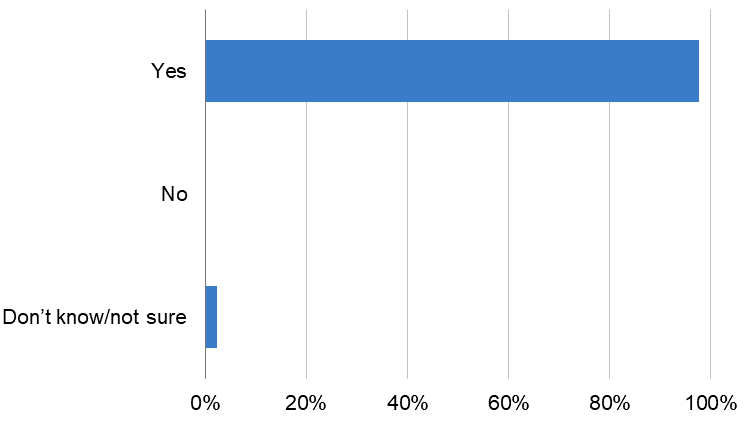
| Answer | Frequency | Percentage |
| Yes | 729 | 97.72% |
| No | 0 | 0.00% |
| Don’t know/not sure | 17 | 2.28% |
Figure 57 - Please indicate the primary state or territory in which your department is located. (Q2)
| Answer | Frequency | Percentage |
| California | 57 | 7.64% |
| New York | 56 | 7.51% |
| Illinois | 51 | 6.84% |
| Ohio | 39 | 5.23% |
| Texas | 38 | 5.09% |
| Massachusetts | 33 | 4.42% |
| Pennsylvania | 30 | 4.02% |
| Georgia | 25 | 3.35% |
| Wisconsin | 24 | 3.22% |
| Virginia | 23 | 3.08% |
| Colorado | 21 | 2.82% |
| Michigan | 21 | 2.82% |
| North Carolina | 19 | 2.55% |
| Indiana | 18 | 2.41% |
| Connecticut | 15 | 2.01% |
| Florida | 15 | 2.01% |
| Maryland | 15 | 2.01% |
| Missouri | 15 | 2.01% |
| New Jersey | 15 | 2.01% |
| Washington | 15 | 2.01% |
| Minnesota | 14 | 1.88% |
| District of Columbia | 13 | 1.74% |
| Kentucky | 13 | 1.74% |
| South Carolina | 13 | 1.74% |
| Kansas | 12 | 1.61% |
| Tennessee | 12 | 1.61% |
| Oklahoma | 9 | 1.21% |
| Arizona | 8 | 1.07% |
| Louisiana | 8 | 1.07% |
| New Mexico | 8 | 1.07% |
| Iowa | 7 | 0.94% |
| Maine | 7 | 0.94% |
| Nebraska | 7 | 0.94% |
| Nevada | 7 | 0.94% |
| Oregon | 7 | 0.94% |
| Rhode Island | 6 | 0.80% |
| Vermont | 6 | 0.80% |
| Montana | 5 | 0.67% |
| Utah | 5 | 0.67% |
| Wyoming | 5 | 0.67% |
| Alabama | 4 | 0.54% |
| New Hampshire | 4 | 0.54% |
| South Dakota | 4 | 0.54% |
| Alaska | 3 | 0.40% |
| Arkansas | 3 | 0.40% |
| Mississippi | 3 | 0.40% |
| North Dakota | 3 | 0.40% |
| Hawaii | 2 | 0.27% |
| Idaho | 1 | 0.13% |
| Puerto Rico | 1 | 0.13% |
| West Virginia | 1 | 0.13% |
| American Samoa | 0 | 0.00% |
| Delaware | 0 | 0.00% |
| Guam | 0 | 0.00% |
| Virgin Islands | 0 | 0.00% |
| My department is not located in a US state or territory | 0 | 0.00% |
Figure 58 - Do you have primary responsibility for, or give significant input on, making major decisions in your department with respect to the following items? (Q3)
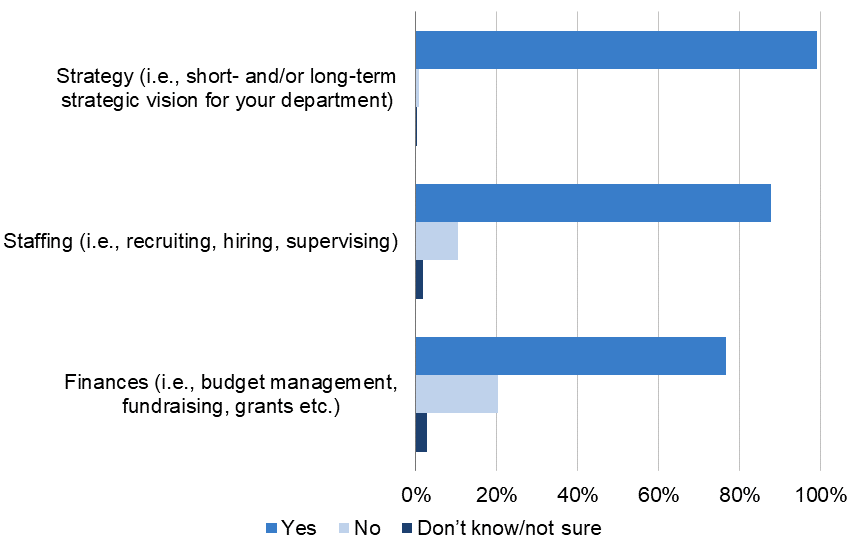
| Strategy (i.e., short- and/or long-term strategic vision for your department) | Staffing (i.e., recruiting, hiring, supervising) | Finances (i.e., budget management, fundraising, grants etc.) | ||||
| Answer | Frequency | Percentage | Frequency | Percentage | Frequency | Percentage |
| Yes | 99.20% | 740 | 87.80% | 655 | 76.81% | 573 |
| No | 0.67% | 5 | 10.46% | 78 | 20.38% | 152 |
| Don’t know/ not sure | 0.13% | 1 | 1.74% | 13 | 2.82% | 21 |
Figure 59 - Which of the following best describes the sector of your archives? (Q4)
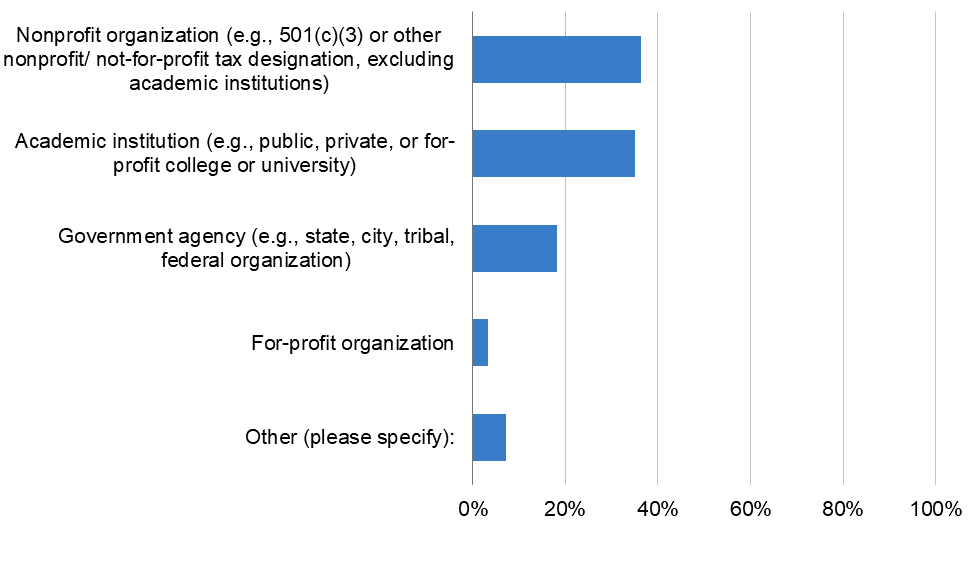
| Answer | Frequency | Percentage |
| Nonprofit organization (e.g., 501(c)(3) or other nonprofit/ not-for-profit tax designation, excluding academic institutions) | 270 | 36.29% |
| Academic institution (e.g., public, private, or for-profit college or university) | 260 | 34.95% |
| Government agency (e.g., state, city, tribal, federal organization) | 136 | 18.28% |
| For-profit organization | 24 | 3.23% |
| Other (please specify): | 54 | 7.26% |
Figure 60 - Is your archives department or organization a community archives? (NOTE: “Community archives” is defined as documentation of a group of people that share common interests, and social, cultural and historical heritage, usually created by members of the group being documented and maintained outside of traditional archives.) (Q5)
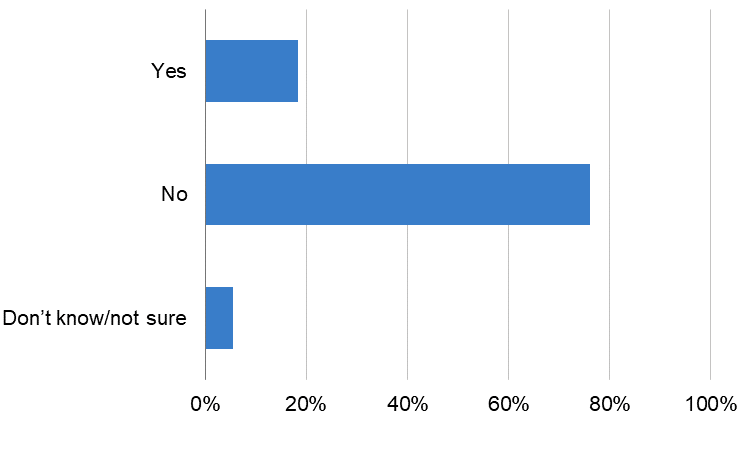
| Answer | Frequency | Percentage |
| Yes | 137 | 18.41% |
| No | 566 | 76.08% |
| Don’t know/not sure | 41 | 5.51% |
Figure 61 - Is your department positioned within a larger institution? (Q6)
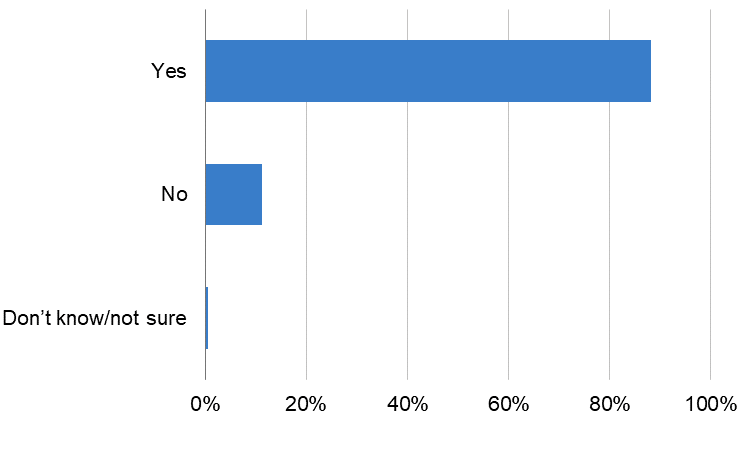
| Answer | Frequency | Percentage |
| Yes | 658 | 88.20% |
| No | 84 | 11.26% |
| Don’t know/not sure | 4 | 0.54% |
Figure 62 - In what way(s) are the collections in your department publicly discoverable? Please select all that apply. (NOTE: A “finding aid” is a description that typically consists of contextual and structural information about an archival resource.) (Q7)
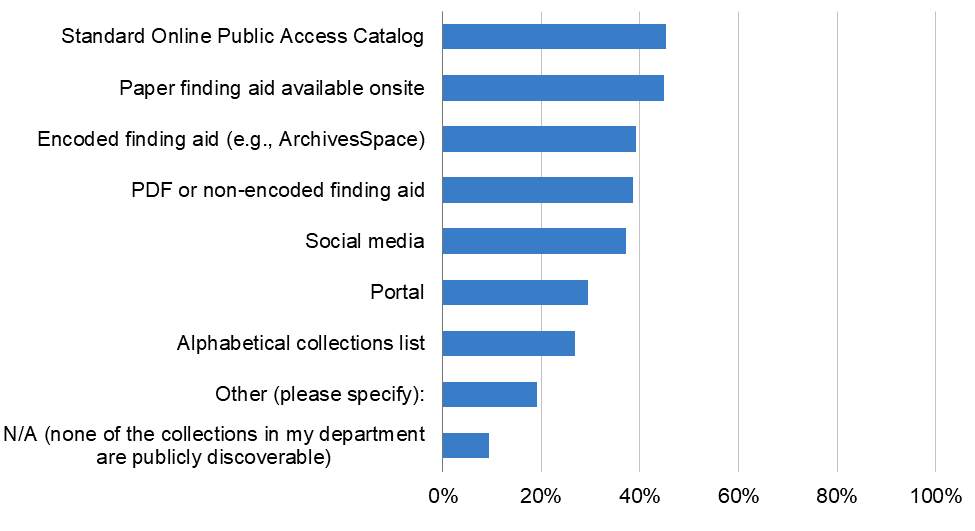
| Answer | Frequency | Percentage |
| Standard Online Public Access Catalog | 338 | 45.37% |
| Paper finding aid available onsite | 335 | 44.97% |
| Encoded finding aid (e.g., ArchivesSpace) | 292 | 39.19% |
| PDF or non-encoded finding aid | 287 | 38.52% |
| Social media | 277 | 37.18% |
| Portal | 219 | 29.40% |
| Alphabetical collections list | 200 | 26.85% |
| Other (please specify): | 142 | 19.06% |
| N/A (none of the collections in my department are publicly discoverable) | 70 | 9.40% |
Figure 63 - What percentage of the collections in your department are publicly discoverable online (e.g., can be found through websites, portals, social media, etc.)? (Q8)
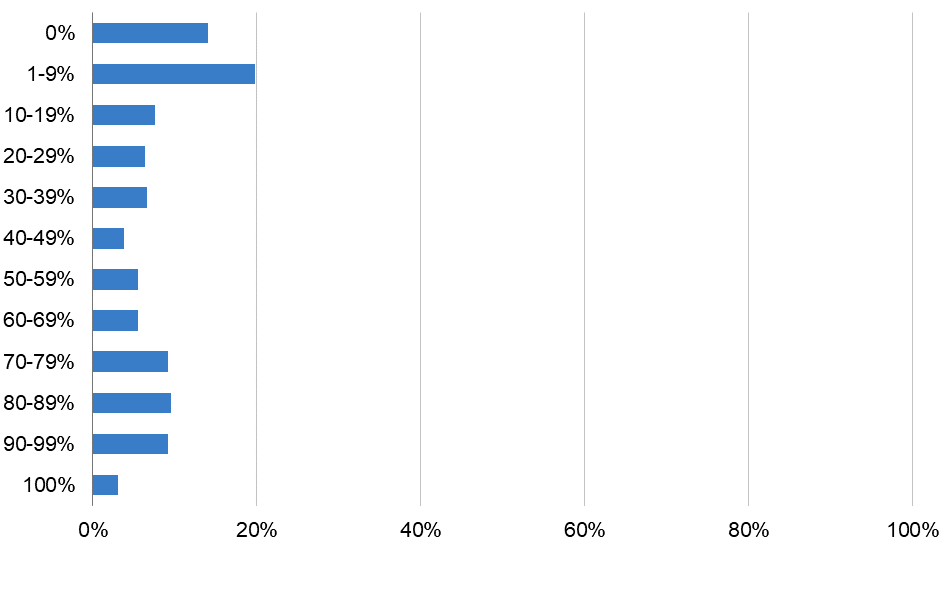
| Answer | Frequency | Percentage |
| 0% | 105 | 14.11% |
| 1-9% | 147 | 19.76% |
| 10-19% | 56 | 7.53% |
| 20-29% | 47 | 6.32% |
| 30-39% | 49 | 6.59% |
| 40-49% | 28 | 3.76% |
| 50-59% | 41 | 5.51% |
| 60-69% | 41 | 5.51% |
| 70-79% | 68 | 9.14% |
| 80-89% | 71 | 9.54% |
| 90-99% | 68 | 9.14% |
| 100% | 23 | 3.09% |
Figure 64 - What metric do you use to measure the physical archives collections in your department? Please select all that apply. (Q9)
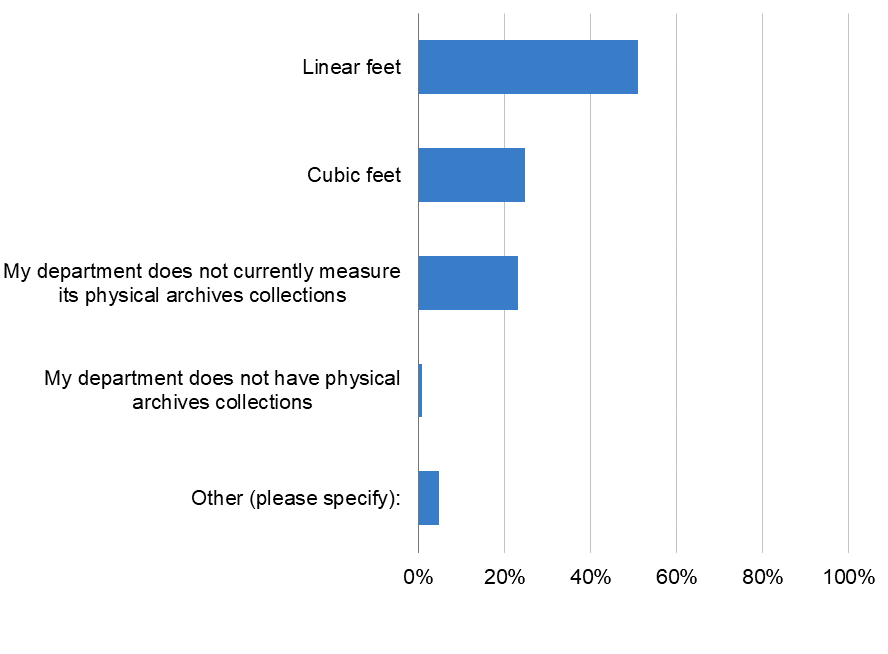
| Answer | Frequency | Percentage |
| Linear feet | 380 | 51.14% |
| Cubic feet | 184 | 24.76% |
| My department does not currently measure its physical archives collections | 173 | 23.28% |
| My department does not have physical archives collections | 6 | 0.81% |
| Other (please specify): | 36 | 4.85% |
Figure 65 - How many linear feet of physical archives collections are in your department? (Q10)
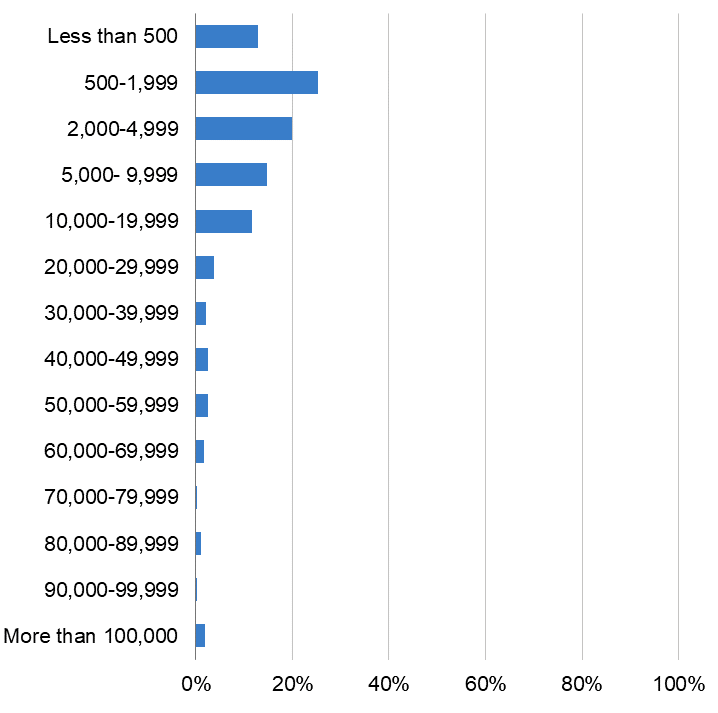
| Answer | Frequency | Percentage |
| Less than 500 | 48 | 12.87% |
| 500-1,999 | 94 | 25.20% |
| 2,000-4,999 | 74 | 19.84% |
| 5,000- 9,999 | 55 | 14.75% |
| 10,000-19,999 | 43 | 11.53% |
| 20,000-29,999 | 14 | 3.75% |
| 30,000-39,999 | 8 | 2.14% |
| 40,000-49,999 | 9 | 2.41% |
| 50,000-59,999 | 9 | 2.41% |
| 60,000-69,999 | 6 | 1.61% |
| 70,000-79,999 | 1 | 0.27% |
| 80,000-89,999 | 4 | 1.07% |
| 90,000-99,999 | 1 | 0.27% |
| More than 100,000 | 7 | 1.88% |
Figure 66 - On average, how many linear feet of physical archives collections (including rare books) are accessioned in your department? If your department does not collect these metrics, please leave this question blank. (Q11a)
| Min Answer | Max Answer | Median Answer | Count |
| 1 | 120,000 | 100 | 222 |
Figure 67 - On average, how many linear feet of physical archives collections (including rare books) are deaccessioned in your department? If your department does not collect these metrics, please leave this question blank. (Q11b)
| Min Answer | Max Answer | Median Answer | Count |
| 0 | 1,200 | <0.1 | 196 |
Figure 68 - How many cubic feet of physical archives collections are in your department? (Q12)
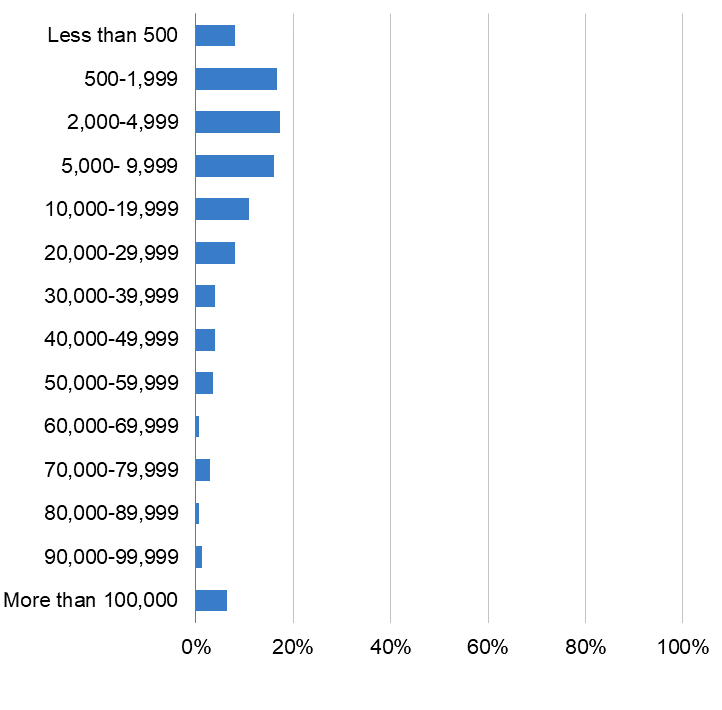
| Answer | Frequency | Percentage |
| Less than 500 | 14 | 8.05% |
| 500-1,999 | 29 | 16.67% |
| 2,000-4,999 | 30 | 17.24% |
| 5,000- 9,999 | 28 | 16.09% |
| 10,000-19,999 | 19 | 10.92% |
| 20,000-29,999 | 14 | 8.05% |
| 30,000-39,999 | 7 | 4.02% |
| 40,000-49,999 | 7 | 4.02% |
| 50,000-59,999 | 6 | 3.45% |
| 60,000-69,999 | 1 | 0.57% |
| 70,000-79,999 | 5 | 2.87% |
| 80,000-89,999 | 1 | 0.57% |
| 90,000-99,999 | 2 | 1.15% |
| More than 100,000 | 11 | 6.32% |
Figure 69 - On average, how many cubic feet of physical archives collections (including rare books) are accessioned in your department? If your department does not collect these metrics, please leave this question blank. (Q13a)
| Min Answer | Max Answer | Median Answer | Count |
| 1 | 3,000,000 | 300 | 110 |
Figure 70 - On average, how many cubic feet of physical archives collections (including rare books) are deaccessioned in your department? If your department does not collect these metrics, please leave this question blank. (Q13b)
| Min Answer | Max Answer | Median Answer | Count |
| 0 | 1,500 | 2 | 95 |
Figure 71 - What is the total amount of digital archives collections in your department? (Q14)
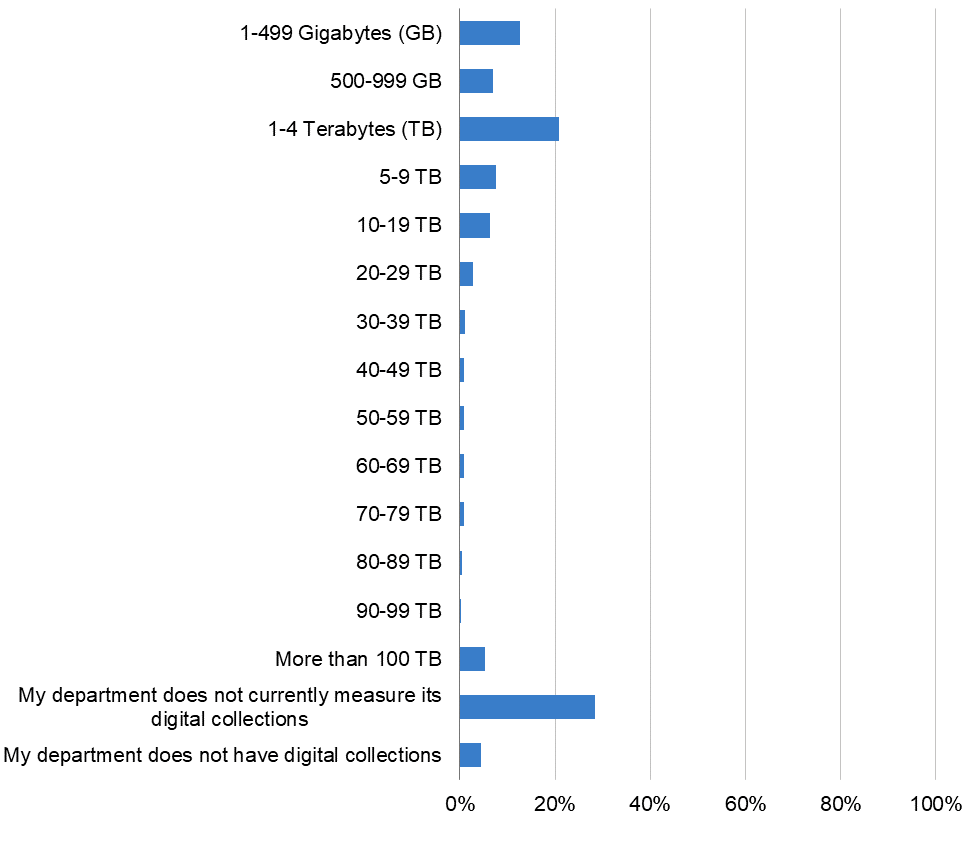
| Answer | Frequency | Percentage |
| 1-499 Gigabytes (GB) | 93 | 12.60% |
| 500-999 GB | 51 | 6.91% |
| 1-4 Terabytes (TB) | 154 | 20.87% |
| 5-9 TB | 56 | 7.59% |
| 10-19 TB | 46 | 6.23% |
| 20-29 TB | 20 | 2.71% |
| 30-39 TB | 8 | 1.08% |
| 40-49 TB | 7 | 0.95% |
| 50-59 TB | 6 | 0.81% |
| 60-69 TB | 6 | 0.81% |
| 70-79 TB | 6 | 0.81% |
| 80-89 TB | 3 | 0.41% |
| 90-99 TB | 2 | 0.27% |
| More than 100 TB | 39 | 5.28% |
| My department does not currently measure its digital collections | 209 | 28.32% |
| My department does not have digital collections | 32 | 4.34% |
Figure 72 - What are the main considerations in your department for accepting new archives collections? Please select up to five items. (Q15)
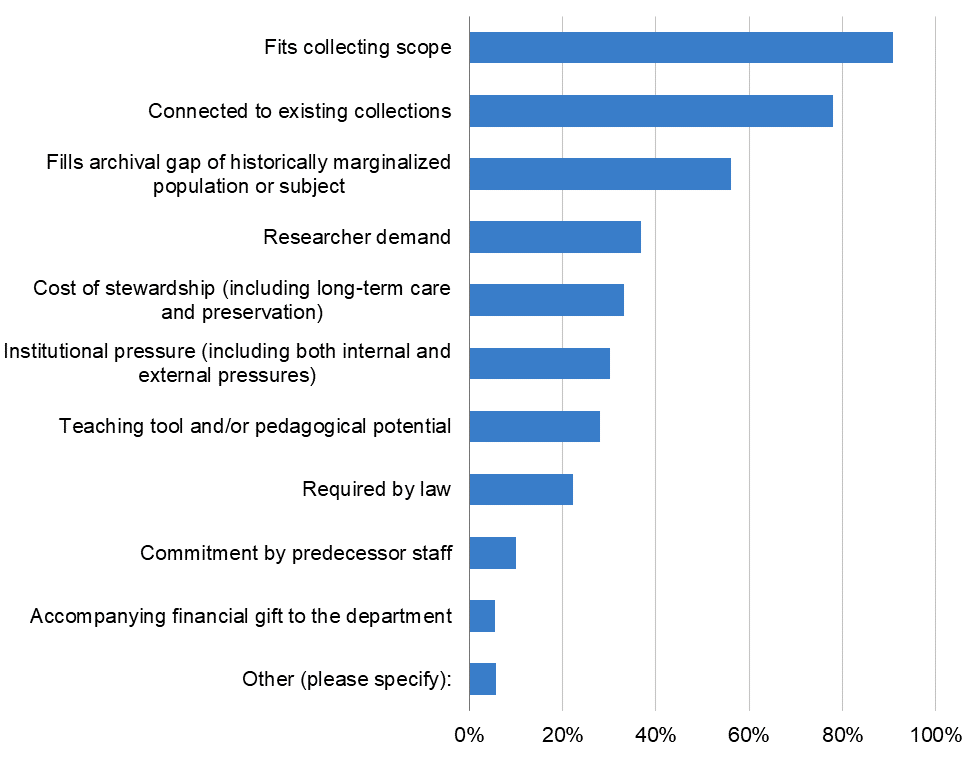
| Answer | Frequency | Percentage |
| Fits collecting scope | 675 | 90.85% |
| Connected to existing collections | 580 | 78.06% |
| Fills archival gap of historically marginalized population or subject | 417 | 56.12% |
| Researcher demand | 274 | 36.88% |
| Cost of stewardship (including long-term care and preservation) | 247 | 33.24% |
| Institutional pressure (including both internal and external pressures) | 224 | 30.15% |
| Teaching tool and/or pedagogical potential | 209 | 28.13% |
| Required by law | 165 | 22.21% |
| Commitment by predecessor staff | 74 | 9.96% |
| Accompanying financial gift to the department | 41 | 5.52% |
| Other (please specify): | 43 | 5.79% |
Figure 73 - In 2019, how many of the following did your department receive? If your department did not collect these metrics, please leave this question blank. (Q16)
| Answer | Min Answer | Max Answer | Median Answer | Count |
| In-person visitors | 0 | 78,712 | 178 | 385 |
| Distance reference requests | 0 | 1,287,875 | 173.5 | 364 |
| Unique website visits | 0 | 39,555,030 | 9,608 | 129 |
| Internal requests | 0 | 53,000 | 80 | 215 |
Figure 74 - In 2021, how many of the following did your department receive? If your department did not collect these metrics, please leave this question blank. (Q17)
| Answer | Min Answer | Max Answer | Median Answer | Count |
| In-person visitors | 0 | 65,000 | 27 | 407 |
| Distance reference requests | 0 | 498,896 | 157 | 394 |
| Unique website visits | 0 | 53,333,700 | 10,381 | 132 |
| Internal requests | 0 | 40,200 | 61 | 247 |
Figure 75 - What channels does your department use to solicit feedback from the communities and stakeholders it serves? Select all that apply. (Q18)
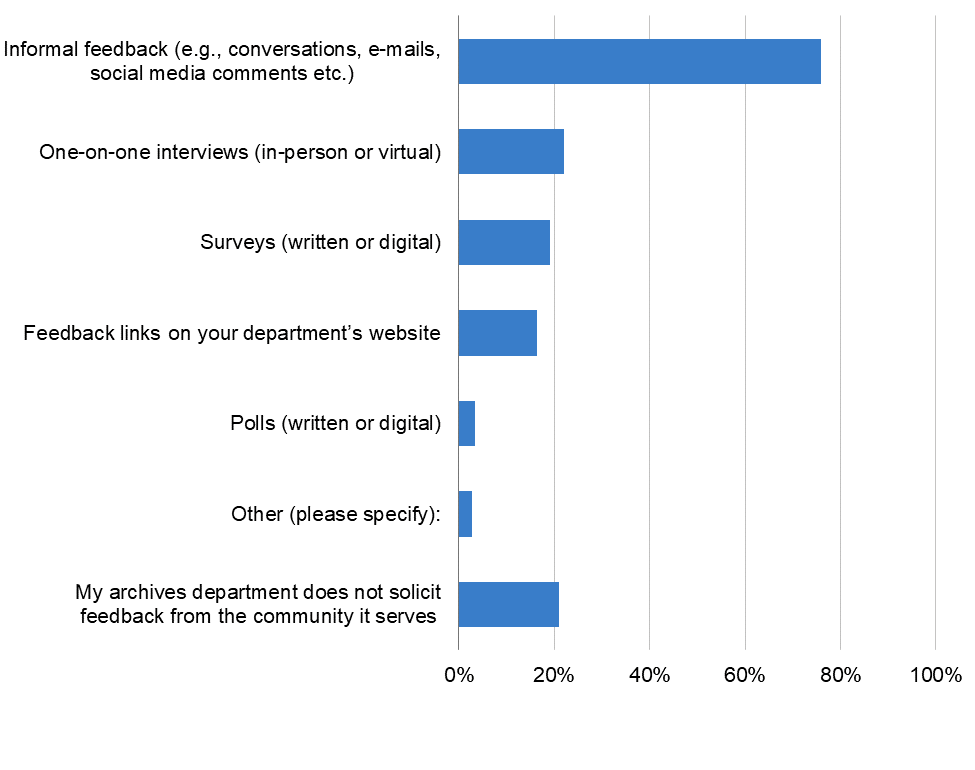
| Answer | Frequency | Percentage |
| Informal feedback (e.g., conversations, e-mails, social media comments etc.) | 562 | 75.95% |
| One-on-one interviews (in-person or virtual) | 163 | 22.03% |
| Surveys (written or digital) | 142 | 19.19% |
| Feedback links on your department’s website | 121 | 16.35% |
| Polls (written or digital) | 26 | 3.51% |
| Other (please specify): | 20 | 2.70% |
| My archives department does not solicit feedback from the community it serves | 155 | 20.95% |
Figure 76 - How many FTE (full-time equivalent) staff are in your department? (NOTE: “Full-time equivalent” is defined as staff hours adding up to a full-time position, regardless of the number of specific staff members. For example, two staff members that work 20 hours per week are equivalent to one full-time staff member (i.e., one FTE).) (Q19)
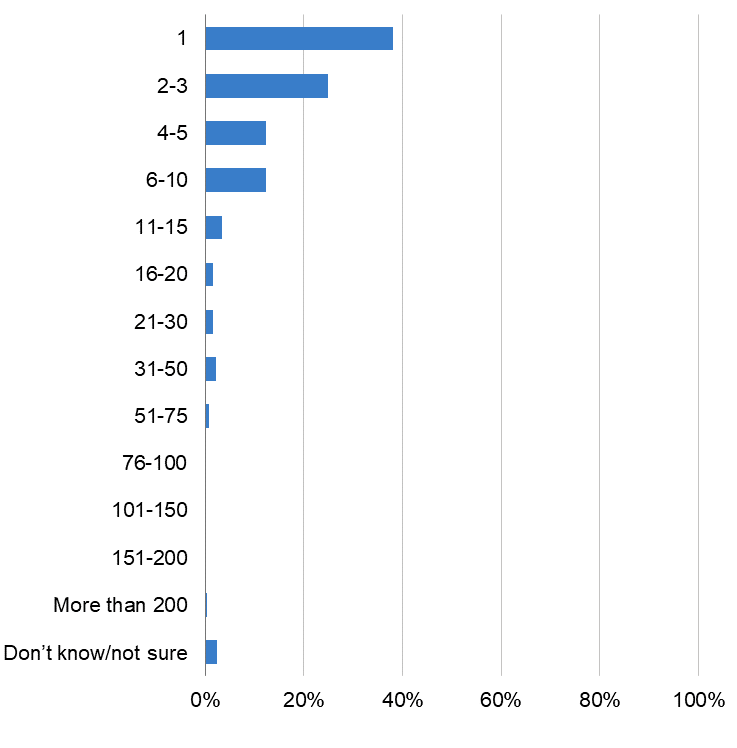
| Answer | Frequency | Percentage |
| 1 | 274 | 38.06% |
| 2-3 | 180 | 25.00% |
| 4-5 | 89 | 12.36% |
| 6-10 | 89 | 12.36% |
| 11-15 | 24 | 3.33% |
| 16-20 | 11 | 1.53% |
| 21-30 | 11 | 1.53% |
| 31-50 | 16 | 2.22% |
| 51-75 | 6 | 0.83% |
| 76-100 | 0 | 0.00% |
| 101-150 | 1 | 0.14% |
| 151-200 | 0 | 0.00% |
| More than 200 | 2 | 0.28% |
| Don’t know/not sure | 17 | 2.36% |
Figure 77 - Which of the following staff pay types does your department have? Please select all that apply. (Q20)
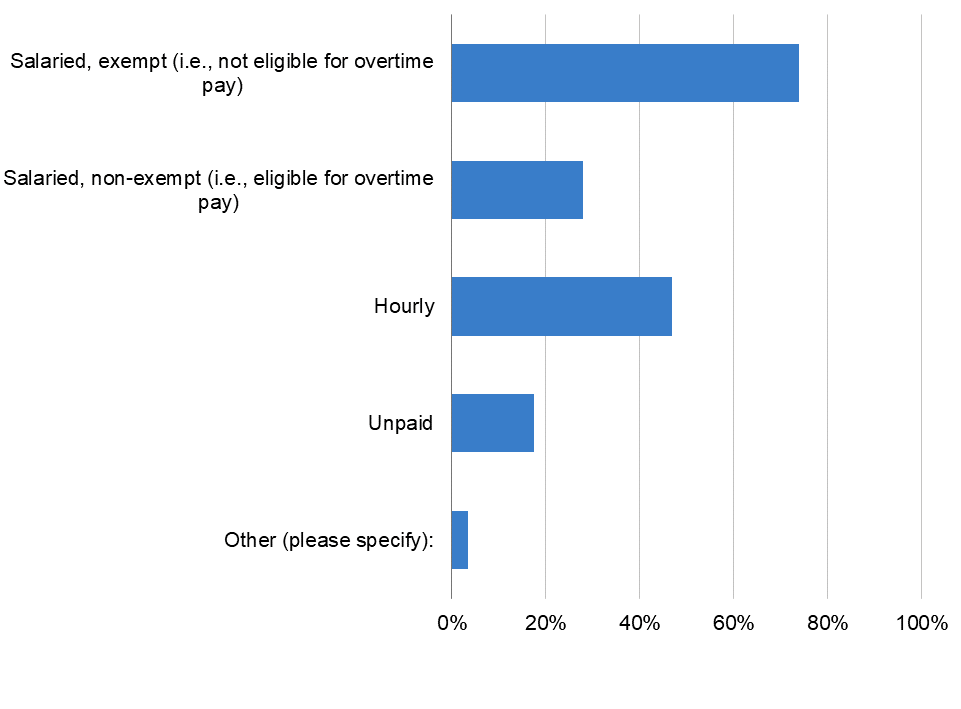
| Answer | Frequency | Percentage |
| Salaried, exempt (i.e., not eligible for overtime pay) | 547 | 73.92% |
| Salaried, non-exempt (i.e., eligible for overtime pay) | 207 | 27.97% |
| Hourly | 346 | 46.76% |
| Unpaid | 129 | 17.43% |
| Other (please specify): | 25 | 3.38% |
Figure 78 - Which of the following staff types does your department have? Please select all that apply. (Q21)
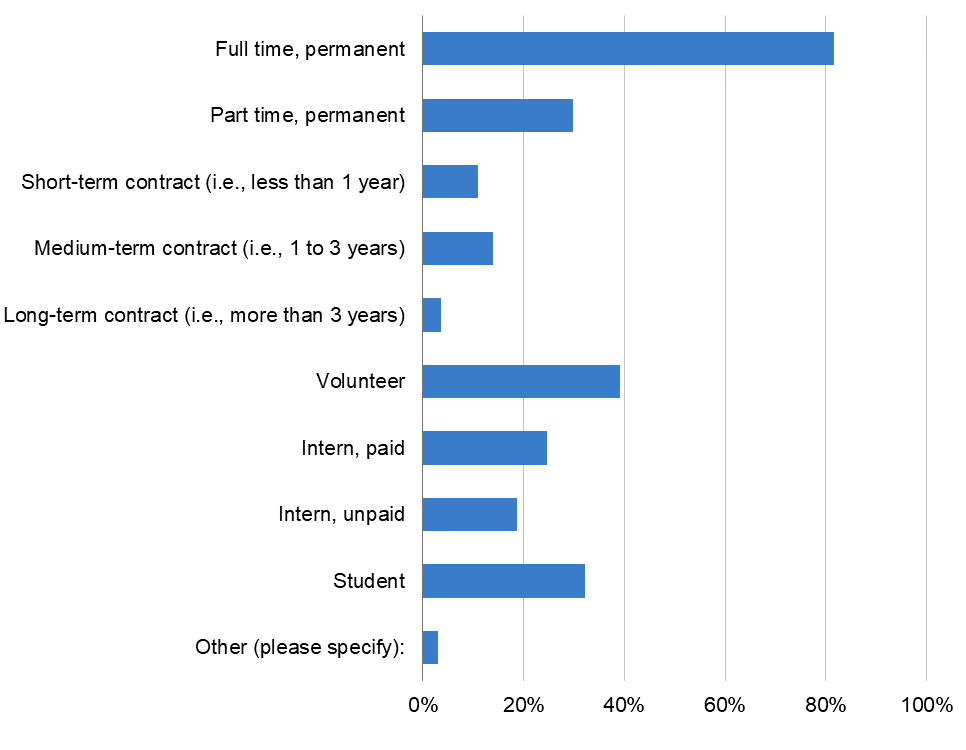
| Answer | Frequency | Percentage |
| Full time, permanent | 604 | 81.62% |
| Part time, permanent | 221 | 29.86% |
| Short-term contract (i.e., less than 1 year) | 81 | 10.95% |
| Medium-term contract (i.e., 1 to 3 years) | 103 | 13.92% |
| Long-term contract (i.e., more than 3 years) | 27 | 3.65% |
| Volunteer | 290 | 39.19% |
| Intern, paid | 183 | 24.73% |
| Intern, unpaid | 138 | 18.65% |
| Student | 238 | 32.16% |
| Other (please specify): | 23 | 3.11% |
Figure 79 - How many FTE (full-time equivalent) staff are in each of the following staff types in your department? (NOTE: “Full-time equivalent” is defined as staff hours adding up to a full-time position, regardless of the number of specific staff members. For example, two staff members that work 20 hours per week are equivalent to one full-time staff member (i.e., one FTE).) (Q22)
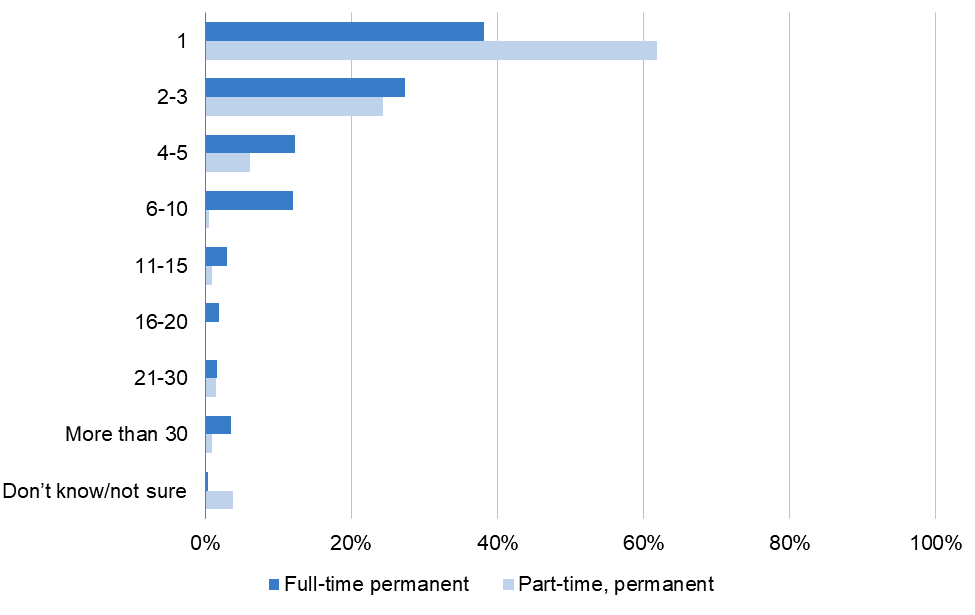
| Full-time, permanent | Part-time, permanent | |||
| Answer | Frequency | Percentage | Frequency | Percentage |
| 1 | 229 | 38.10% | 130 | 61.90% |
| 2-3 | 164 | 27.29% | 51 | 24.29% |
| 4-5 | 74 | 12.31% | 13 | 6.19% |
| 6-10 | 72 | 11.98% | 1 | 0.48% |
| 11-15 | 18 | 3.00% | 2 | 0.95% |
| 16-20 | 11 | 1.83% | 0 | 0.00% |
| 21-30 | 10 | 1.66% | 3 | 1.43% |
| More than 30 | 21 | 3.49% | 2 | 0.95% |
| Don’t know/not sure | 2 | 0.33% | 8 | 3.81% |
Figure 80 - Q22 Continued
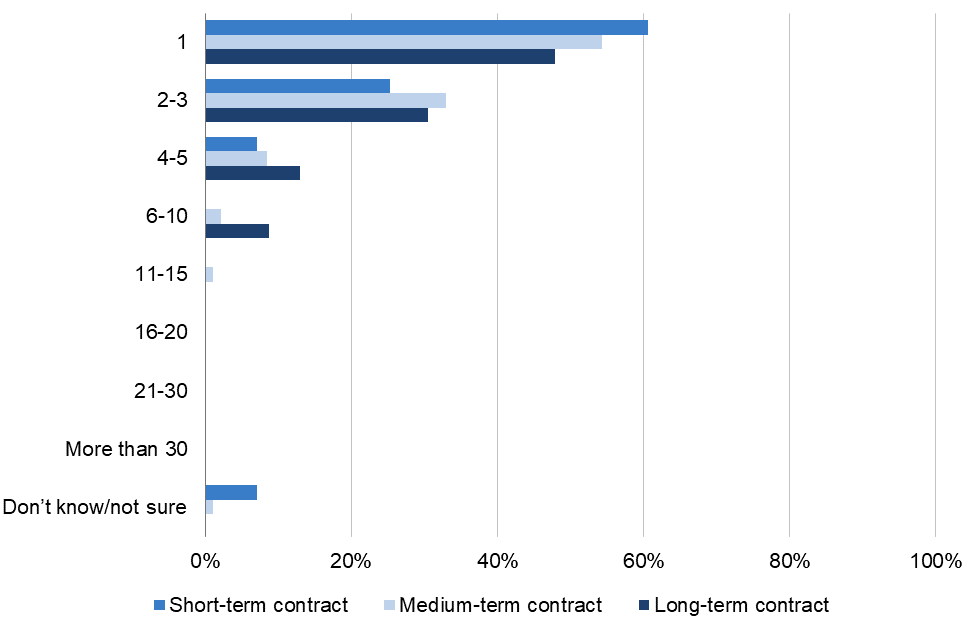
| Short-term contract | Medium-term contract | Long-term contract | ||||
| Answer | Frequency | Percentage | Frequency | Percentage | Frequency | Percentage |
| 1 | 43 | 60.56% | 51 | 54.26% | 11 | 47.83% |
| 2-3 | 18 | 25.35% | 31 | 32.98% | 7 | 30.43% |
| 4-5 | 5 | 7.04% | 8 | 8.51% | 3 | 13.04% |
| 6-10 | 0 | 0.00% | 2 | 2.13% | 2 | 8.70% |
| 11-15 | 0 | 0.00% | 1 | 1.06% | 0 | 0.00% |
| 16-20 | 0 | 0.00% | 0 | 0.00% | 0 | 0.00% |
| 21-30 | 0 | 0.00% | 0 | 0.00% | 0 | 0.00% |
| More than 30 | 0 | 0.00% | 0 | 0.00% | 0 | 0.00% |
| Don’t know/not sure | 5 | 7.04% | 1 | 1.06% | 0 | 0.00% |
Figure 81 - Q22 Continued
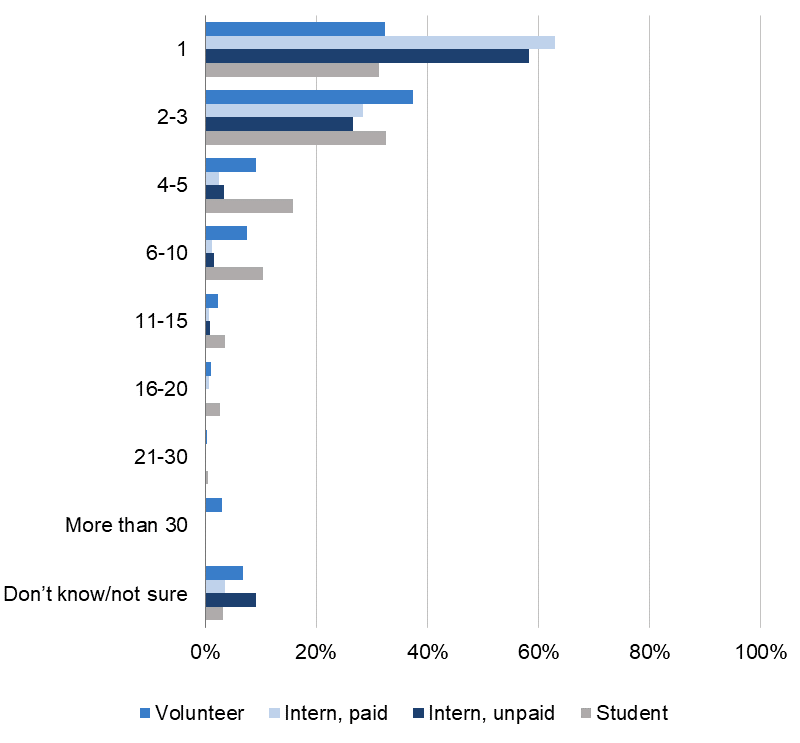
| Volunteer | Intern, paid | Intern, unpaid | Student | |||||
| Answer | Frequency | Percentage | Frequency | Percentage | Frequency | Percentage | Frequency | Percentage |
| 1 | 86 | 32.45% | 104 | 63.03% | 70 | 58.33% | 69 | 31.22% |
| 2-3 | 99 | 37.36% | 47 | 28.48% | 32 | 26.67% | 72 | 32.58% |
| 4-5 | 24 | 9.06% | 4 | 2.42% | 4 | 3.33% | 35 | 15.84% |
| 6-10 | 20 | 7.55% | 2 | 1.21% | 2 | 1.67% | 23 | 10.41% |
| 11-15 | 6 | 2.26% | 1 | 0.61% | 1 | 0.83% | 8 | 3.62% |
| 16-20 | 3 | 1.13% | 1 | 0.61% | 0 | 0.00% | 6 | 2.71% |
| 21-30 | 1 | 0.38% | 0 | 0.00% | 0 | 0.00% | 1 | 0.45% |
| More than 30 | 8 | 3.02% | 0 | 0.00% | 0 | 0.00% | 0 | 0.00% |
| Don’t know/not sure | 18 | 6.79% | 6 | 3.64% | 11 | 9.17% | 7 | 3.17% |
Figure 82 - In your current role, how frequently do you spend your time on each of the following activities in a typical week? (Q23)
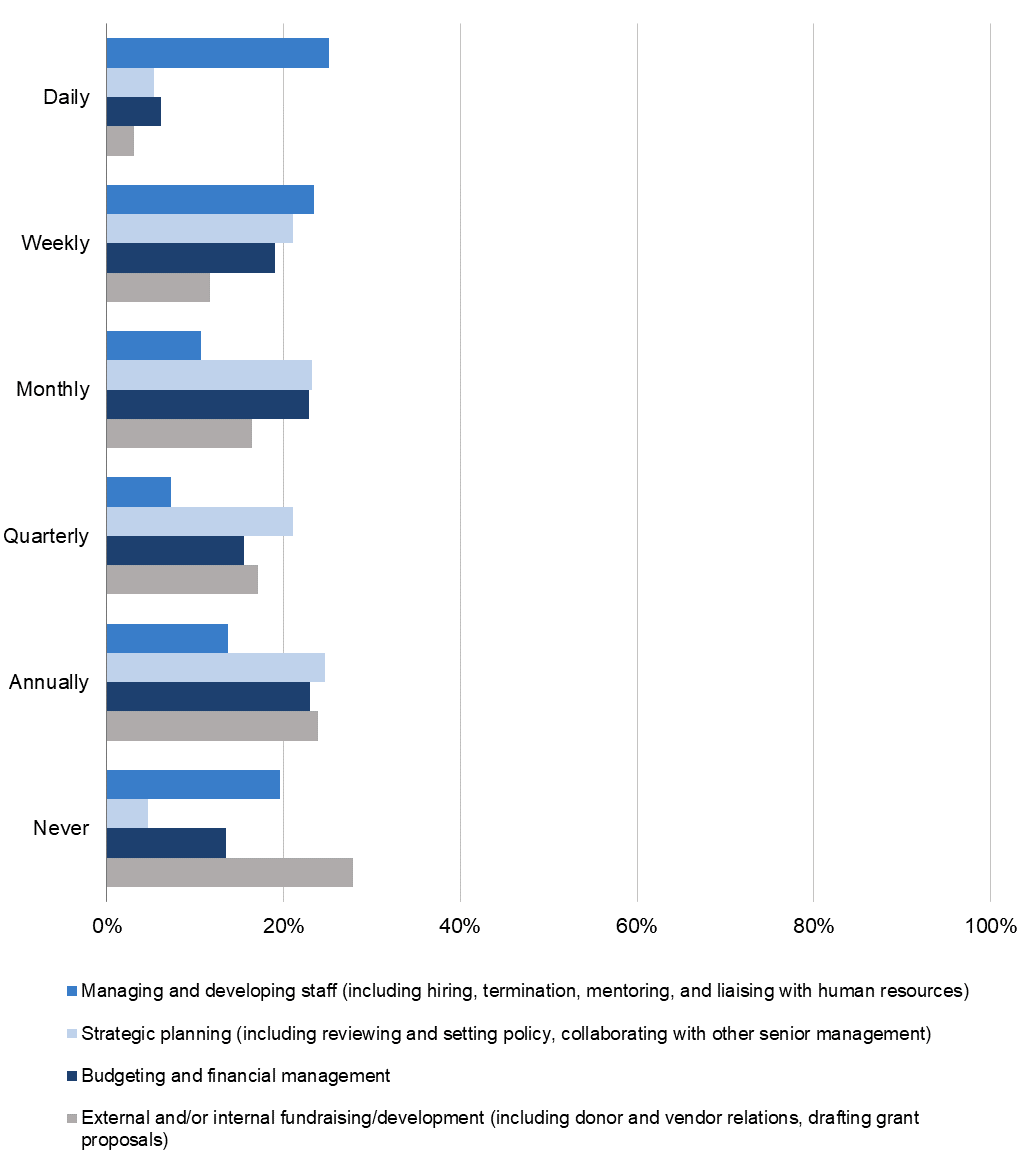
| Daily | Monthly | Annually | Never | |||||
| Answer | Frequency | Percentage | Frequency | Percentage | Frequency | Percentage | Frequency | Percentage |
| Managing and developing staff (including hiring, termination, mentoring, and liaising with human resources) | 186 | 25.20% | 79 | 10.70% | 101 | 13.69% | 145 | 19.65% |
| Strategic planning (including reviewing and setting policy, collaborating with other senior management) | 39 | 5.30% | 171 | 23.23% | 182 | 24.73% | 34 | 4.62% |
| Budgeting and financial management | 45 | 6.12% | 168 | 22.86% | 169 | 22.99% | 99 | 13.47% |
| External and/or internal fundraising/development (including donor and vendor relations, drafting grant proposals) | 23 | 3.12% | 121 | 16.42% | 176 | 23.88% | 205 | 27.82% |
Figure 83 - Q23 Continued
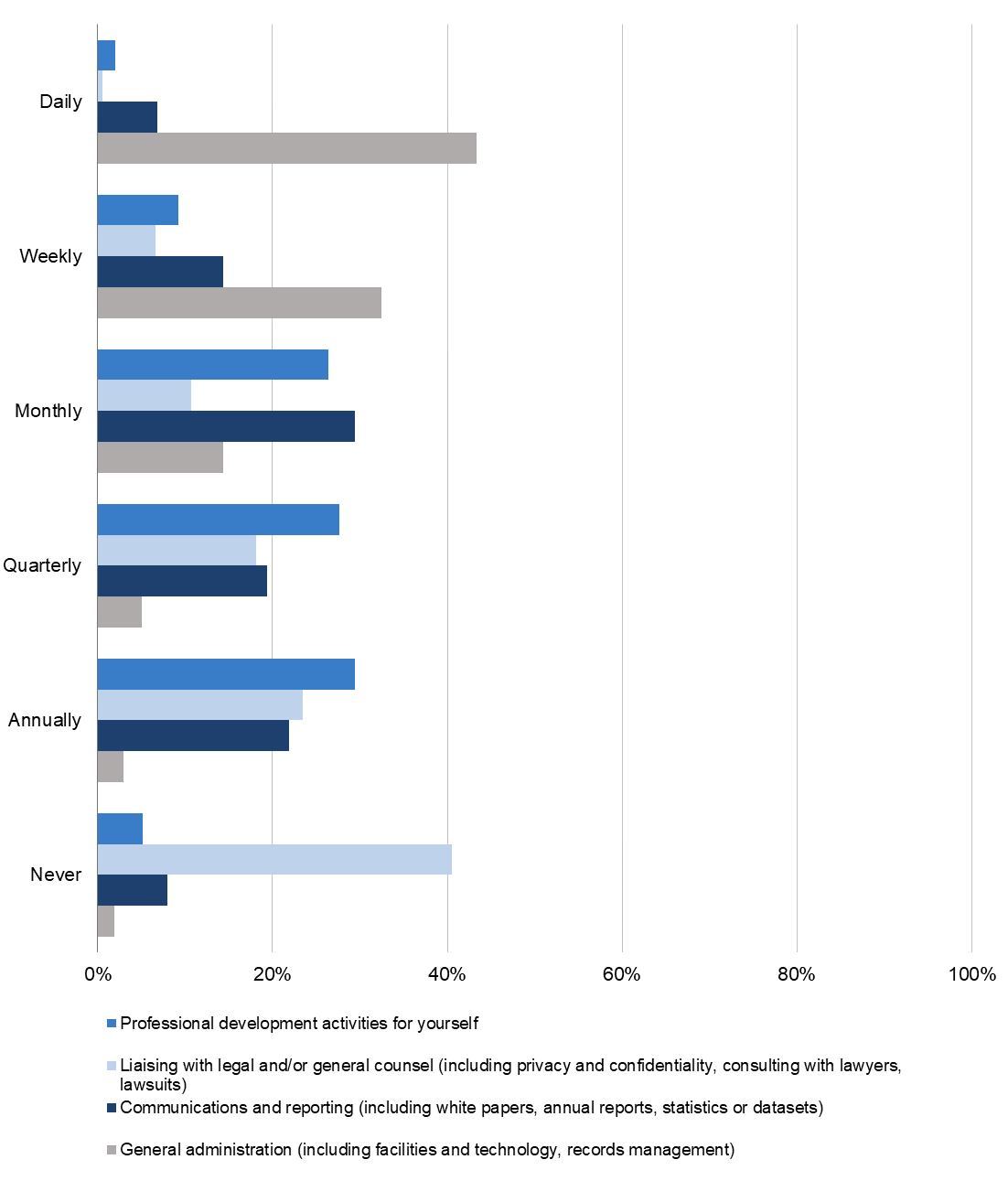
| Daily | Monthly | Annually | Never | |||||
| Answer | Frequency | Percentage | Frequency | Percentage | Frequency | Percentage | Frequency | Percentage |
| Professional development activities for yourself | 15 | 2.04% | 194 | 26.43% | 216 | 29.43% | 38 | 5.18% |
| Liaising with legal and/or general counsel (including privacy and confidentiality, consulting with lawyers, lawsuits) | 4 | 0.54% | 79 | 10.70% | 173 | 23.44% | 299 | 40.51% |
| Communications and reporting (including white papers, annual reports, statistics or datasets) | 50 | 6.79% | 217 | 29.48% | 161 | 21.88% | 59 | 8.02% |
| General administration (including facilities and technology, records management) | 320 | 43.30% | 106 | 14.34% | 22 | 2.98% | 14 | 1.89% |
Figure 84 - Q23 Continued
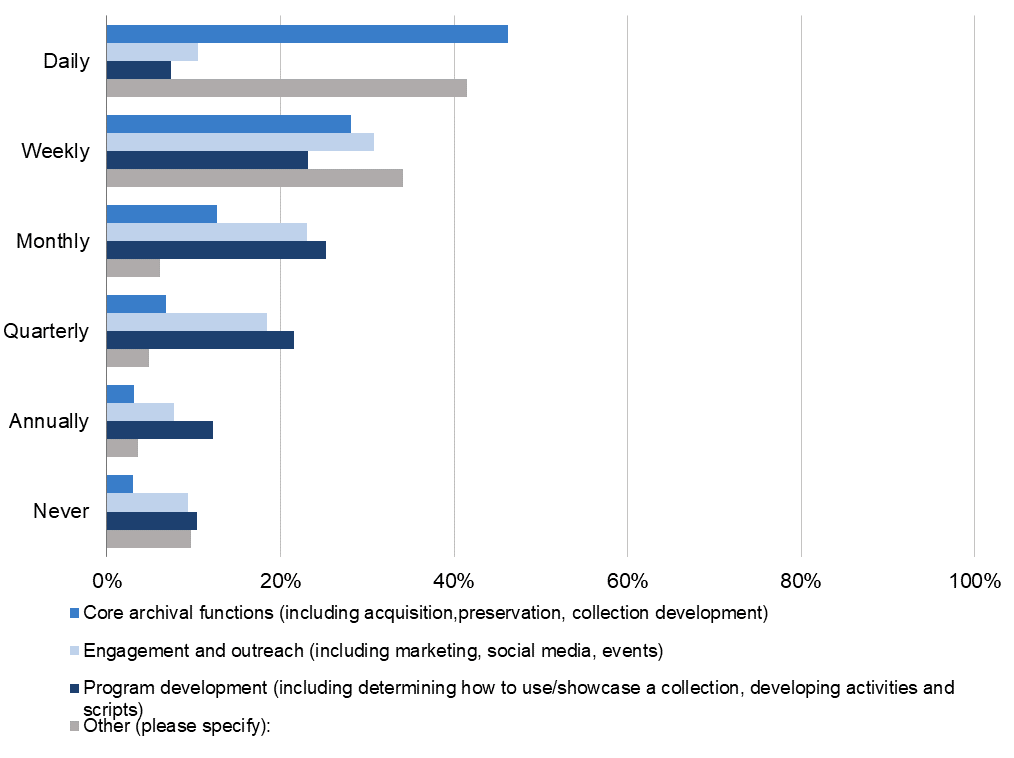
| Daily | Monthly | Annually | Never | |||||
| Answer | Frequency | Percentage | Frequency | Percentage | Frequency | Percentage | Frequency | Percentage |
| Core archival functions (including acquisition, preservation, collection development) | 341 | 46.27% | 94 | 12.75% | 23 | 3.12% | 22 | 2.99% |
| Engagement and outreach (including marketing, social media, events) | 77 | 10.50% | 169 | 23.06% | 57 | 7.78% | 69 | 9.41% |
| Program development (including determining how to use/showcase a collection, developing activities and scripts) | 55 | 7.45% | 186 | 25.20% | 90 | 12.20% | 77 | 10.43% |
| Other (please specify): | 34 | 41.46% | 5 | 6.10% | 3 | 3.66% | 8 | 9.76% |
Figure 85 - Which of the following knowledge, skills, abilities, and competencies have been most valuable for you in your current position? Please select up to five items or leave the question blank if none of these items apply. (Q24)
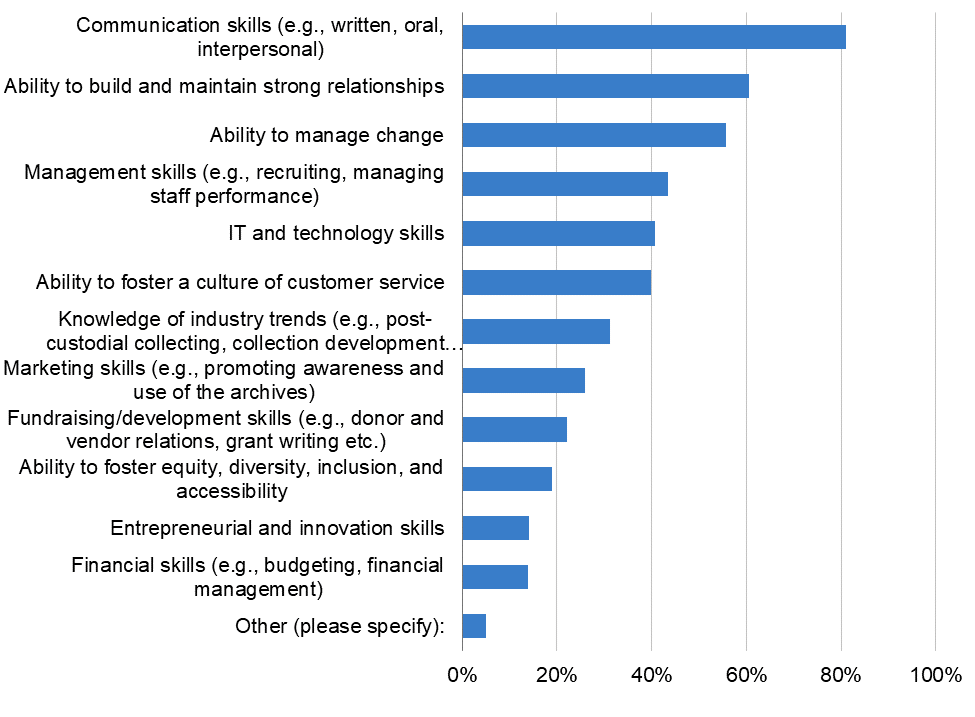
| Answer | Frequency | Percentage |
| Communication skills (e.g., written, oral, interpersonal) | 599 | 81.06% |
| Ability to build and maintain strong relationships | 447 | 60.49% |
| Ability to manage change | 411 | 55.62% |
| Management skills (e.g., recruiting, managing staff performance) | 321 | 43.44% |
| IT and technology skills | 301 | 40.73% |
| Ability to foster a culture of customer service | 294 | 39.78% |
| Knowledge of industry trends (e.g., post-custodial collecting, collection development plans etc.) | 230 | 31.12% |
| Marketing skills (e.g., promoting awareness and use of the archives) | 192 | 25.98% |
| Fundraising/development skills (e.g., donor and vendor relations, grant writing etc.) | 164 | 22.19% |
| Ability to foster equity, diversity, inclusion, and accessibility | 140 | 18.94% |
| Entrepreneurial and innovation skills | 104 | 14.07% |
| Financial skills (e.g., budgeting, financial management) | 102 | 13.80% |
| Other (please specify): | 37 | 5.01% |
Figure 86 - In your best estimation, will your department add or reduce staff positions in the following staff categories over the next five years? For each staff category, please indicate whether you anticipate adding staff positions, making no change, or reducing staff positions. (Q25)
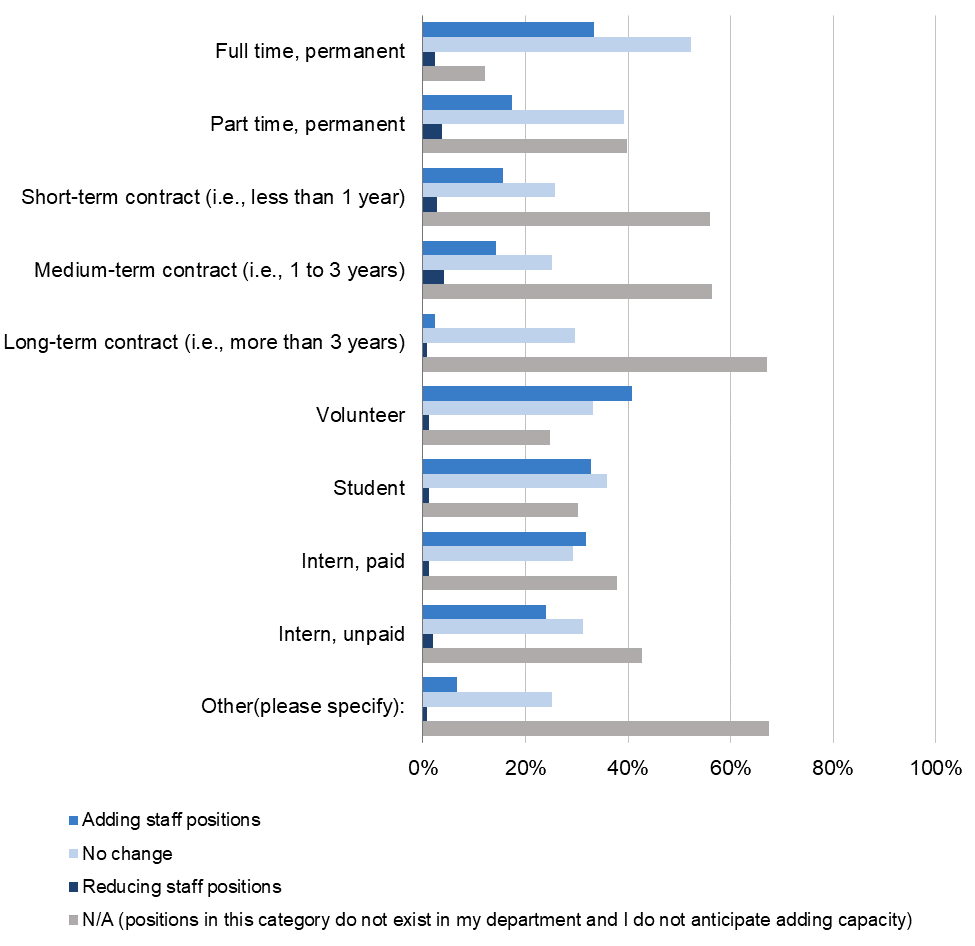
| Reducing staff positions | No change | Adding staff positions | N/A (positions in this category do not exist in my department and I do not anticipate adding capacity) | |||||
| Answer | Frequency | Percentage | Frequency | Percentage | Frequency | Percentage | Frequency | Percentage |
| Full time, permanent | 17 | 2.35% | 378 | 52.21% | 241 | 33.29% | 88 | 12.15% |
| Part time, permanent | 26 | 3.69% | 276 | 39.15% | 123 | 17.45% | 280 | 39.72% |
| Short-term contract (i.e., less than 1 year) | 19 | 2.77% | 177 | 25.76% | 107 | 15.57% | 384 | 55.90% |
| Medium-term contract (i.e., 1 to 3 years) | 28 | 4.09% | 173 | 25.26% | 98 | 14.31% | 386 | 56.35% |
| Long-term contract (i.e., more than 3 years) | 6 | 0.90% | 197 | 29.62% | 16 | 2.41% | 446 | 67.07% |
| Volunteer | 9 | 1.27% | 235 | 33.19% | 288 | 40.68% | 176 | 24.86% |
| Student | 8 | 1.17% | 245 | 35.87% | 224 | 32.80% | 206 | 30.16% |
| Intern, paid | 8 | 1.18% | 198 | 29.25% | 215 | 31.76% | 256 | 37.81% |
| Intern, unpaid | 14 | 2.06% | 212 | 31.27% | 163 | 24.04% | 289 | 42.63% |
| Other (please specify): | 1 | 0.74% | 34 | 25.19% | 9 | 6.67% | 91 | 67.41% |
Figure 87 - How important are the following items in driving hiring decisions in your department? (Q26)
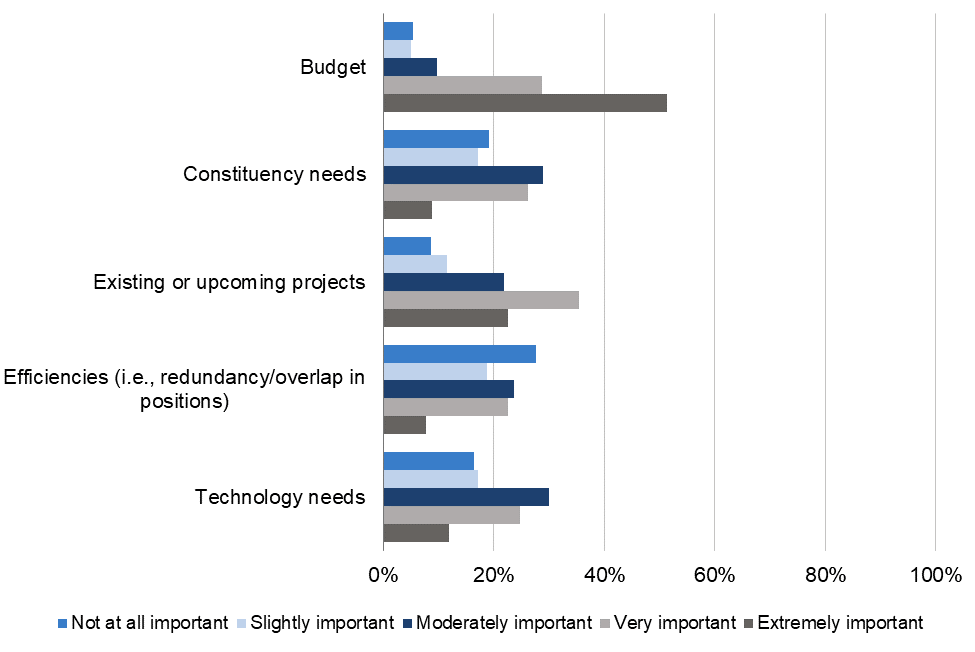
| Not at all important | Moderately important | Extremely important | ||||
| Answer | Frequency | Percentage | Frequency | Percentage | Frequency | Percentage |
| Budget | 39 | 5.43% | 69 | 9.61% | 368 | 51.25% |
| Constituency needs | 135 | 19.15% | 203 | 28.79% | 62 | 8.79% |
| Existing or upcoming projects | 62 | 8.62% | 157 | 21.84% | 162 | 22.53% |
| Efficiencies (i.e., redundancy / overlap in positions) | 193 | 27.53% | 165 | 23.54% | 54 | 7.70% |
| Technology needs | 117 | 16.43% | 213 | 29.92% | 84 | 11.80% |
Figure 88 - Q26 Continued
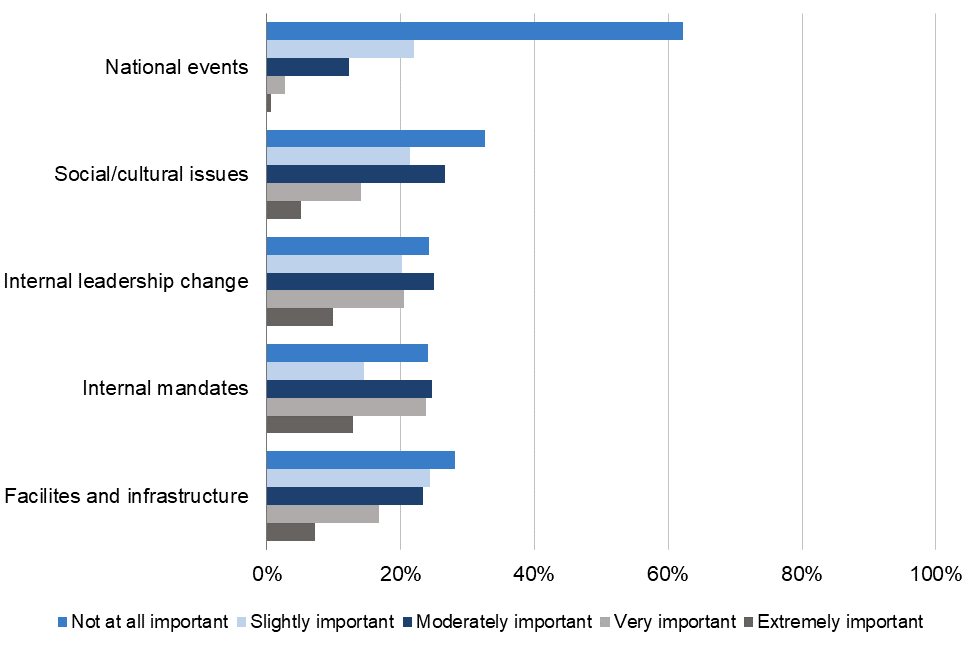
| Not at all important | Moderately important | Extremely important | ||||
| Answer | Frequency | Percentage | Frequency | Percentage | Frequency | Percentage |
| National events | 439 | 62.18% | 87 | 12.32% | 5 | 0.71% |
| Social/cultural issues | 231 | 32.67% | 188 | 26.59% | 36 | 5.09% |
| Internal leadership change | 172 | 24.23% | 178 | 25.07% | 70 | 9.86% |
| Internal mandates | 170 | 24.08% | 174 | 24.65% | 91 | 12.89% |
| Facilities and infrastructure | 200 | 28.21% | 166 | 23.41% | 51 | 7.19% |
Figure 89 - How often does your department extend permanent job offers to staff in impermanent (e.g., contract, intern, student, and/or volunteer) positions? (Q27)
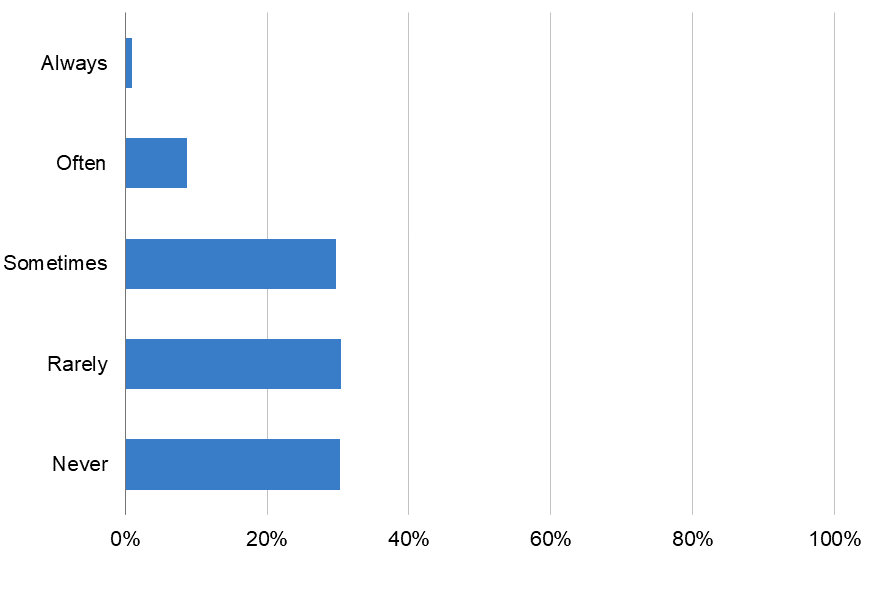
| Answer | Frequency | Percentage |
| Always | 5 | 0.94% |
| Often | 46 | 8.65% |
| Sometimes | 158 | 29.70% |
| Rarely | 162 | 30.45% |
| Never | 161 | 30.26% |
Figure 90 - Generally speaking, how often do you, a hiring manager, a human resources representative, and/or members of a search committee do each of the following when advertising job postings for archives positions? (Q28)
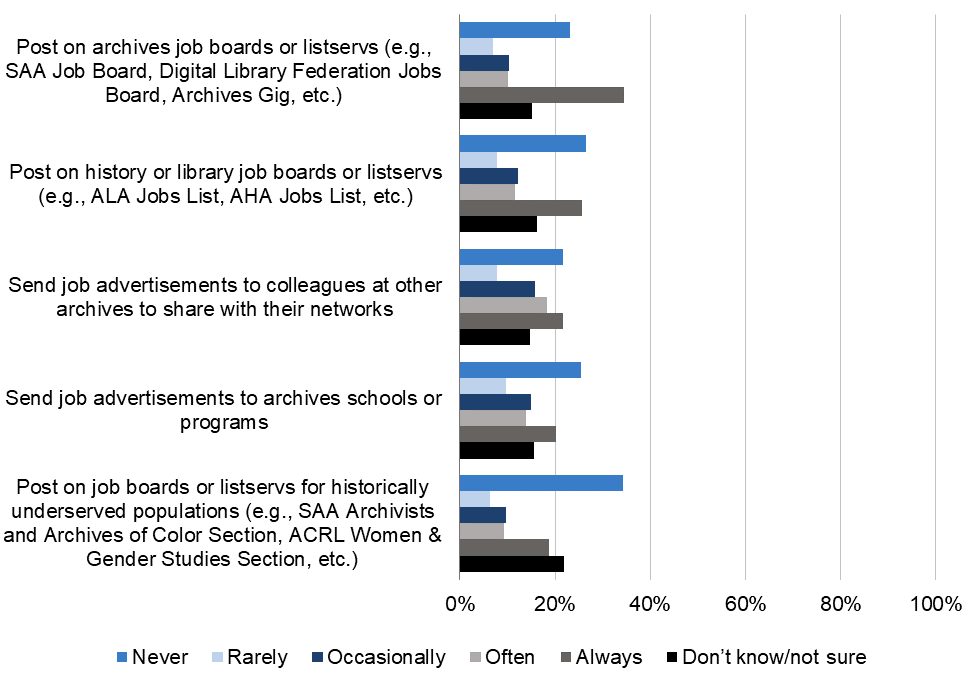
| Never | Occasionally | Always | Don't know/not sure | |||||
| Answer | Frequency | Percentage | Frequency | Percentage | Frequency | Percentage | Frequency | Percentage |
| Post on archives job boards or listservs (e.g., SAA Job Board, Digital Library Federation Jobs Board, Archives Gig, etc.) | 168 | 23.24% | 74 | 10.24% | 249 | 34.44% | 109 | 15.08% |
| Post on history or library job boards or listservs (e.g., ALA Jobs List, AHA Jobs List, etc.) | 192 | 26.52% | 89 | 12.29% | 186 | 25.69% | 117 | 16.16% |
| Send job advertisements to colleagues at other archives to share with their networks | 158 | 21.73% | 114 | 15.68% | 158 | 21.73% | 107 | 14.72% |
| Send job advertisements to archives schools or programs | 184 | 25.38% | 109 | 15.03% | 147 | 20.28% | 113 | 15.59% |
| Post on job boards or listservs for historically underserved populations (e.g., SAA Archivists and Archives of Color Section, ACRL Women & Gender Studies Section, etc.) | 249 | 34.25% | 70 | 9.63% | 136 | 18.71% | 159 | 21.87% |
Figure 91 - Q28 Continued
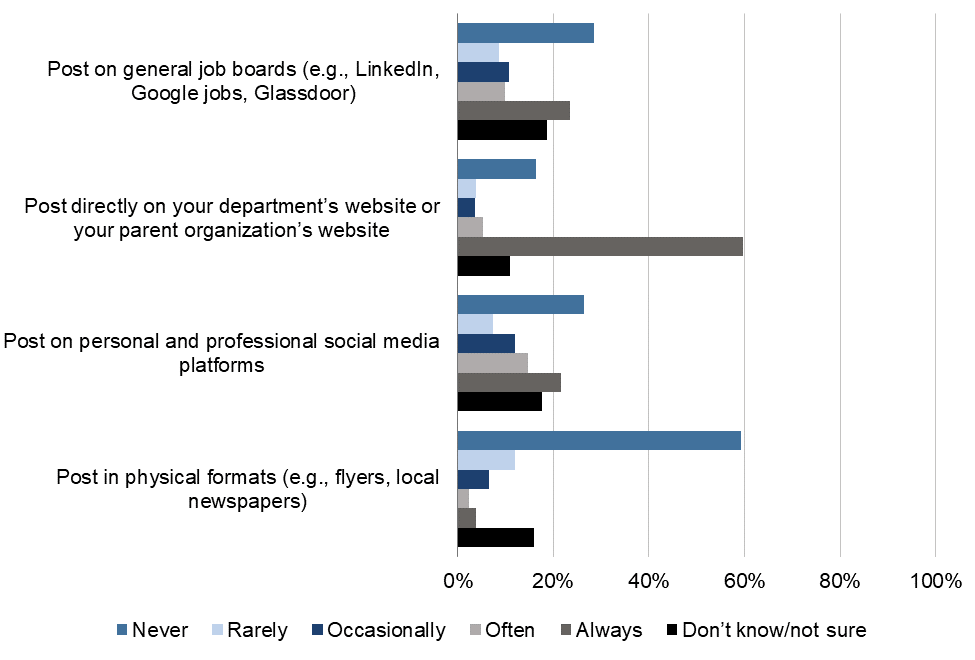
| Never | Occasionally | Always | Don't know/not sure | |||||
| Answer | Frequency | Percentage | Frequency | Percentage | Frequency | Percentage | Frequency | Percentage |
| Post on general job boards (e.g., LinkedIn, Google jobs, Glassdoor) | 206 | 28.45% | 78 | 10.77% | 170 | 23.48% | 136 | 18.78% |
| Post directly on your department’s website or your parent organization’s website | 119 | 16.37% | 27 | 3.71% | 434 | 59.70% | 80 | 11.00% |
| Post on personal and professional social media platforms | 192 | 26.52% | 87 | 12.02% | 157 | 21.69% | 128 | 17.68% |
| Post in physical formats (e.g., flyers, local newspapers) | 428 | 59.28% | 47 | 6.51% | 28 | 3.88% | 115 | 15.93% |
Figure 92 - Generally speaking, how often do you, a hiring manager, a human resources representative and/or members of the search committee do each of the following when recruiting and hiring staff? (Q29)
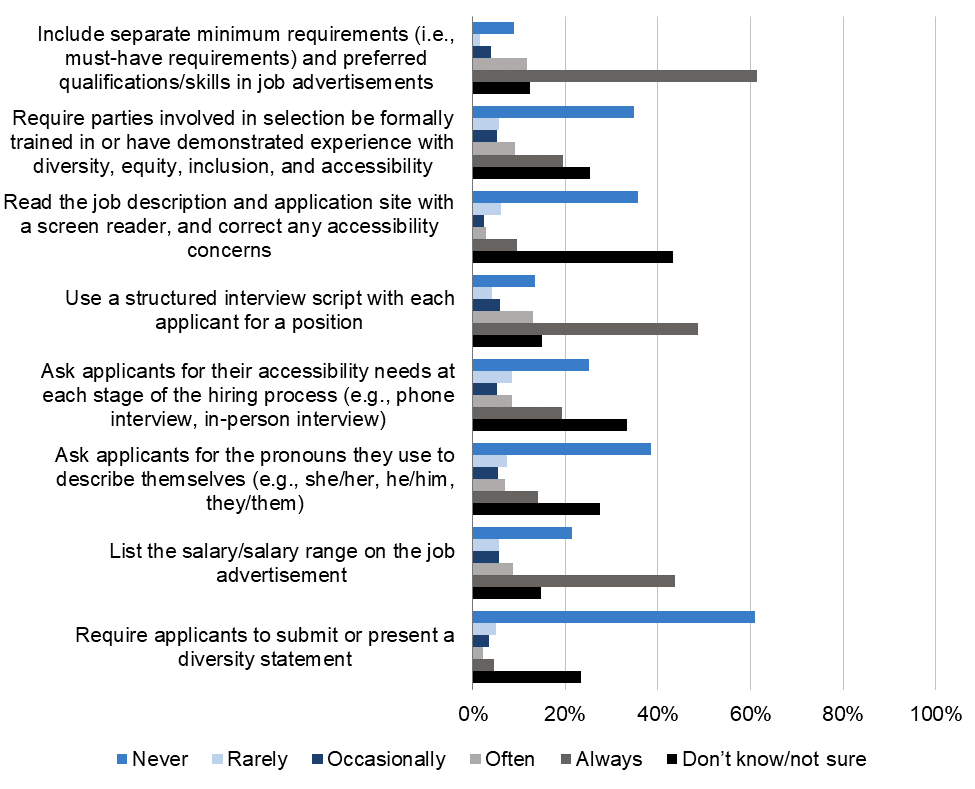
| Never | Occasionally | Always | Don't know/not sure | ||||||
| Answer | Frequency | Percentage | Frequency | Percentage | Frequency | Percentage | Frequency | Percentage | |
| Include separate minimum requirements (i.e., must-have requirements) and preferred qualifications / skills in job advertisements | 65 | 8.98% | 29 | 4.01% | 444 | 61.33% | 90 | 12.43% | |
| Require parties involved in selection be formally trained in or have demonstrated experience with diversity, equity, inclusion, and accessibility | 253 | 34.90% | 38 | 5.24% | 141 | 19.45% | 184 | 25.38% | |
| Read the job description and application site with a screen reader, and correct any accessibility concerns | 258 | 35.59% | 18 | 2.48% | 70 | 9.66% | 313 | 43.17% | |
| Use a structured interview script with each applicant for a position | 97 | 13.38% | 43 | 5.93% | 353 | 48.69% | 108 | 14.90% | |
| Ask applicants for their accessibility needs at each stage of the hiring process (e.g., phone interview, in-person interview) | 181 | 25.03% | 38 | 5.26% | 140 | 19.36% | 241 | 33.33% | |
| Ask applicants for the pronouns they use to describe themselves (e.g., she/her, he/him, they/them) | 279 | 38.48% | 40 | 5.52% | 102 | 14.07% | 199 | 27.45% | |
| List the salary/salary range on the job advertisement | 155 | 21.41% | 41 | 5.66% | 317 | 43.78% | 107 | 14.78% | |
| Require applicants to submit or present a diversity statement | 441 | 60.91% | 26 | 3.59% | 34 | 4.70% | 170 | 23.48% | |
Figure 93 - What are the reasons staff voluntarily leave your department? Please select all that apply. (Q30)
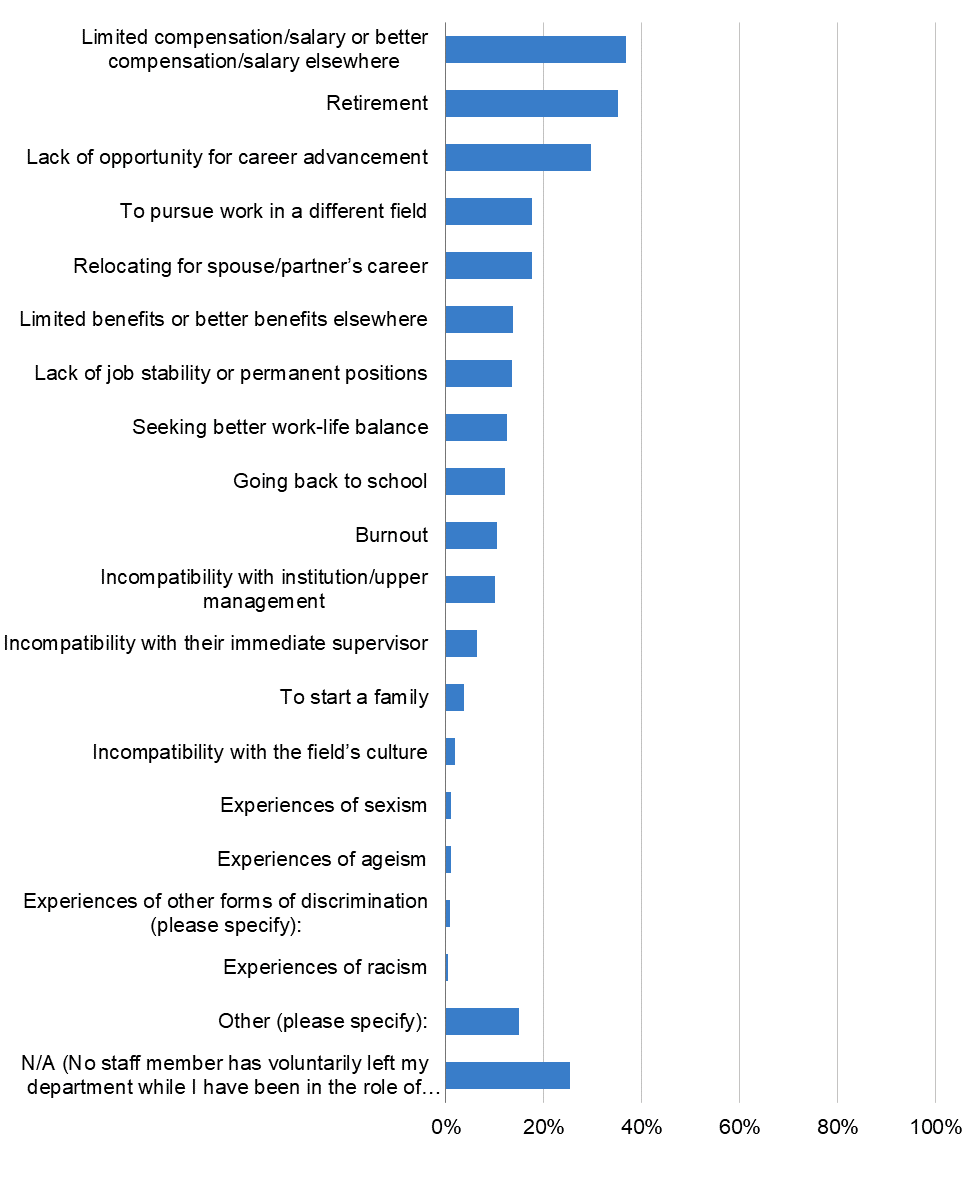
| Answer | Frequency | Percentage |
| Limited compensation/salary or better compensation/salary elsewhere | 269 | 36.80% |
| Retirement | 257 | 35.16% |
| Lack of opportunity for career advancement | 216 | 29.55% |
| To pursue work in a different field | 129 | 17.65% |
| Relocating for spouse/partner’s career | 129 | 17.65% |
| Limited benefits or better benefits elsewhere | 100 | 13.68% |
| Lack of job stability or permanent positions | 98 | 13.41% |
| Seeking better work-life balance | 91 | 12.45% |
| Going back to school | 88 | 12.04% |
| Burnout | 76 | 10.40% |
| Incompatibility with institution/upper management | 73 | 9.99% |
| Incompatibility with their immediate supervisor | 46 | 6.29% |
| To start a family | 27 | 3.69% |
| Incompatibility with the field’s culture | 14 | 1.92% |
| Experiences of sexism | 7 | 0.96% |
| Experiences of ageism | 7 | 0.96% |
| Experiences of other forms of discrimination (please specify): | 6 | 0.82% |
| Experiences of racism | 3 | 0.41% |
| Other (please specify): | 109 | 14.91% |
| N/A (No staff member has voluntarily left my department while I have been in the role of senior administrator) | 185 | 25.31% |
Figure 94 - Please indicate the total annual operating budget (excluding staff compensation) for your department: (Q31)
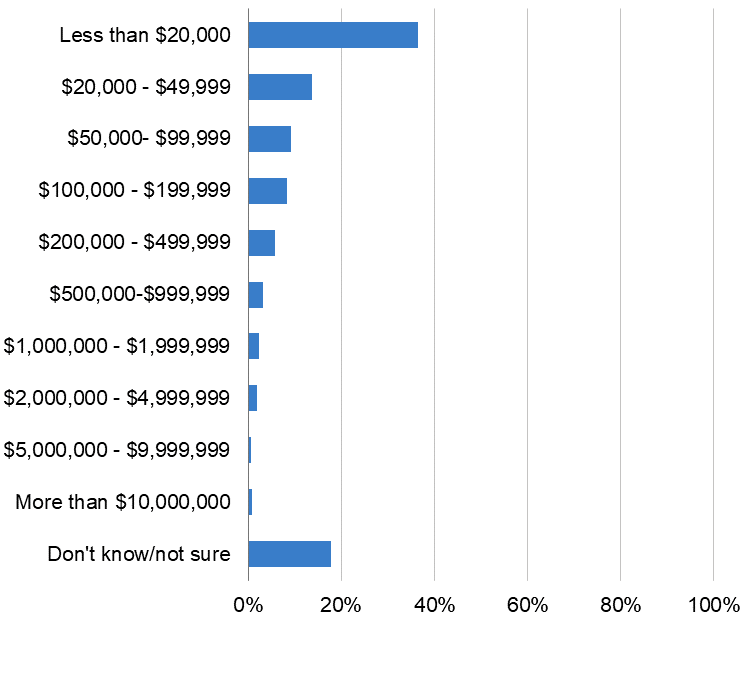
| Answer | Frequency | Percentage |
| Less than $20,000 | 269 | 36.45% |
| $20,000 - $49,999 | 101 | 13.69% |
| $50,000- $99,999 | 68 | 9.21% |
| $100,000 - $199,999 | 61 | 8.27% |
| $200,000 - $499,999 | 42 | 5.69% |
| $500,000-$999,999 | 23 | 3.12% |
| $1,000,000 - $1,999,999 | 18 | 2.44% |
| $2,000,000 - $4,999,999 | 14 | 1.90% |
| $5,000,000 - $9,999,999 | 5 | 0.68% |
| More than $10,000,000 | 6 | 0.81% |
| Don't know/not sure | 131 | 17.75% |
Figure 95 - What percentage of your department’s operating budget (excluding staff compensation) is derived from the following sources? Please provide your best estimate. Percentages must add to 100%. If you prefer not to answer this question, please enter “100” next to “Skip. (Q32)
| Mean Answer | Count | |
| Endowment | 10.98% | 456 |
| Federal government | 6.78% | |
| State government | 9.91% | |
| Local government | 13.18% | |
| Other government (please specify):_________ | 1.21% | |
| College and university (excluding state government funding) | 19.31% | |
| Memberships | 3.03% | |
| Donations/contributions | 10.77% | |
| Foundations, trusts, and grants | 5% | |
| Benefit events | 0.78% | |
| Admissions | 1.07% | |
| Corporate earnings | 5.54% | |
| Other earned revenue (excluding corporate earnings) | 1.76% | |
| Other (please specify): | 6.43% |
Figure 96 - What percentage of your department’s operating budget is allocated to the following areas? Please provide your best estimate. Percentages must add to 100% (Q33)
| Mean Answer | Count | |
| Collections and/or acquisitions | 11.66% | 389 |
| Programming, outreach, and/or teaching | 4.09% | |
| Supplies and/or office management | 23.74% | |
| Special projects | 7.26% | |
| Professional development for staff | 6.66% | |
| Field work (e.g., donor relations, logistics, etc.) | 1.64% | |
| Facilities | 10.13% | |
| Conservation and/or preservation | 11.36% | |
| Digital asset/content management (e.g., systems, vendors, memberships) | 15.44% | |
| Other (please specify): | 7.33% |
Figure 97 - How are the contract positions in your department funded? Please select all that apply. (Q34)
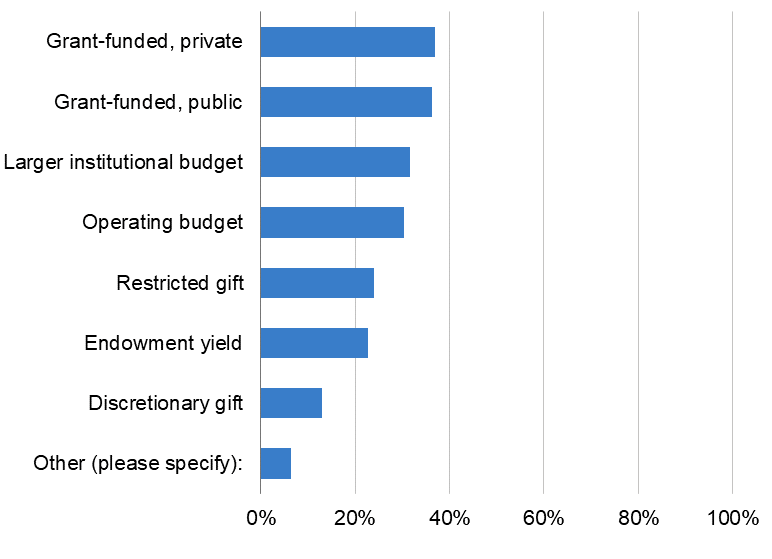
| Answer | Frequency | Percentage |
| Grant-funded, private | 63 | 36.84% |
| Grant-funded, public | 62 | 36.26% |
| Larger institutional budget | 54 | 31.58% |
| Operating budget | 52 | 30.41% |
| Restricted gift | 41 | 23.98% |
| Endowment yield | 39 | 22.81% |
| Discretionary gift | 22 | 12.87% |
| Other (please specify): | 11 | 6.43% |
Figure 98 - What are the primary constraints on your ability to execute strategy in your department? Please select up to five items. (Q35)
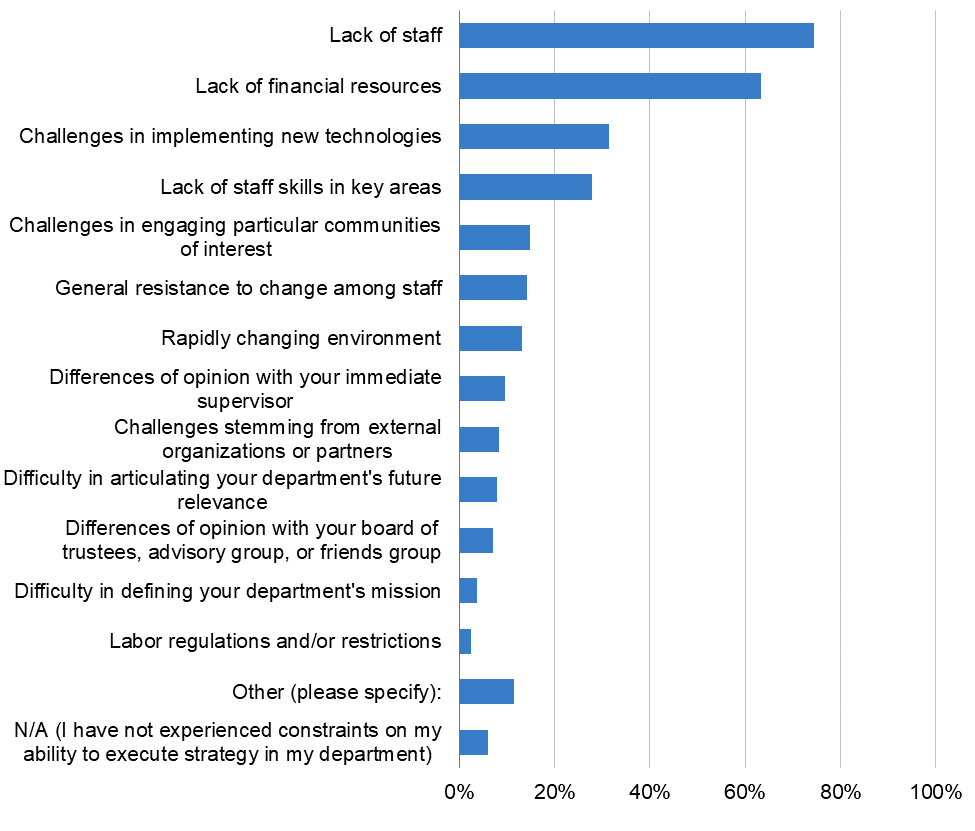
| Answer | Frequency | Percentage |
| Lack of staff | 553 | 74.53% |
| Lack of financial resources | 470 | 63.34% |
| Challenges in implementing new technologies | 233 | 31.40% |
| Lack of staff skills in key areas | 207 | 27.90% |
| Challenges in engaging particular communities of interest | 110 | 14.82% |
| General resistance to change among staff | 105 | 14.15% |
| Rapidly changing environment | 98 | 13.21% |
| Differences of opinion with your immediate supervisor | 72 | 9.70% |
| Challenges stemming from external organizations or partners | 62 | 8.36% |
| Difficulty in articulating your department's future relevance | 59 | 7.95% |
| Differences of opinion with your board of trustees, advisory group, or friends group | 52 | 7.01% |
| Difficulty in defining your department's mission | 27 | 3.64% |
| Labor regulations and/or restrictions | 18 | 2.43% |
| Other (please specify): | 85 | 11.46% |
| N/A (I have not experienced constraints on my ability to execute strategy in my department) | 45 | 6.06% |
Figure 99 - If you received a 10% increase in your department’s budget next year in addition to the funds you already expect to receive, in which of the following areas would you allocate the money? Please select up to five items. (Q36)
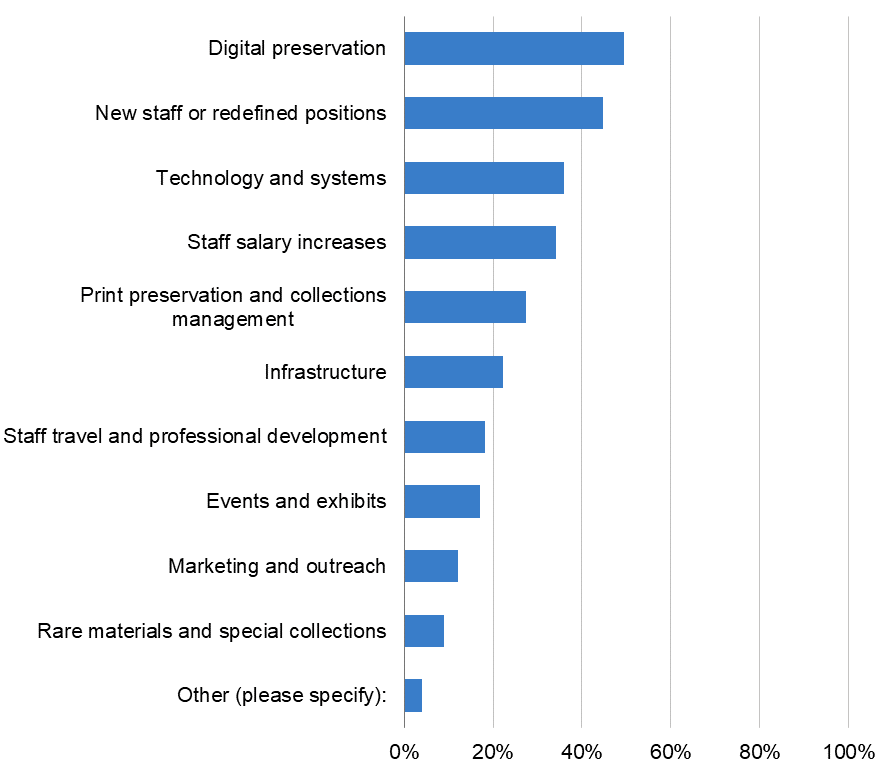
| Answer | Frequency | Percentage |
| Digital preservation | 364 | 49.46% |
| New staff or redefined positions | 330 | 44.84% |
| Technology and systems | 264 | 35.87% |
| Staff salary increases | 252 | 34.24% |
| Print preservation and collections management | 202 | 27.45% |
| Infrastructure | 163 | 22.15% |
| Staff travel and professional development | 133 | 18.07% |
| Events and exhibits | 125 | 16.98% |
| Marketing and outreach | 89 | 12.09% |
| Rare materials and special collections | 66 | 8.97% |
| Other (please specify): | 30 | 4.08% |
Figure 100 - In your professional opinion, how important is it that your department provides each of the functions below or serves in the capacity listed below? Please select one answer for each item. (Q37)
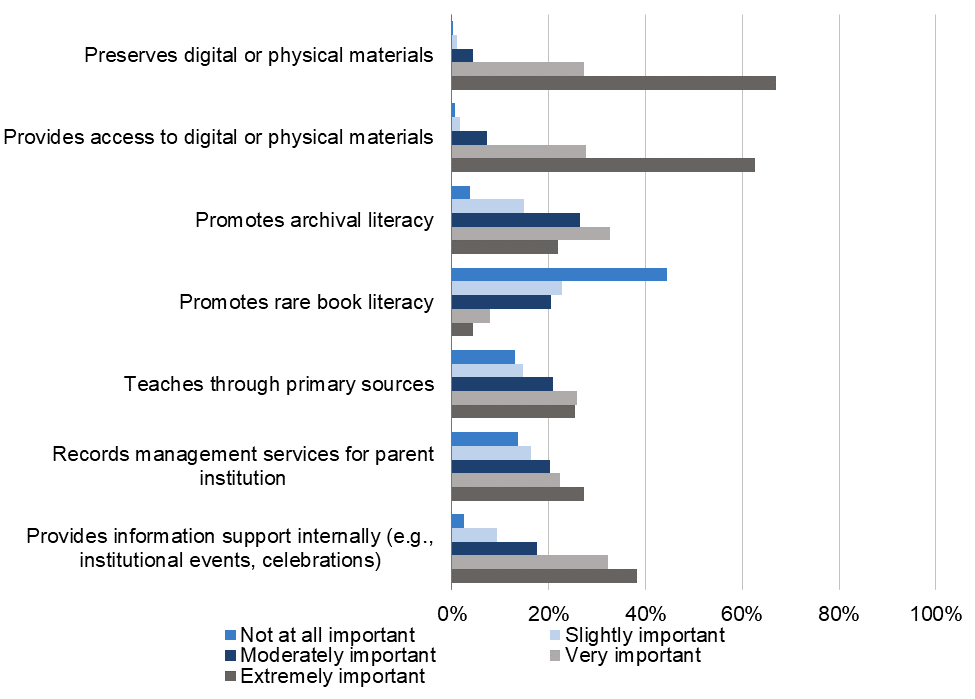
| Not at all important | Moderately important | Extremely important | ||||
| Answer | Frequency | Percentage | Frequency | Percentage | Frequency | Percentage |
| Preserves digital or physical materials | 1 | 0.14% | 33 | 4.47% | 495 | 66.98% |
| Provides access to digital or physical materials | 5 | 0.68% | 54 | 7.32% | 463 | 62.74% |
| Promotes archival literacy | 28 | 3.80% | 195 | 26.49% | 162 | 22.01% |
| Promotes rare book literacy | 327 | 44.55% | 150 | 20.44% | 32 | 4.36% |
| Teaches through primary sources | 96 | 13.06% | 154 | 20.95% | 187 | 25.44% |
| Records management services for parent institution | 100 | 13.68% | 148 | 20.25% | 200 | 27.36% |
| Provides information support internally (e.g., institutional events, celebrations) | 19 | 2.59% | 130 | 17.69% | 281 | 38.23% |
Figure 101 - Q37 Continued
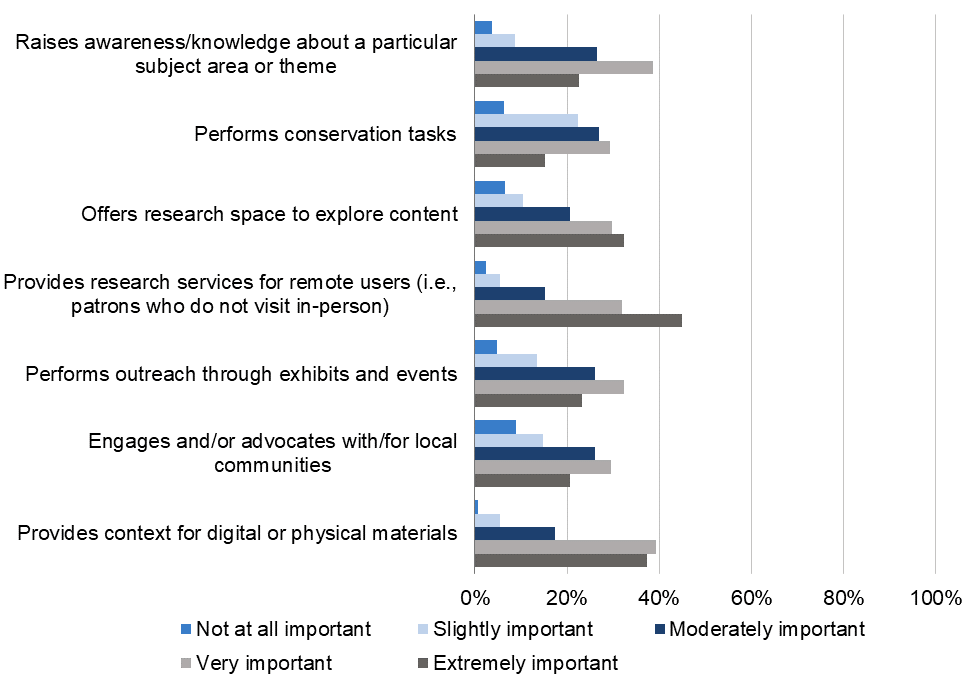
| Not at all important | Moderately important | Extremely important | ||||
| Answer | Frequency | Percentage | Frequency | Percentage | Frequency | Percentage |
| Raises awareness/knowledge about a particular subject area or theme | 27 | 3.66% | 195 | 26.42% | 167 | 22.63% |
| Performs conservation tasks | 47 | 6.35% | 199 | 26.89% | 112 | 15.14% |
| Offers research space to explore content | 49 | 6.64% | 153 | 20.73% | 239 | 32.38% |
| Provides research services for remote users (i.e., patrons who do not visit in-person) | 18 | 2.44% | 113 | 15.29% | 332 | 44.93% |
| Performs outreach through exhibits and events | 36 | 4.88% | 192 | 26.02% | 172 | 23.31% |
| Engages and/or advocates with/for local communities | 66 | 8.96% | 192 | 26.05% | 152 | 20.62% |
| Provides context for digital or physical materials | 5 | 0.68% | 128 | 17.30% | 277 | 37.43% |
Figure 102 - Please read the following statements and indicate the extent to which you agree or disagree with each. Please use the scroll bar at the bottom of this question to see all available answer options. (Q38)
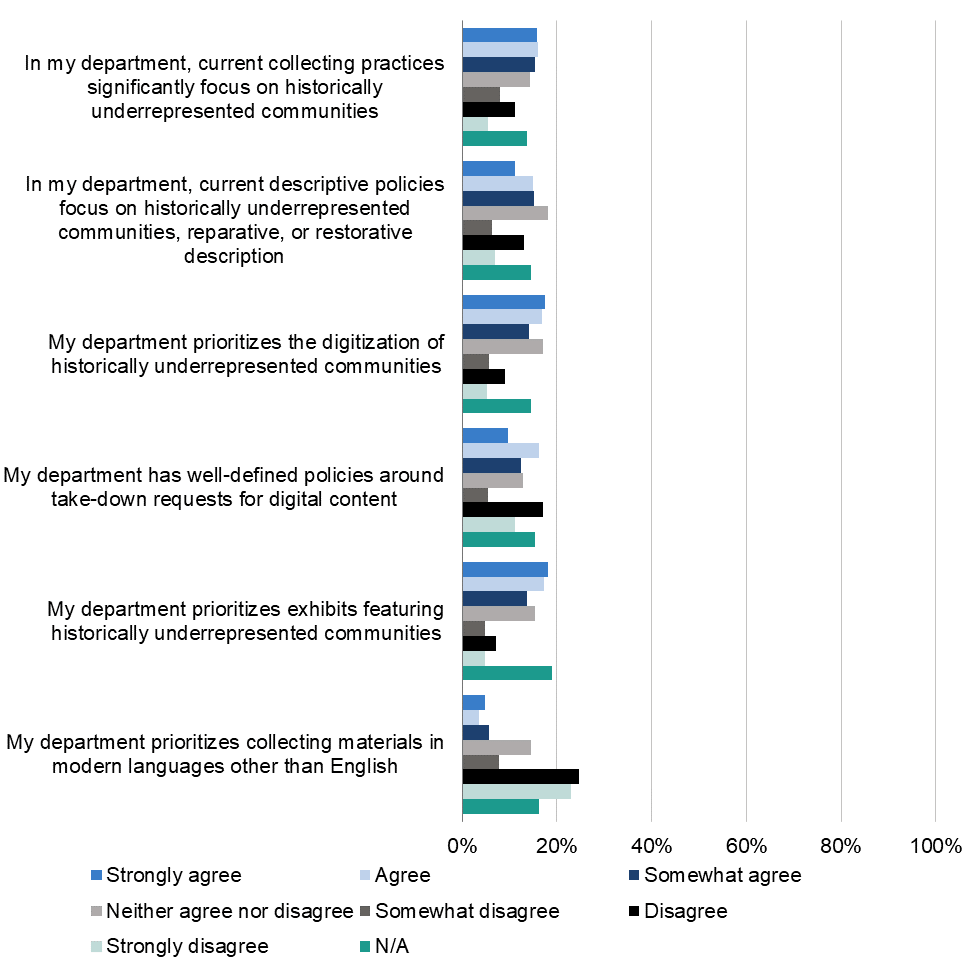
| Strongly disagree | Neither agree nor disagree | Strongly agree | N/A | |||||
| Answer | Frequency | Percentage | Frequency | Percentage | Frequency | Percentage | Frequency | Percentage |
| In my department, current collecting practices significantly focus on historically underrepresented communities | 41 | 5.55% | 106 | 14.34% | 117 | 15.83% | 101 | 13.67% |
| In my department, current descriptive policies focus on historically underrepresented communities, reparative, or restorative description | 51 | 6.90% | 134 | 18.13% | 82 | 11.10% | 107 | 14.48% |
| My department prioritizes the digitization of historically underrepresented communities | 38 | 5.14% | 127 | 17.16% | 129 | 17.43% | 108 | 14.59% |
| My department has well-defined policies around take-down requests for digital content | 82 | 11.10% | 95 | 12.86% | 72 | 9.74% | 113 | 15.29% |
| My department prioritizes exhibits featuring historically underrepresented communities | 35 | 4.74% | 113 | 15.31% | 133 | 18.02% | 140 | 18.97% |
| My department prioritizes collecting materials in modern languages other than English | 170 | 22.97% | 107 | 14.46% | 35 | 4.73% | 120 | 16.22% |
Figure 103 - Please read the following statements and indicate the extent to which you agree or disagree with each. Please use the scroll bar at the bottom of this question to see all available answer options. (Q39)
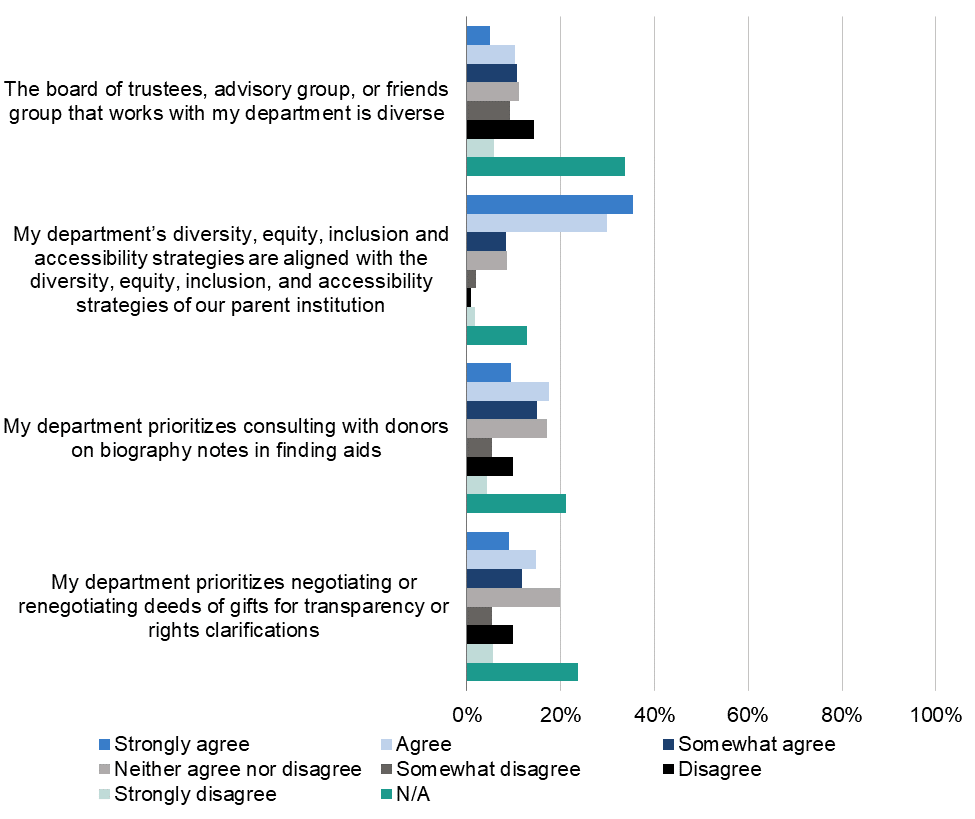
| Strongly disagree | Neither agree nor disagree | Strongly agree | N/A | |||||
| Answer | Frequency | Percentage | Frequency | Percentage | Frequency | Percentage | Frequency | Percentage |
| The board of trustees, advisory group, or friends group that works with my department is diverse | 43 | 5.81% | 83 | 11.22% | 36 | 4.86% | 249 | 33.65% |
| My department’s diversity, equity, inclusion and accessibility strategies are aligned with the diversity, equity, inclusion, and accessibility strategies of our parent institution | 13 | 1.76% | 64 | 8.67% | 262 | 35.50% | 95 | 12.87% |
| My department prioritizes consulting with donors on biography notes in finding aids | 32 | 4.33% | 127 | 17.19% | 70 | 9.47% | 157 | 21.24% |
| My department prioritizes negotiating or renegotiating deeds of gifts for transparency or rights clarifications | 42 | 5.68% | 147 | 19.89% | 66 | 8.93% | 175 | 23.68% |
Figure 104 - Please read the following statements and indicate the extent to which you agree or disagree with each. Please use the scroll bar at the bottom of this question to see all available answer options. (Q40)
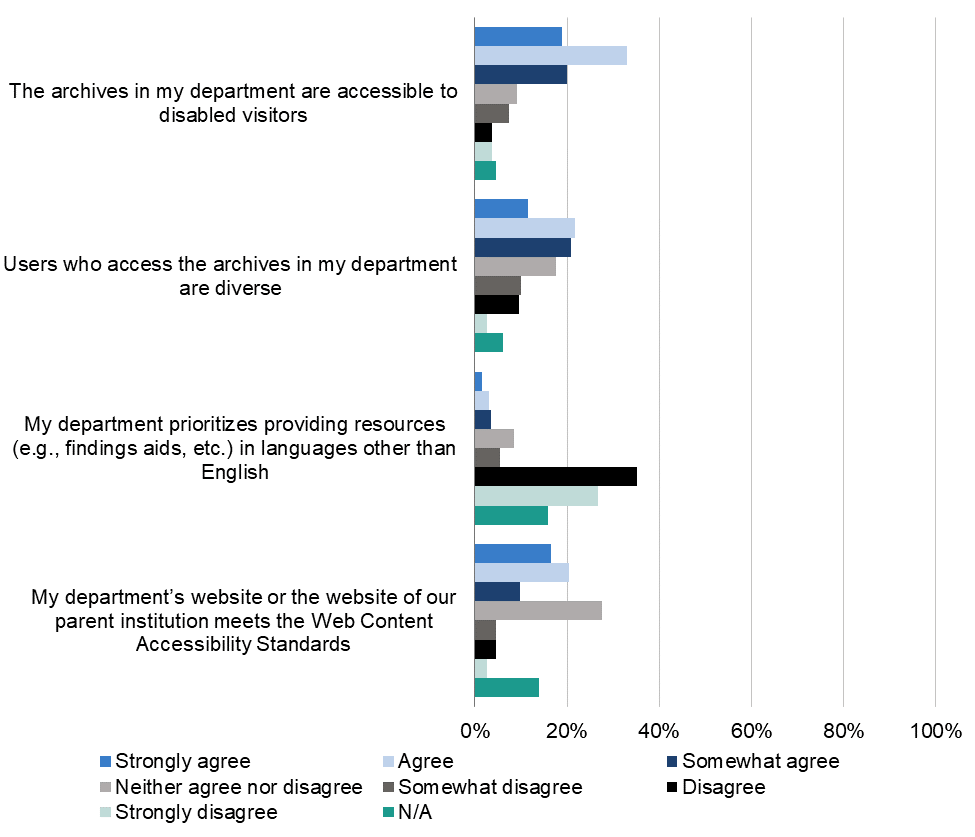
| Strongly disagree | Neither agree nor disagree | Strongly agree | N/A | |||||
| Answer | Frequency | Percentage | Frequency | Percentage | Frequency | Percentage | Frequency | Percentage |
| The archives in my department are accessible to disabled visitors | 27 | 3.66% | 67 | 9.09% | 139 | 18.86% | 33 | 4.48% |
| Users who access the archives in my department are diverse | 20 | 2.70% | 131 | 17.70% | 85 | 11.49% | 45 | 6.08% |
| My department prioritizes providing resources (e.g., findings aids, etc.) in languages other than English | 198 | 26.76% | 63 | 8.51% | 12 | 1.62% | 118 | 15.95% |
| My department's website or the website of our parent institution meets the Web Content Accessibility Standards | 19 | 2.58% | 203 | 27.58% | 121 | 16.44% | 103 | 13.99% |
Figure 105 - Please read the following statements and indicate the extent to which you agree or disagree with each. Please use the scroll bar at the bottom of this question to see all available answer options. (Q41)
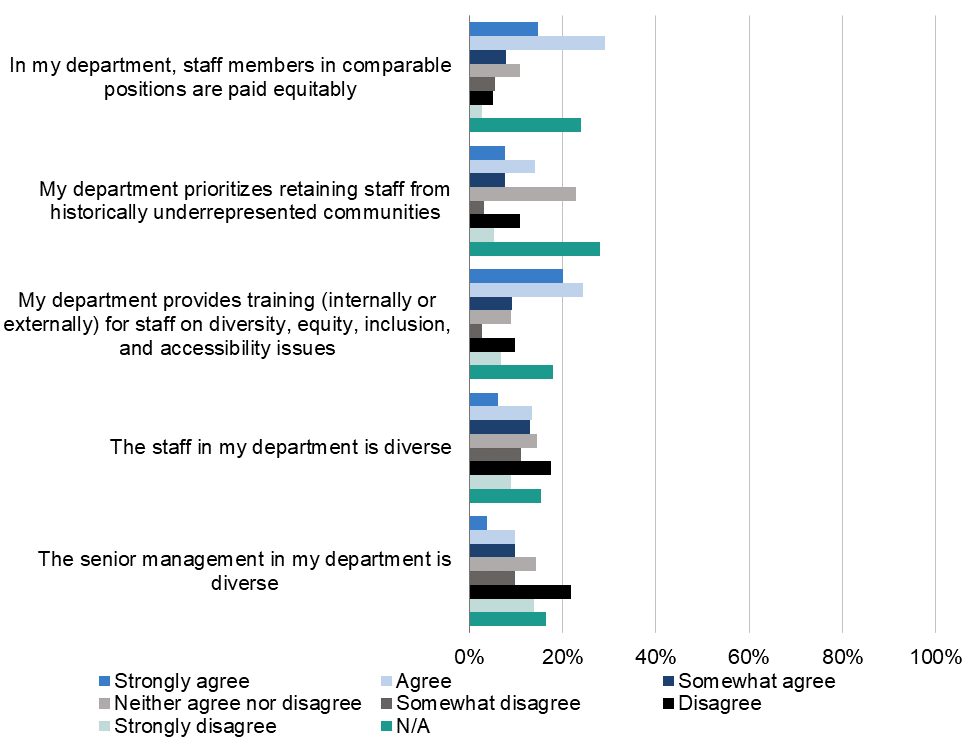
| Strongly disagree | Neither agree nor disagree | Strongly agree | N/A | |||||
| Answer | Frequency | Percentage | Frequency | Percentage | Frequency | Percentage | Frequency | Percentage |
| In my department, staff members in comparable positions are paid equitably | 20 | 2.72% | 80 | 10.87% | 108 | 14.67% | 177 | 24.05% |
| My department prioritizes retaining staff from historically underrepresented communities | 40 | 5.42% | 169 | 22.90% | 57 | 7.72% | 207 | 28.05% |
| My department provides training (internally or externally) for staff on diversity, equity, inclusion, and accessibility issues | 50 | 6.78% | 66 | 8.94% | 148 | 20.05% | 133 | 18.02% |
| The staff in my department is diverse | 66 | 8.96% | 107 | 14.52% | 45 | 6.11% | 113 | 15.33% |
| The senior management in my department is diverse | 103 | 13.94% | 106 | 14.34% | 29 | 3.92% | 122 | 16.51% |
Figure 106 - Please read the following statements and indicate the extent to which you agree or disagree with each. Please use the scroll bar at the bottom of this question to see all available answer options. (Q42)
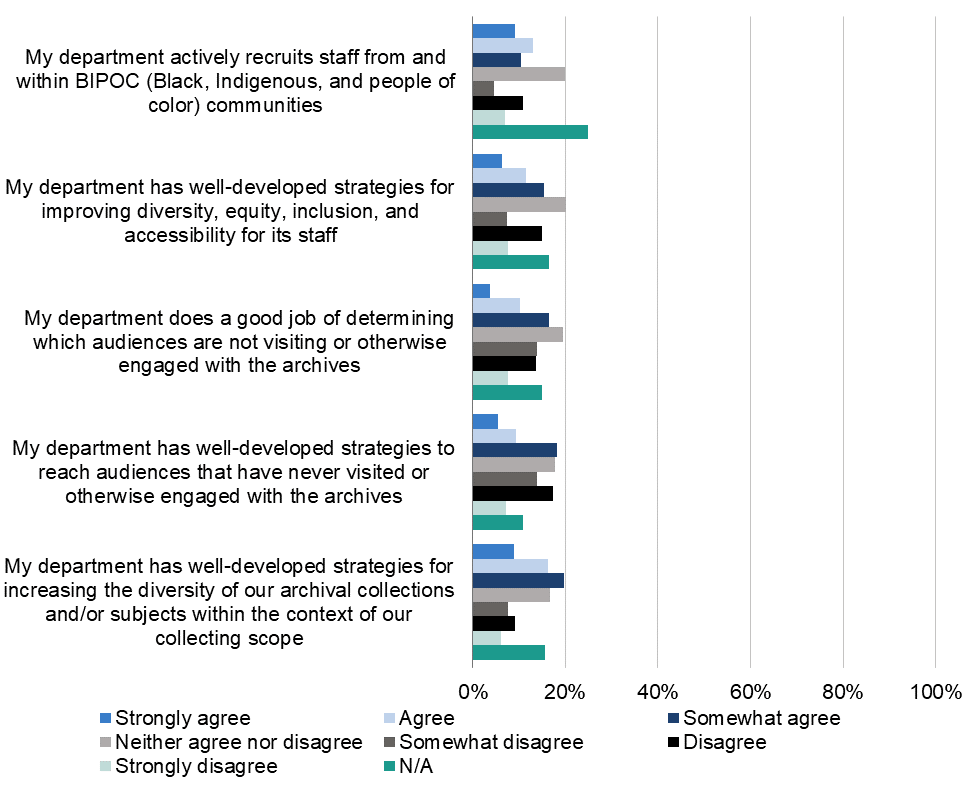
| Strongly disagree | Neither agree nor disagree | Strongly agree | N/A | |||||
| Answer | Frequency | Percentage | Frequency | Percentage | Frequency | Percentage | Frequency | Percentage |
| My department actively recruits staff from and within BIPOC (Black, Indigenous, and people of color) communities | 52 | 7.05% | 148 | 20.05% | 67 | 9.08% | 184 | 24.93% |
| My department has well-developed strategies for improving diversity, equity, inclusion, and accessibility for its staff | 57 | 7.74% | 148 | 20.11% | 47 | 6.39% | 121 | 16.44% |
| My department does a good job of determining which audiences are not visiting or otherwise engaged with the archives | 57 | 7.73% | 144 | 19.54% | 27 | 3.66% | 110 | 14.93% |
| My department has well-developed strategies to reach audiences that have never visited or otherwise engaged with the archives | 53 | 7.19% | 131 | 17.77% | 40 | 5.43% | 80 | 10.85% |
| My department has well-developed strategies for increasing the diversity of our archival collections and/or subjects within the context of our collecting scope | 45 | 6.09% | 123 | 16.64% | 66 | 8.93% | 115 | 15.56% |
Figure 107 - In response to the financial impact of the COVID-19 pandemic, did your department experience budget decreases of any size or duration in the following categories? Please select all that apply. (Q43)
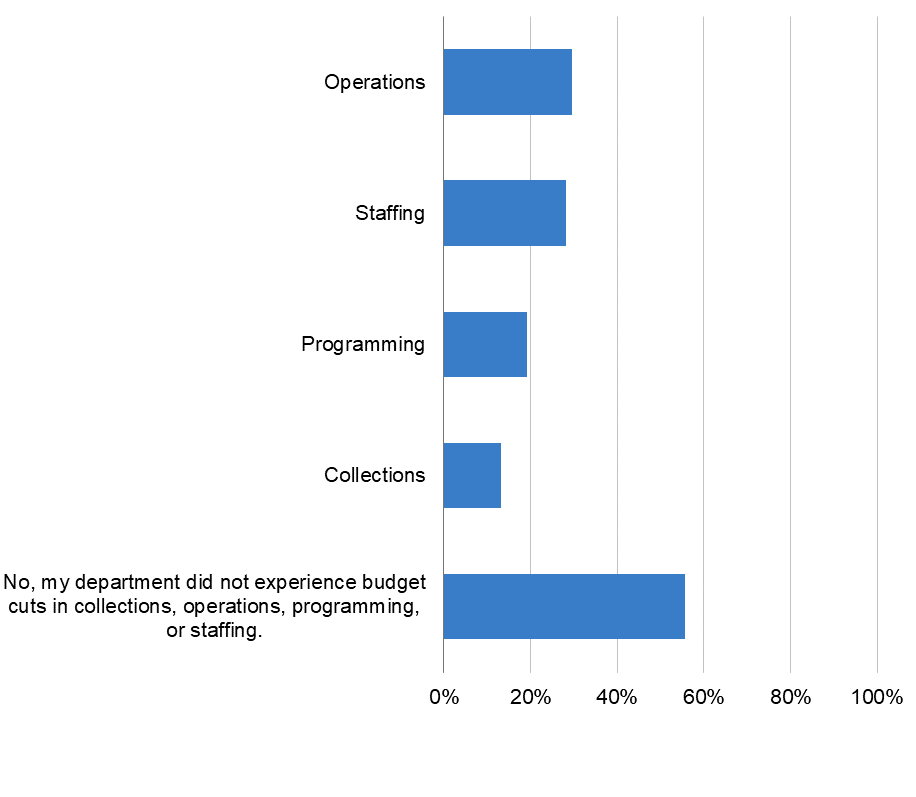
| Answer | Frequency | Percentage |
| Operations | 218 | 29.66% |
| Staffing | 207 | 28.16% |
| Programming | 142 | 19.32% |
| Collections | 97 | 13.20% |
| No, my department did not experience budget cuts in collections, operations, programming, or staffing. | 409 | 55.65% |
Figure 108 - You indicated that, due to the financial impact of the COVID-19 pandemic, your department experienced a budget decrease in the category(ies) below. As of today, to what extent has the budget(s) recovered to its pre-pandemic amount? (Q44)
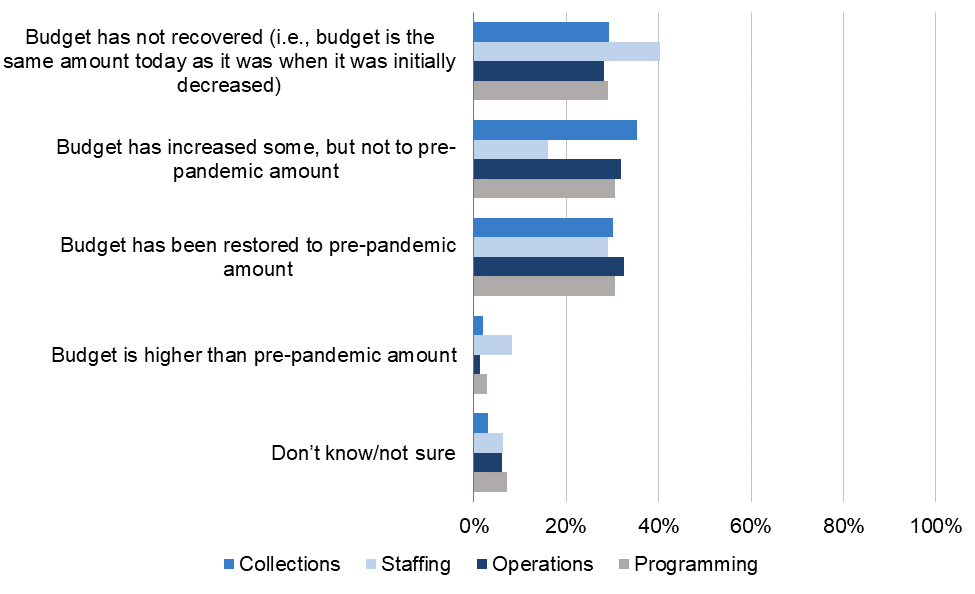
| Budget has not recovered (i.e., budget is the same amount today as it was when it was initially decreased) | Budget has increased some, but not to pre-pandemic amount | Budget has been restored to pre-pandemic amount | Budget is higher than pre-pandemic amount | Don't know/not sure | ||||||
| Answer | Frequency | Percentage | Frequency | Percentage | Frequency | Percentage | Frequency | Percentage | Frequency | Percentage |
| Collections | 28 | 29.17% | 34 | 35.42% | 29 | 30.21% | 2 | 2.08% | 3 | 3.13% |
| Staffing | 83 | 40.29% | 33 | 16.02% | 60 | 29.13% | 17 | 8.25% | 13 | 6.31% |
| Operations | 61 | 28.24% | 69 | 31.94% | 70 | 32.41% | 3 | 1.39% | 13 | 6.02% |
| Programming | 41 | 29.08% | 43 | 30.50% | 43 | 30.50% | 4 | 2.84% | 10 | 7.09% |
Figure 109 - In response to the financial impact of the COVID-19 pandemic, which of the following changes were in effect with regards to your department’s staffing and benefits in the years below. Please select all that apply. (Q45)

| 2020 | 2021 | 2022 | N/A | |||||
| Answer | Frequency | Percentage | Frequency | Percentage | Frequency | Percentage | Frequency | Percentage |
| Reduction in public service desk hours and/or locations | 478 | 67.04% | 408 | 57.22% | 212 | 29.73% | 222 | 31.14% |
| Hiring freezes | 280 | 41.24% | 184 | 27.10% | 55 | 8.10% | 374 | 55.08% |
| Reduction or elimination of professional development funds | 245 | 35.77% | 220 | 32.12% | 108 | 15.77% | 411 | 60.00% |
| Salary freezes | 216 | 31.91% | 113 | 16.69% | 39 | 5.76% | 443 | 65.44% |
| Furloughs or hour reductions | 140 | 21.02% | 58 | 8.71% | 6 | 0.90% | 514 | 77.18% |
| Elimination of currently vacant positions | 128 | 19.42% | 81 | 12.29% | 39 | 5.92% | 509 | 77.24% |
| Retirement contribution freezes or reductions | 67 | 10.23% | 52 | 7.94% | 17 | 2.60% | 577 | 88.09% |
| Pay cuts to department leadership and/or the most highly-compensated staff members | 63 | 9.62% | 29 | 4.43% | 7 | 1.07% | 584 | 89.16% |
| Elimination of currently filled positions | 58 | 9.02% | 28 | 4.35% | 10 | 1.56% | 566 | 88.02% |
| Pay cuts to all or most staff members | 58 | 8.99% | 29 | 4.50% | 5 | 0.78% | 582 | 90.23% |
Figure 110 - What changes to staff positions in each of the following areas were made, in response to the financial impact of COVID-19? (Q46)
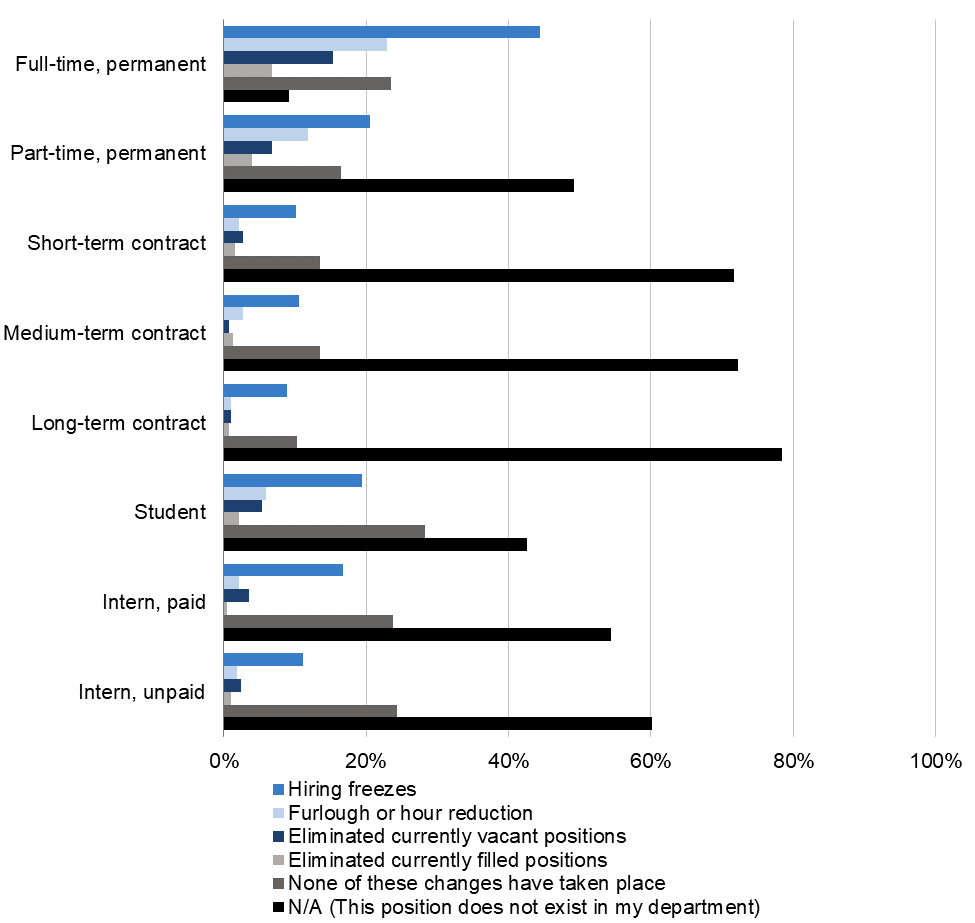
| Hiring freezes | Furlough or hour reduction | Eliminated currently vacant positions | ||||
| Answer | Frequency | Percentage | Frequency | Percentage | Frequency | Percentage |
| Full-time, permanent (i.e., no set end date) | 170 | 44.39% | 88 | 22.98% | 59 | 15.40% |
| Part-time, permanent (i.e., no set end date) | 76 | 20.54% | 44 | 11.89% | 25 | 6.76% |
| Short-term contract (i.e., less than 1 year) | 37 | 10.16% | 8 | 2.20% | 10 | 2.75% |
| Medium-term contract (i.e., 1-3 years) | 39 | 10.60% | 10 | 2.72% | 3 | 0.82% |
| Long-term contract (i.e., more than 3 years) | 33 | 8.92% | 4 | 1.08% | 4 | 1.08% |
| Student | 72 | 19.41% | 22 | 5.93% | 20 | 5.39% |
| Intern, paid | 62 | 16.76% | 8 | 2.16% | 13 | 3.51% |
| Intern, unpaid | 41 | 11.20% | 7 | 1.91% | 9 | 2.46% |
Q46 Table Continued
| Eliminated currently filled positions | None of these changes have taken place | N/A (This position doesn't exist in my department) | ||||
| Answer | Frequency | Percentage | Frequency | Percentage | Frequency | Percentage |
| Full-time, permanent (i.e., no set end date) | 26 | 6.79% | 90 | 23.50% | 35 | 9.14% |
| Part-time, permanent (i.e., no set end date) | 15 | 4.05% | 61 | 16.49% | 182 | 49.19% |
| Short-term contract (i.e., less than 1 year) | 6 | 1.65% | 49 | 13.46% | 261 | 71.70% |
| Medium-term contract (i.e., 1-3 years) | 5 | 1.36% | 50 | 13.59% | 266 | 72.28% |
| Long-term contract (i.e., more than 3 years) | 3 | 0.81% | 38 | 10.27% | 290 | 78.38% |
| Student | 8 | 2.16% | 105 | 28.30% | 158 | 42.59% |
| Intern, paid | 2 | 0.54% | 88 | 23.78% | 201 | 54.32% |
| Intern, unpaid | 4 | 1.09% | 89 | 24.32% | 220 | 60.11% |
Figure 111 - You indicated that filled positions were eliminated in your department due to the financial impact of the COVID-19 pandemic. What percentage of filled positions were eliminated in your department in the following years, regardless of position type? (Q47)
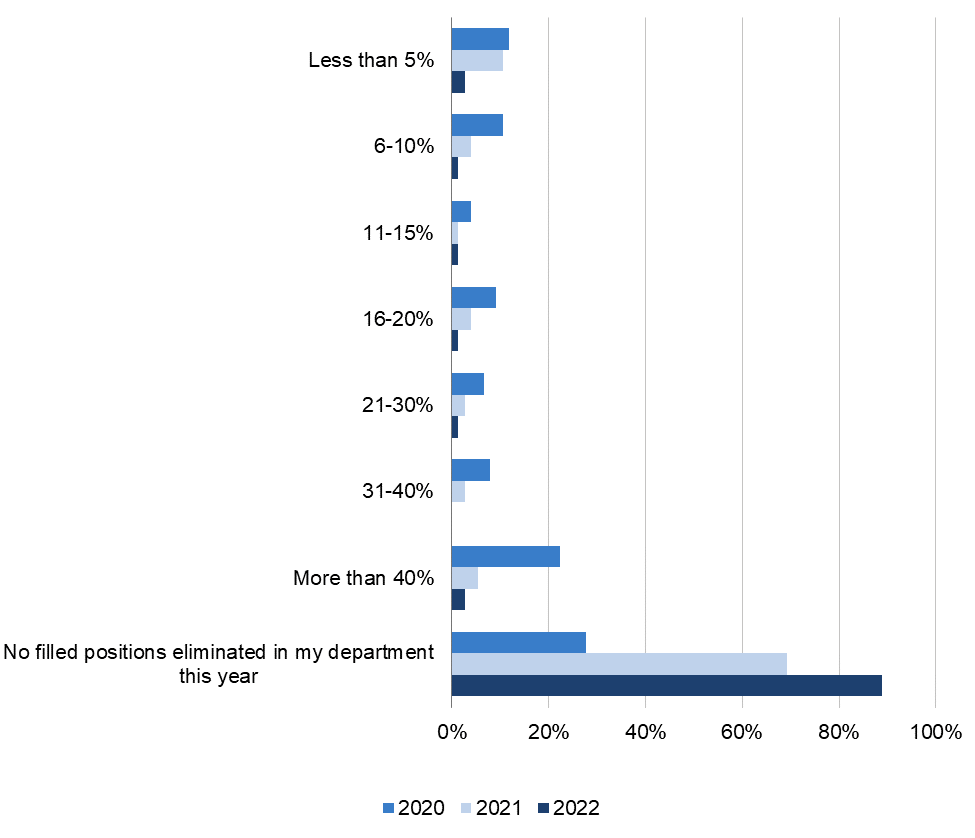
| 2020 | 2021 | 2022 | ||||
| Answer | Frequency | Percentage | Frequency | Percentage | Frequency | Percentage |
| Less than 5% | 9 | 11.84% | 8 | 10.67% | 2 | 2.78% |
| 6-10% | 8 | 10.53% | 3 | 4.00% | 1 | 1.39% |
| 11-15% | 3 | 3.95% | 1 | 1.33% | 1 | 1.39% |
| 16-20% | 7 | 9.21% | 3 | 4.00% | 1 | 1.39% |
| 21-30% | 5 | 6.58% | 2 | 2.67% | 1 | 1.39% |
| 31-40% | 6 | 7.89% | 2 | 2.67% | 0 | 0.00% |
| More than 40% | 17 | 22.37% | 4 | 5.33% | 2 | 2.78% |
| No filled positions eliminated in my department this year | 21 | 27.63% | 52 | 69.33% | 64 | 88.89% |
Figure 112 - Please read the following statements and indicate the extent to which you agree or disagree. (Q48)
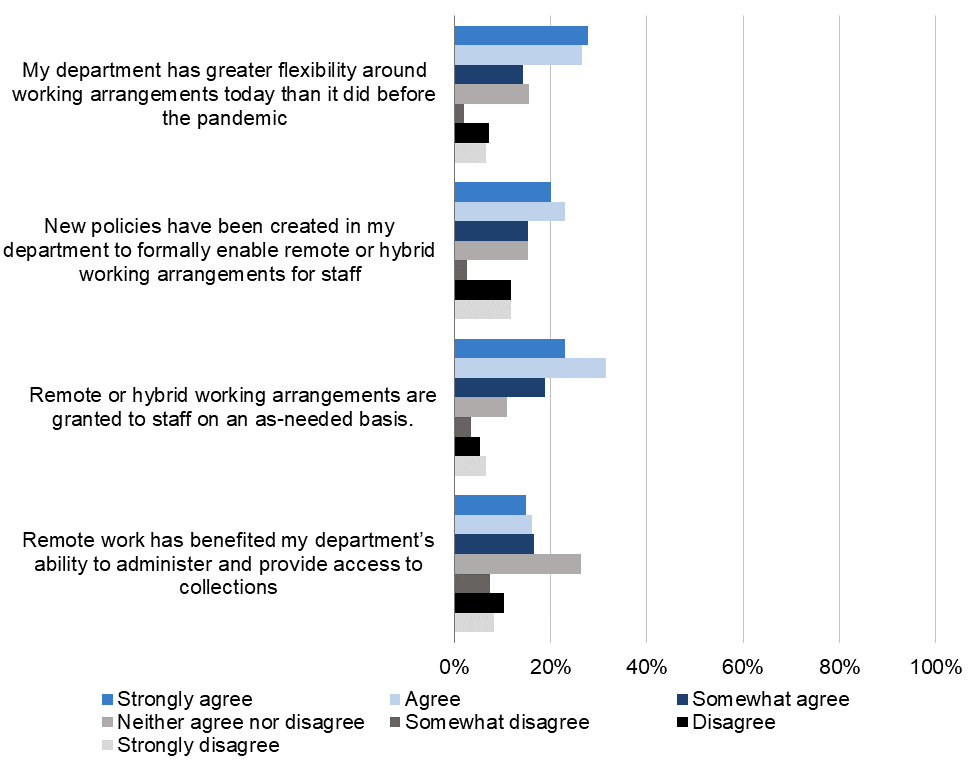
| Strongly disagree | Neither agree nor disagree | Strongly agree | ||||
| Answer | Frequency | Percentage | Frequency | Percentage | Frequency | Percentage |
| My department has greater flexibility around working arrangements today than it did before the pandemic | 49 | 6.67% | 114 | 15.51% | 204 | 27.76% |
| New policies have been created in my department to formally enable remote or hybrid working arrangements for staff | 86 | 11.73% | 112 | 15.28% | 147 | 20.05% |
| Remote or hybrid working arrangements are granted to staff on an as-needed basis. | 49 | 6.67% | 81 | 11.02% | 169 | 22.99% |
| Remote work has benefited my department’s ability to administer and provide access to collections | 61 | 8.30% | 194 | 26.39% | 109 | 14.83% |
Figure 113 - In the next 5 years, which of the following skills will be most important for the staff in your department to have? Please select up to five options. (Q49)
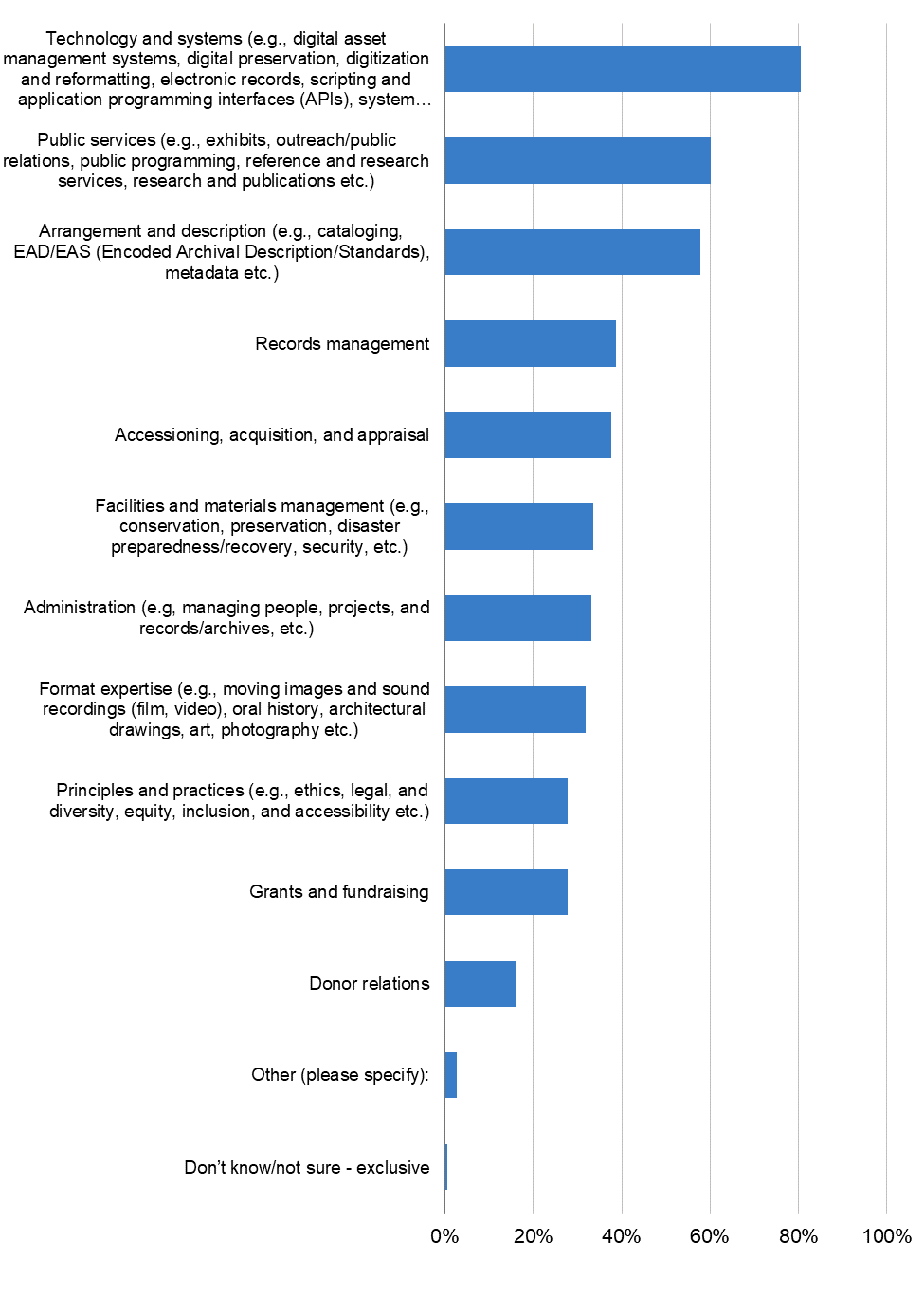
| Answer | Frequency | Percentage |
| Technology and systems (e.g., digital asset management systems, digital preservation, digitization and reformatting, electronic records, scripting and application programming interfaces (APIs), system migration, web archiving, etc.) | 596 | 80.54% |
| Public services (e.g., exhibits, outreach/public relations, public programming, reference and research services, research and publications etc.) | 445 | 60.14% |
| Arrangement and description (e.g., cataloging, EAD/EAS (Encoded Archival Description/Standards), metadata etc.) | 427 | 57.70% |
| Records management | 286 | 38.65% |
| Accessioning, acquisition, and appraisal | 278 | 37.57% |
| Facilities and materials management (e.g., conservation, preservation, disaster preparedness/recovery, security, etc.) | 249 | 33.65% |
| Administration (e.g, managing people, projects, and records/archives, etc.) | 246 | 33.24% |
| Format expertise (e.g., moving images and sound recordings (film, video), oral history, architectural drawings, art, photography etc.) | 235 | 31.76% |
| Principles and practices (e.g., ethics, legal, and diversity, equity, inclusion, and accessibility etc.) | 205 | 27.70% |
| Grants and fundraising | 205 | 27.70% |
| Donor relations | 119 | 16.08% |
| Other (please specify): | 20 | 2.70% |
| Don’t know/not sure - exclusive | 4 | 0.54% |
Figure 114 - To what extent are staff in your department resistant to the following items? (Q50)
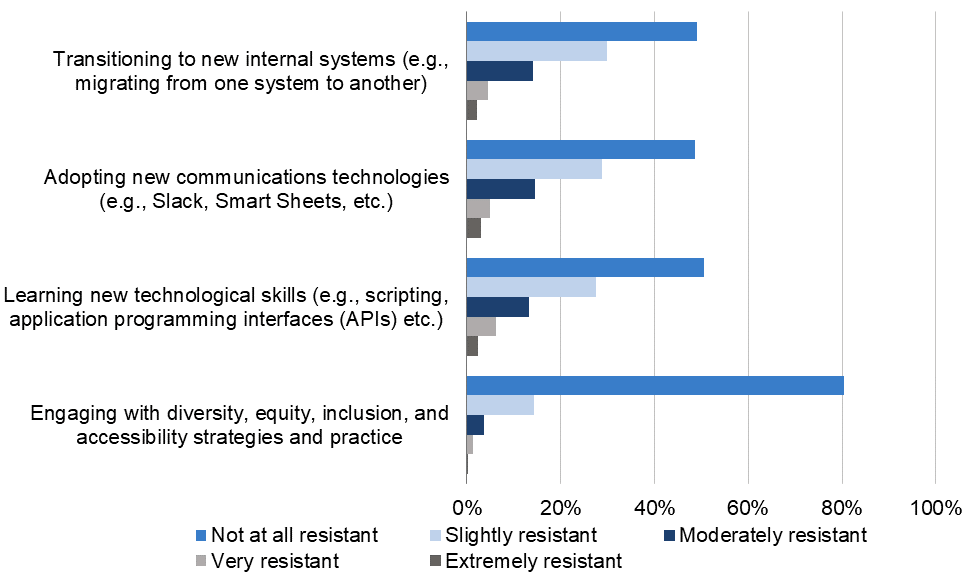
| Not at all resistant | Moderately resistant | Extremely resistant | ||||
| Answer | Frequency | Percentage | Frequency | Percentage | Frequency | Percentage |
| Transitioning to new internal systems (e.g., migrating from one system to another) | 357 | 49.17% | 103 | 14.19% | 16 | 2.20% |
| Adopting new communications technologies (e.g., Slack, Smart Sheets, etc.) | 351 | 48.55% | 105 | 14.52% | 22 | 3.04% |
| Learning new technological skills (e.g., scripting, application programming interfaces (APIs), etc.) | 368 | 50.62% | 97 | 13.34% | 17 | 2.34% |
| Engaging with diversity, equity, inclusion, and accessibility strategies and practice | 581 | 80.47% | 26 | 3.60% | 2 | 0.28% |
Figure 115 - When hiring for an entry-level position, how important is it that candidates have the following qualifications? If your department does not hire for entry-level positions, you may leave the question blank. (Q51)
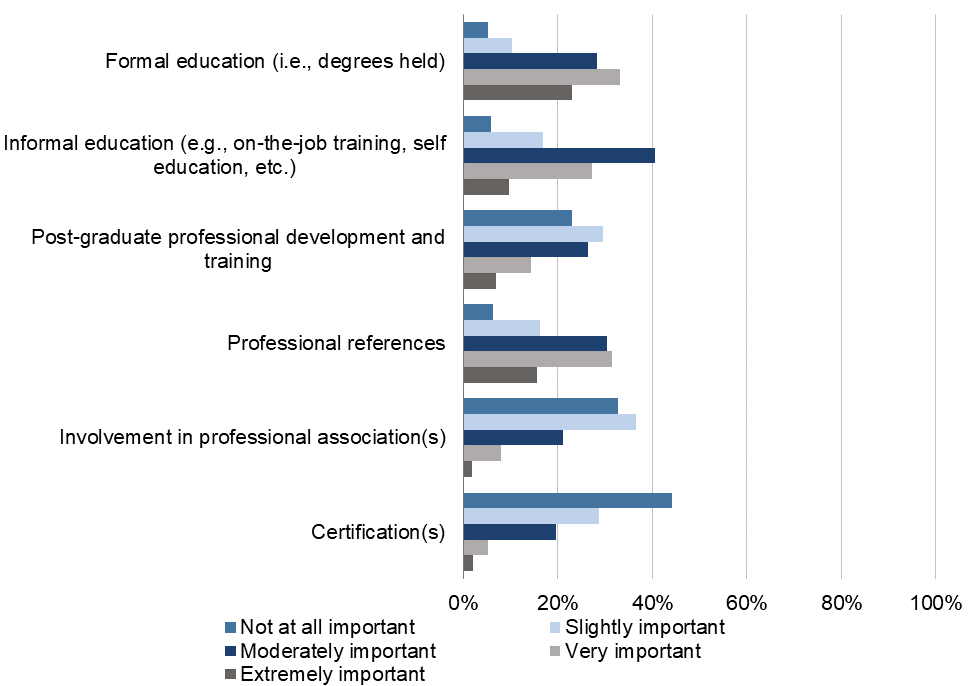
| Not at all important | Moderately important | Extremely important | ||||
| Answer | Frequency | Percentage | Frequency | Percentage | Frequency | Percentage |
| Formal education (i.e., degrees held) | 30 | 5.21% | 163 | 28.30% | 133 | 23.09% |
| Informal education (e.g., on-the-job training, self education, etc.) | 33 | 5.75% | 233 | 40.59% | 55 | 9.58% |
| Post-graduate professional development and training | 131 | 22.98% | 150 | 26.32% | 39 | 6.84% |
| Professional references | 36 | 6.30% | 173 | 30.30% | 89 | 15.59% |
| Involvement in professional association(s) | 187 | 32.75% | 120 | 21.02% | 10 | 1.75% |
| Certification(s) | 252 | 44.21% | 112 | 19.65% | 12 | 2.11% |
Figure 116 - Q51 Continued
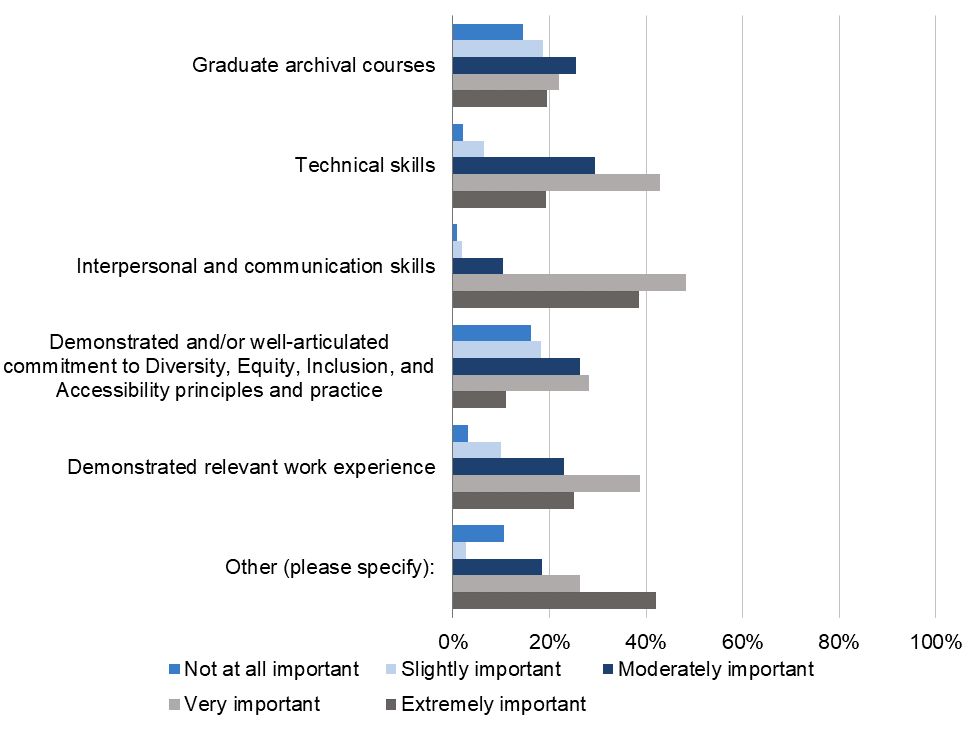
| Not at all important | Moderately important | Extremely important | ||||
| Answer | Frequency | Percentage | Frequency | Percentage | Frequency | Percentage |
| Graduate archival courses | 83 | 14.54% | 145 | 25.39% | 111 | 19.44% |
| Technical skills | 12 | 2.08% | 170 | 29.46% | 111 | 19.24% |
| Interpersonal and communication skills | 5 | 0.87% | 60 | 10.45% | 221 | 38.50% |
| Demonstrated and/or well-articulated commitment to Diversity, Equity, Inclusion, and Accessibility principles and practice | 92 | 16.25% | 149 | 26.33% | 62 | 10.95% |
| Demonstrated relevant work experience | 18 | 3.12% | 133 | 23.05% | 145 | 25.13% |
| Other (please specify): | 4 | 10.53% | 7 | 18.42% | 16 | 42.11% |
Figure 117 - When hiring for a mid-level or senior position, how important is it that candidates have the following qualifications? If your department does not hire for mid-level or senior positions, you may leave the question blank. (Q52)
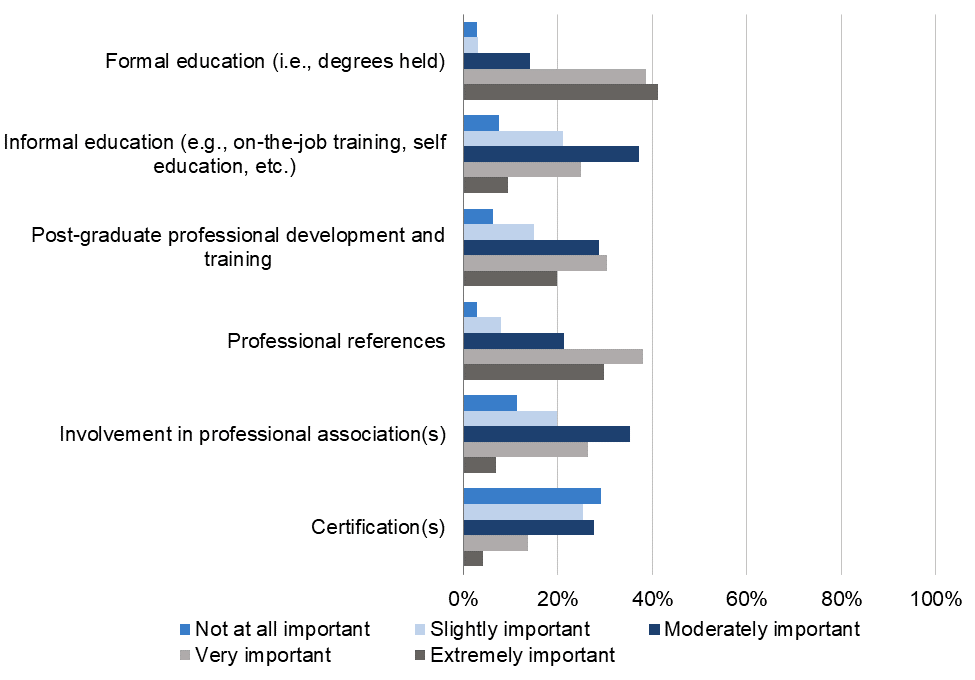
| Not at all important | Moderately important | Extremely important | ||||
| Answer | Frequency | Percentage | Frequency | Percentage | Frequency | Percentage |
| Formal education (i.e., degrees held) | 16 | 2.95% | 76 | 14.00% | 224 | 41.25% |
| Informal education (e.g., self education, volunteer experience etc.) | 41 | 7.54% | 202 | 37.13% | 51 | 9.38% |
| Post-graduate professional development and training | 34 | 6.27% | 155 | 28.60% | 107 | 19.74% |
| Professional references | 16 | 2.94% | 116 | 21.32% | 162 | 29.78% |
| Involvement in professional association(s) | 62 | 11.40% | 192 | 35.29% | 38 | 6.99% |
| Certification(s) | 157 | 29.18% | 149 | 27.70% | 22 | 4.09% |
Figure 118 - Q52 Continued
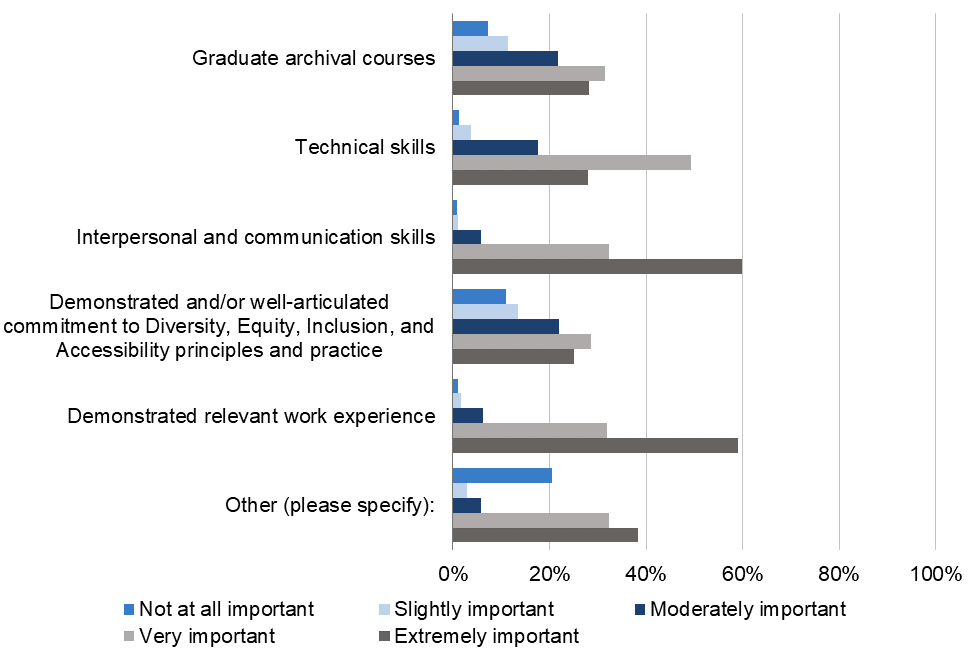
| Not at all important | Moderately important | Extremely important | ||||
| Answer | Frequency | Percentage | Frequency | Percentage | Frequency | Percentage |
| Graduate archival courses | 39 | 7.21% | 118 | 21.81% | 152 | 28.10% |
| Technical skills | 7 | 1.29% | 96 | 17.68% | 152 | 27.99% |
| Interpersonal and communication skills | 5 | 0.92% | 32 | 5.87% | 326 | 59.82% |
| Demonstrated and/or well-articulated commitment to Diversity, Equity, Inclusion, and Accessibility principles and practice | 59 | 10.89% | 119 | 21.96% | 136 | 25.09% |
| Demonstrated relevant work experience | 6 | 1.10% | 34 | 6.26% | 321 | 59.12% |
| Other (please specify): | 7 | 20.59% | 2 | 5.88% | 13 | 38.24% |
Figure 119 - What are the most significant challenges facing your department? Please select up to five options. (Q53)
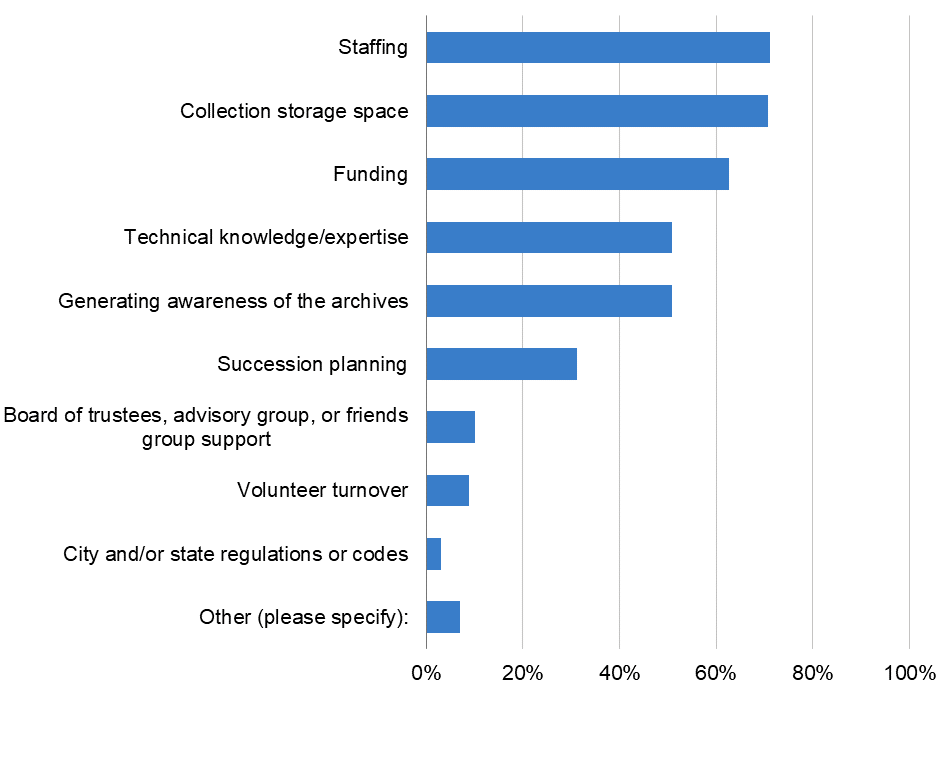
| Answer | Frequency | Percentage |
| Staffing | 526 | 71.08% |
| Collection storage space | 524 | 70.81% |
| Funding | 463 | 62.57% |
| Technical knowledge/expertise | 377 | 50.95% |
| Generating awareness of the archives | 376 | 50.81% |
| Succession planning | 231 | 31.22% |
| Board of trustees, advisory group, or friends group support | 74 | 10.00% |
| Volunteer turnover | 65 | 8.78% |
| City and/or state regulations or codes | 22 | 2.97% |
| Other (please specify): | 52 | 7.03% |
Figure 120 - Please read the following statements and indicate the extent to which you agree or disagree. (Q54)

| Strongly disagree | Neither agree nor disagree | Strongly agree | ||||
| Answer | Frequency | Percentage | Frequency | Percentage | Frequency | Percentage |
| Community archives are valued in the archives field | 0 | 0.00% | 23 | 17.04% | 19 | 14.07% |
| Community archives are visible in the archives field | 1 | 0.74% | 24 | 17.78% | 15 | 11.11% |
| Community archives are sustainable in the archives field | 1 | 0.75% | 31 | 23.13% | 21 | 15.67% |
Figure 121 - In what year was your department established? If your department has multiple repositories founded in different years, please enter the year the earliest repository was established. If you do not know the year your department was established, leave the box below blank. (Q56)
| Answer | Min Answer | Max Answer | Median Answer | Count |
| Year | 1822 | 2021 | 1977 | 613 |
Figure 122 - For how many years have you been a senior administrator in your department? (Q58)
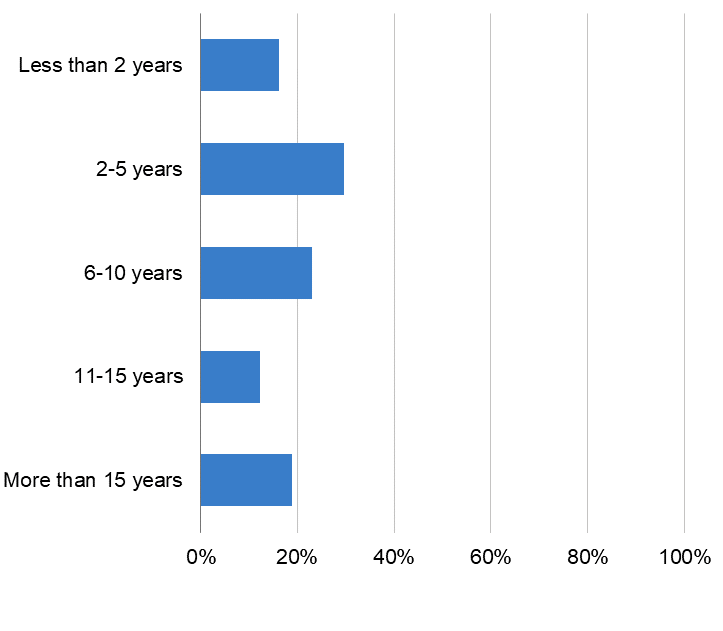
| Answer | Frequency | Percentage |
| Less than 2 years | 117 | 16.12% |
| 2-5 years | 215 | 29.61% |
| 6-10 years | 168 | 23.14% |
| 11-15 years | 89 | 12.26% |
| More than 15 years | 137 | 18.87% |
Figure 123 - How many total years of experience do you have working in the archives field or working with archival material? (Q59)
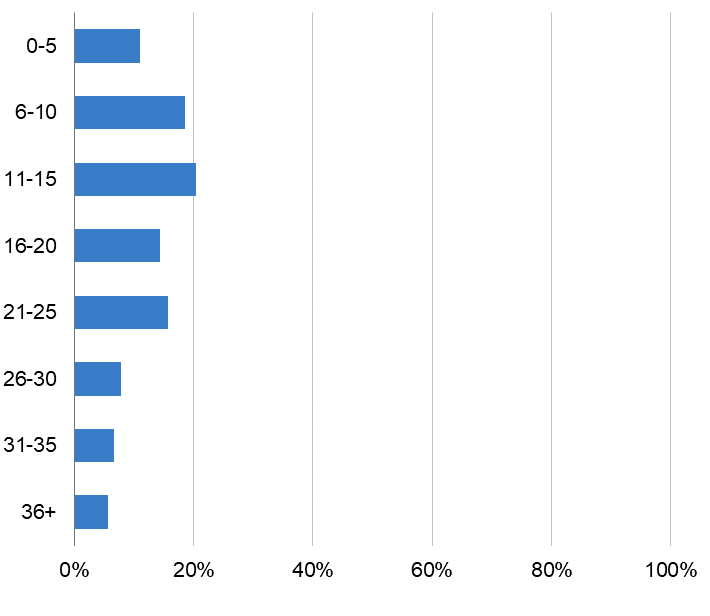
| Answer | Frequency | Percentage |
| 0-5 | 80 | 10.99% |
| 6-10 | 135 | 18.54% |
| 11-15 | 149 | 20.47% |
| 16-20 | 104 | 14.29% |
| 21-25 | 114 | 15.66% |
| 26-30 | 57 | 7.83% |
| 31-35 | 48 | 6.59% |
| 36+ | 41 | 5.63% |
Figure 124 - Please indicate ALL of the degrees you hold. Please select all that apply. (Q60)
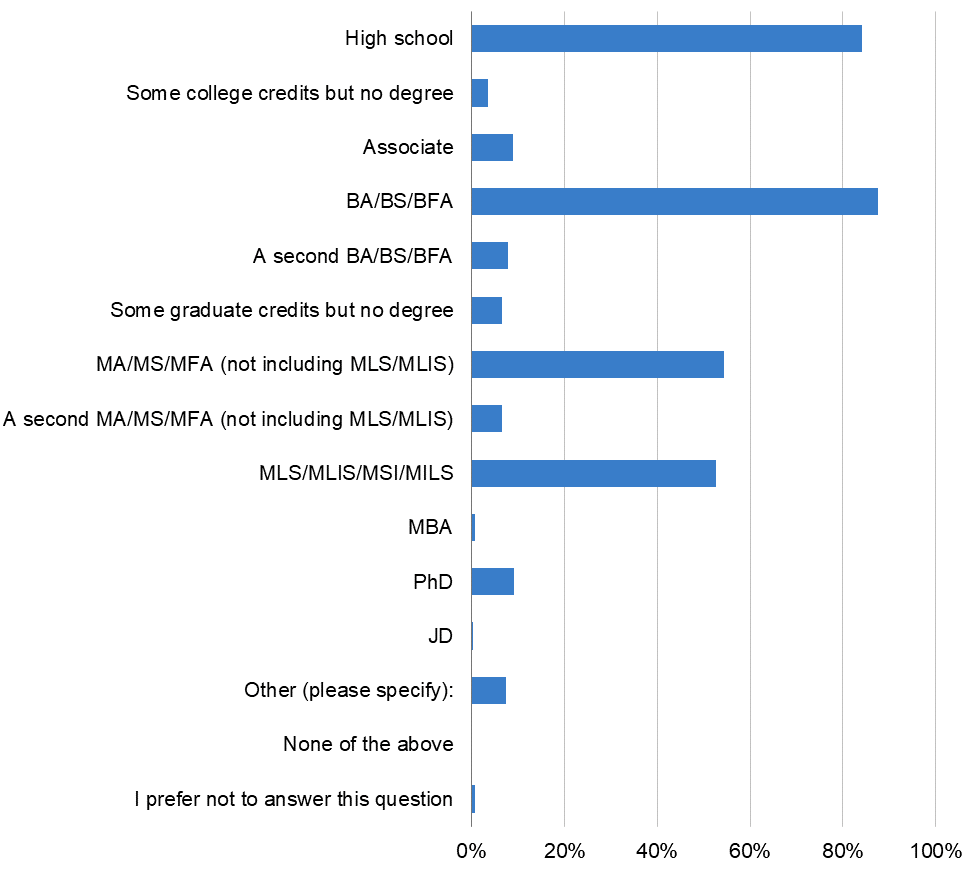
| Answer | Frequency | Percentage |
| High school | 618 | 84.08% |
| Some college credits but no degree | 26 | 3.54% |
| Associate | 66 | 8.98% |
| BA/BS/BFA | 644 | 87.62% |
| A second BA/BS/BFA | 58 | 7.89% |
| Some graduate credits but no degree | 48 | 6.53% |
| MA/MS/MFA (not including MLS/MLIS) | 399 | 54.29% |
| A second MA/MS/MFA (not including MLS/MLIS) | 48 | 6.53% |
| MLS/MLIS/MSI/MILS | 387 | 52.65% |
| MBA | 5 | 0.68% |
| PhD | 67 | 9.12% |
| JD | 2 | 0.27% |
| Other (please specify): | 55 | 7.48% |
| None of the above | 0 | 0.00% |
| I prefer not to answer this question | 5 | 0.68% |
Figure 125 - What is your age? (Q61)
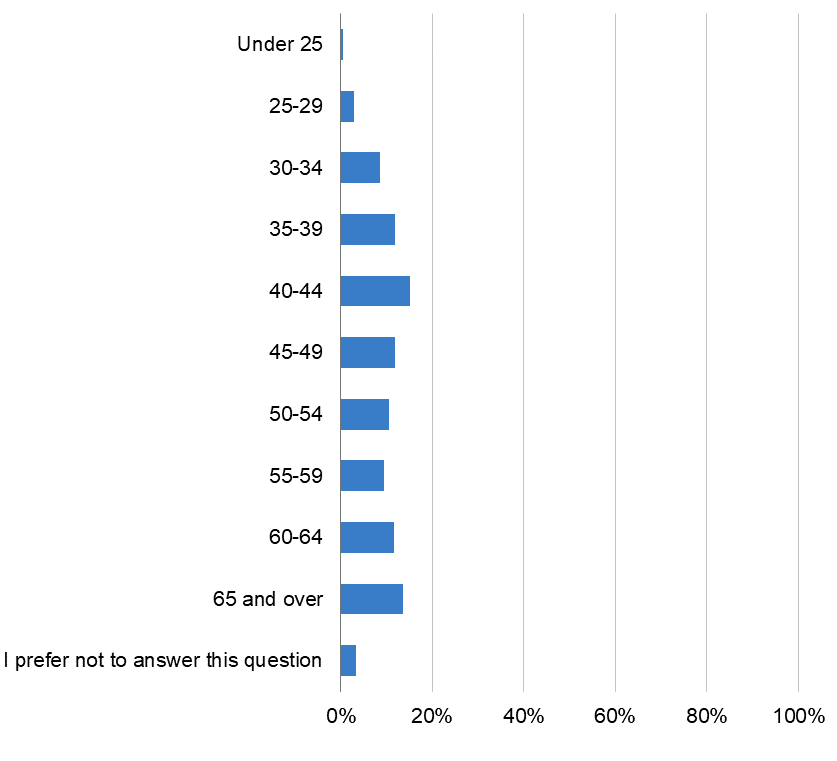
| Answer | Frequency | Percentage |
| Under 25 | 4 | 0.55% |
| 25-29 | 22 | 3.02% |
| 30-34 | 63 | 8.64% |
| 35-39 | 87 | 11.93% |
| 40-44 | 111 | 15.23% |
| 45-49 | 87 | 11.93% |
| 50-54 | 77 | 10.56% |
| 55-59 | 69 | 9.47% |
| 60-64 | 85 | 11.66% |
| 65 and over | 99 | 13.58% |
| I prefer not to answer this question | 25 | 3.43% |
Figure 126 - Please indicate your gender(s). Select all that apply. (Q62)
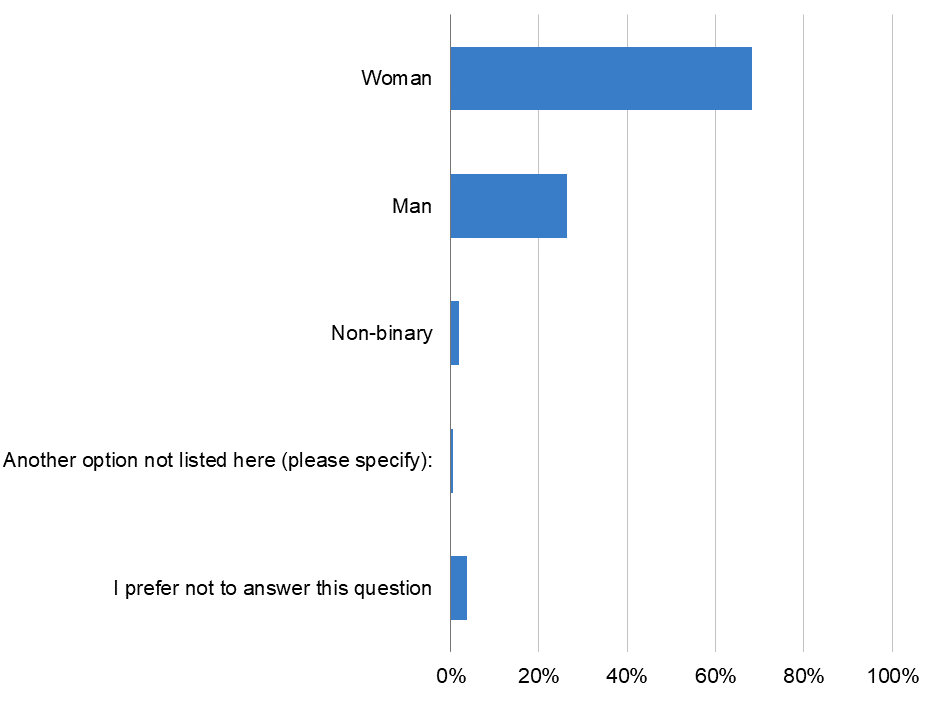
| Answer | Frequency | Percentage |
| Woman | 498 | 68.22% |
| Man | 193 | 26.44% |
| Non-binary | 13 | 1.78% |
| Another option not listed here (please specify): | 4 | 0.55% |
| I prefer not to answer this question | 27 | 3.70% |
Figure 127 - Please indicate your race-ethnicity(ies). Select all that apply. (Q63)
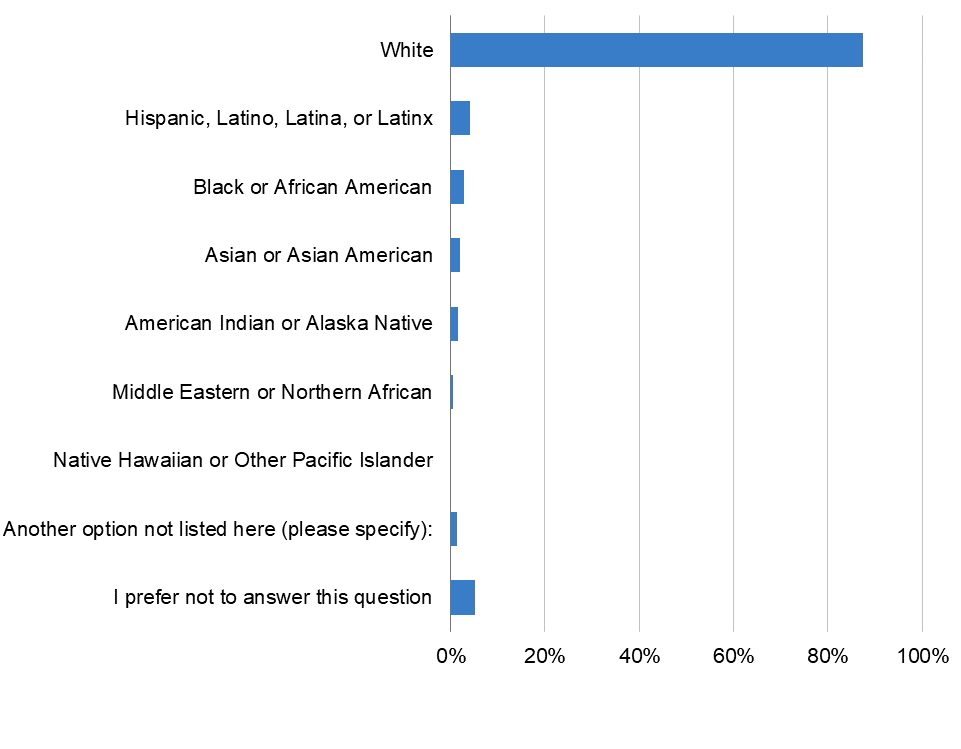
| Answer | Frequency | Percentage |
| White | 637 | 87.50% |
| Hispanic, Latino, Latina, or Latinx | 30 | 4.12% |
| Black or African American | 20 | 2.75% |
| Asian or Asian American | 14 | 1.92% |
| American Indian or Alaska Native | 11 | 1.51% |
| Middle Eastern or Northern African | 4 | 0.55% |
| Native Hawaiian or Other Pacific Islander | 0 | 0.00% |
| Another option not listed here (please specify): | 10 | 1.37% |
| I prefer not to answer this question | 38 | 5.22% |
Figure 128 - Please indicate your sexual orientation(s). Select all that apply. (Q64)
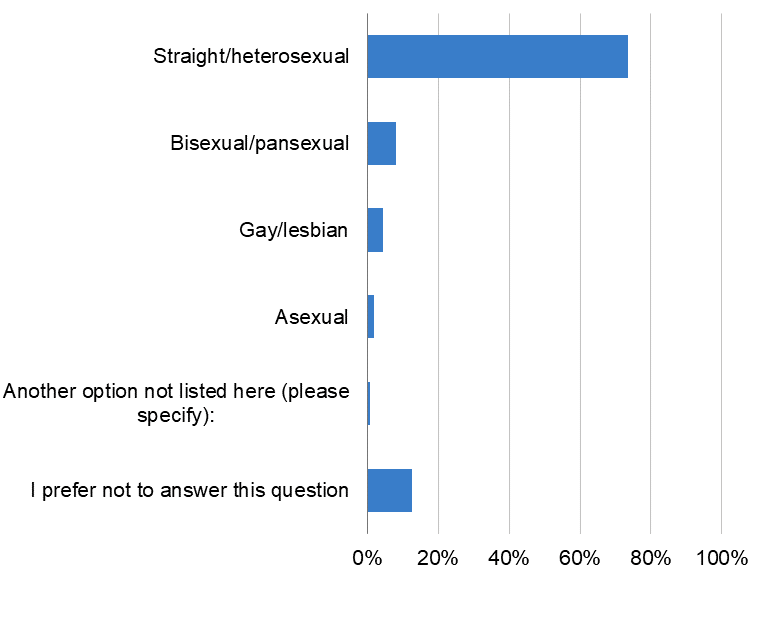
| Answer | Frequency | Percentage |
| Straight/heterosexual | 529 | 73.57% |
| Bisexual/pansexual | 58 | 8.07% |
| Gay/lesbian | 31 | 4.31% |
| Asexual | 13 | 1.81% |
| Another option not listed here (please specify): | 6 | 0.83% |
| I prefer not to answer this question | 90 | 12.52% |
Figure 129 - Are you transgender? (Q65)
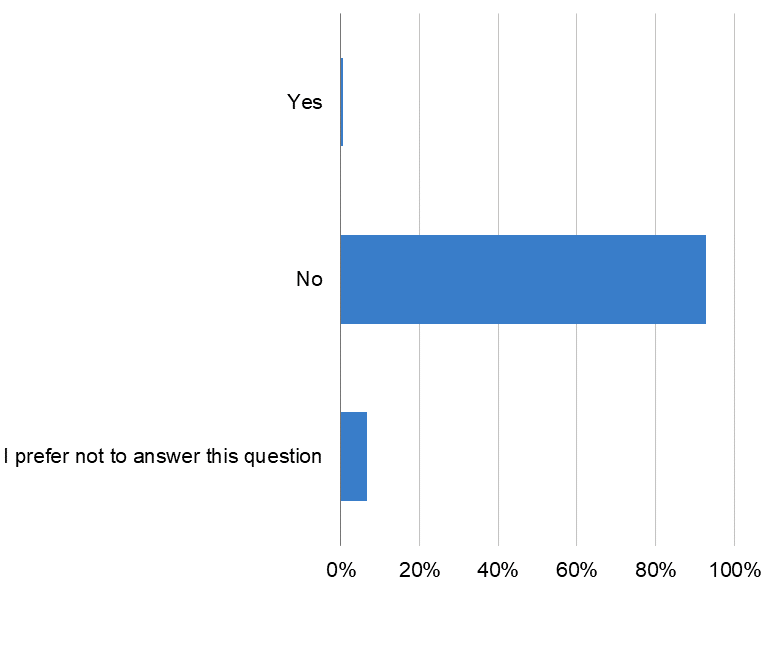
| Answer | Frequency | Percentage |
| Yes | 4 | 0.55% |
| No | 673 | 92.83% |
| I prefer not to answer this question | 48 | 6.62% |
Figure 130 - Do you have a disability, including but not limited to physical, psychological, developmental, and sensory disabilities? (Q66)
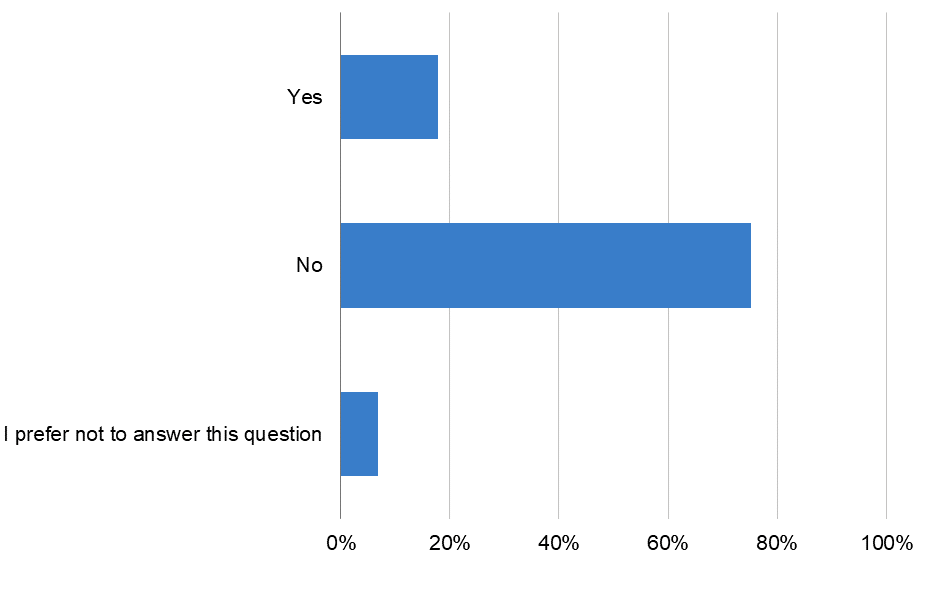
| Answer | Frequency | Percentage |
| Yes | 130 | 17.91% |
| No | 546 | 75.21% |
| I prefer not to answer this question | 50 | 6.89% |
Figure 131 - Do you have substantial care-giving responsibilities for other people in your household (e.g., parents, children)? (Q67)
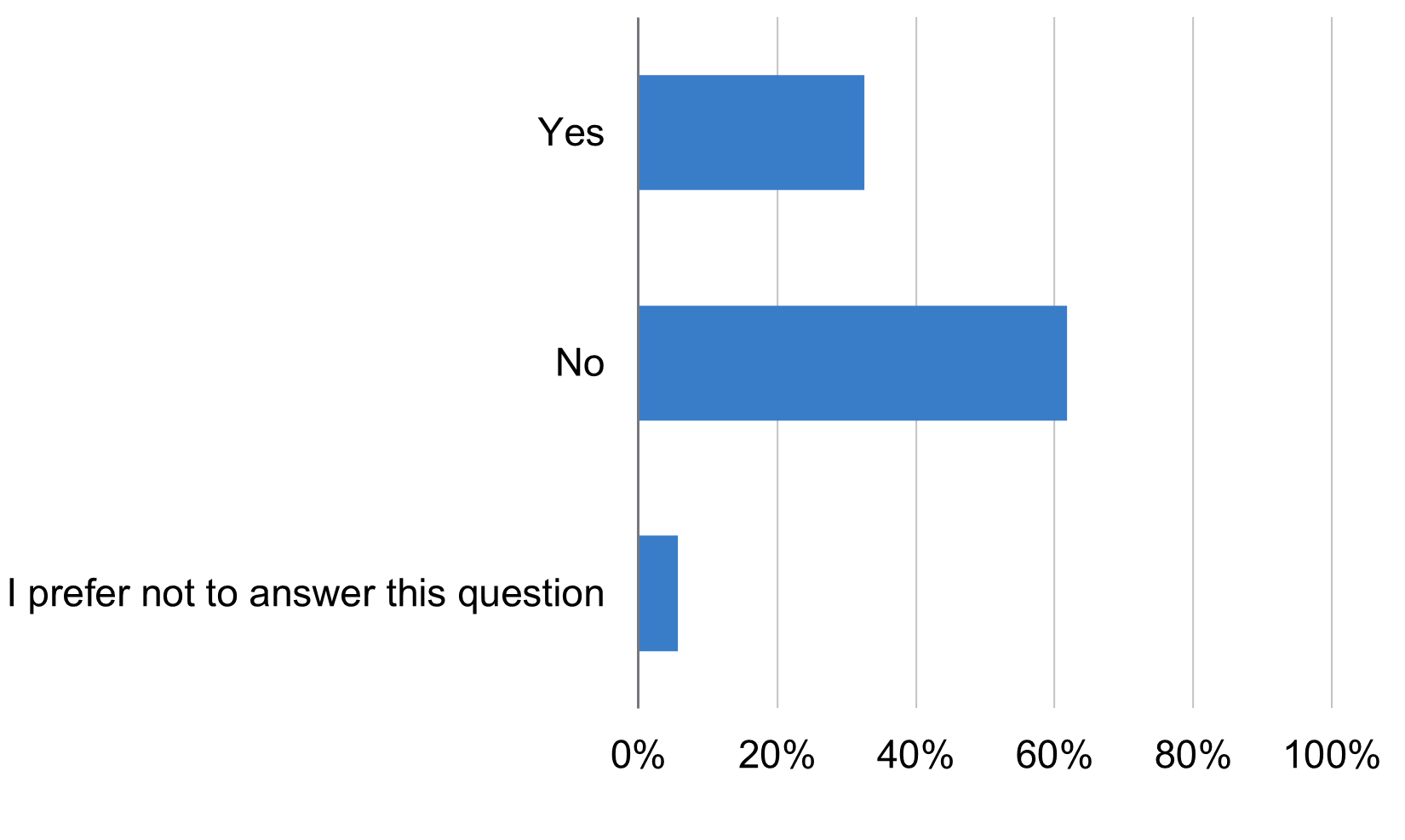
| Answer | Frequency | Percentage |
| Yes | 236 | 32.51% |
| No | 449 | 61.85% |
| I prefer not to answer this question | 41 | 5.65% |
-
Makala Skinner and Ioana G. Hulbert, “A*CENSUS II All Archivists Survey Report,” Ithaka S+R, 22 August 2022, https://doi.org/10.18665/sr.317224.